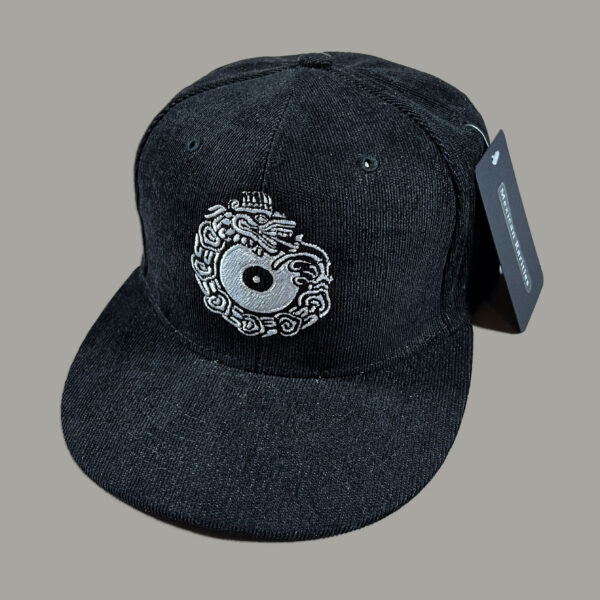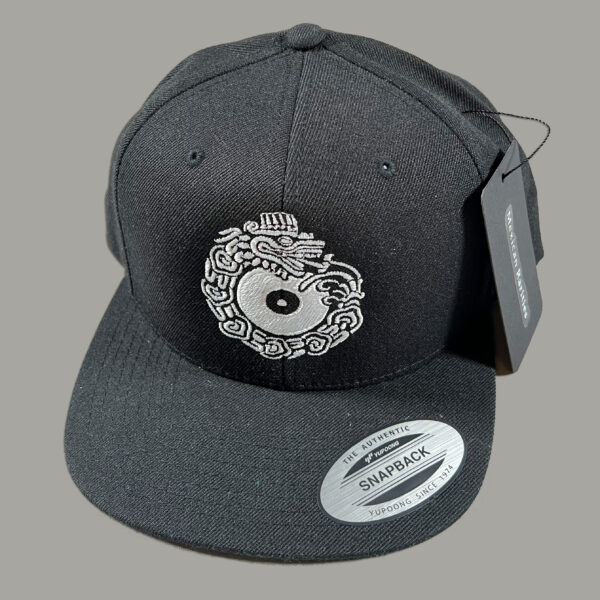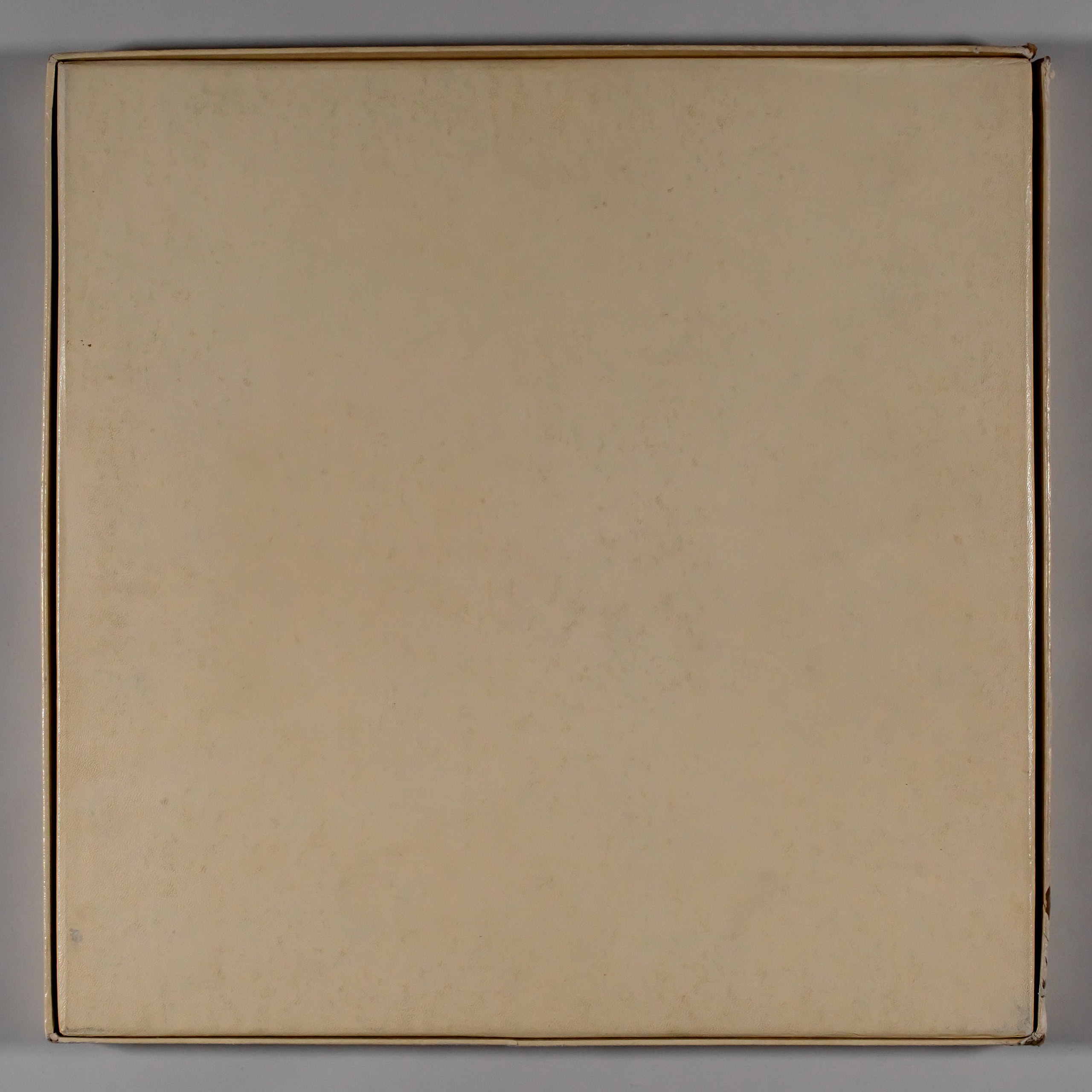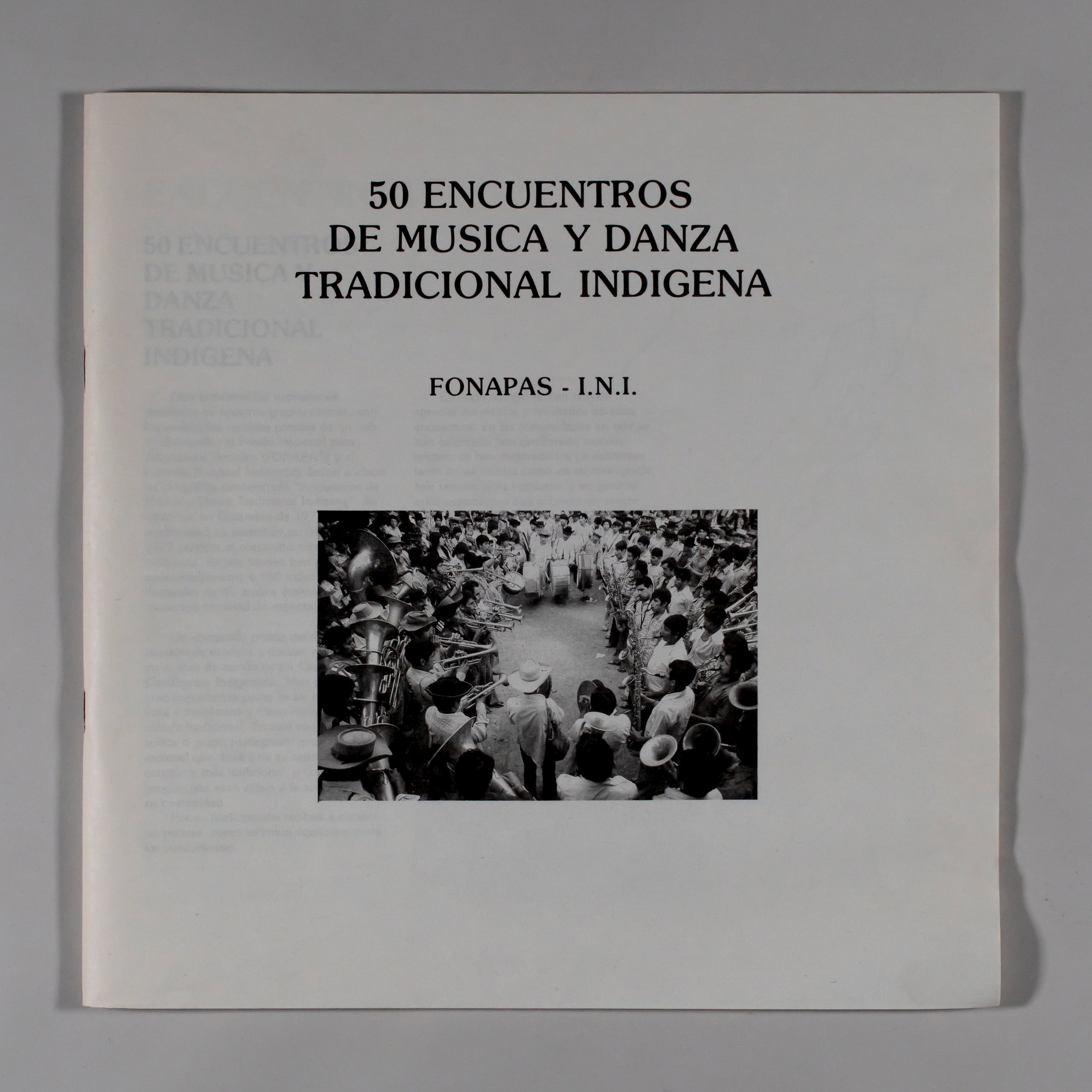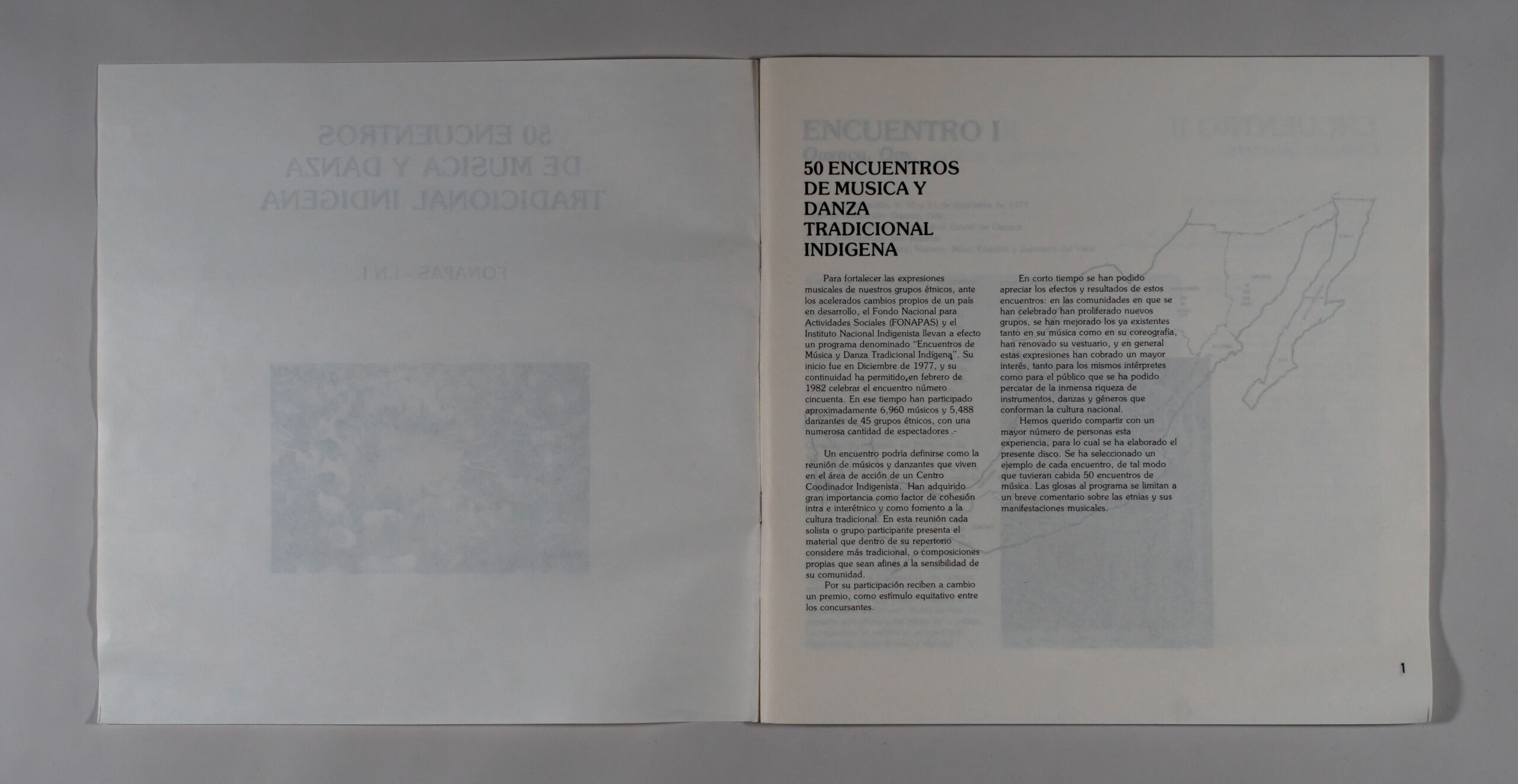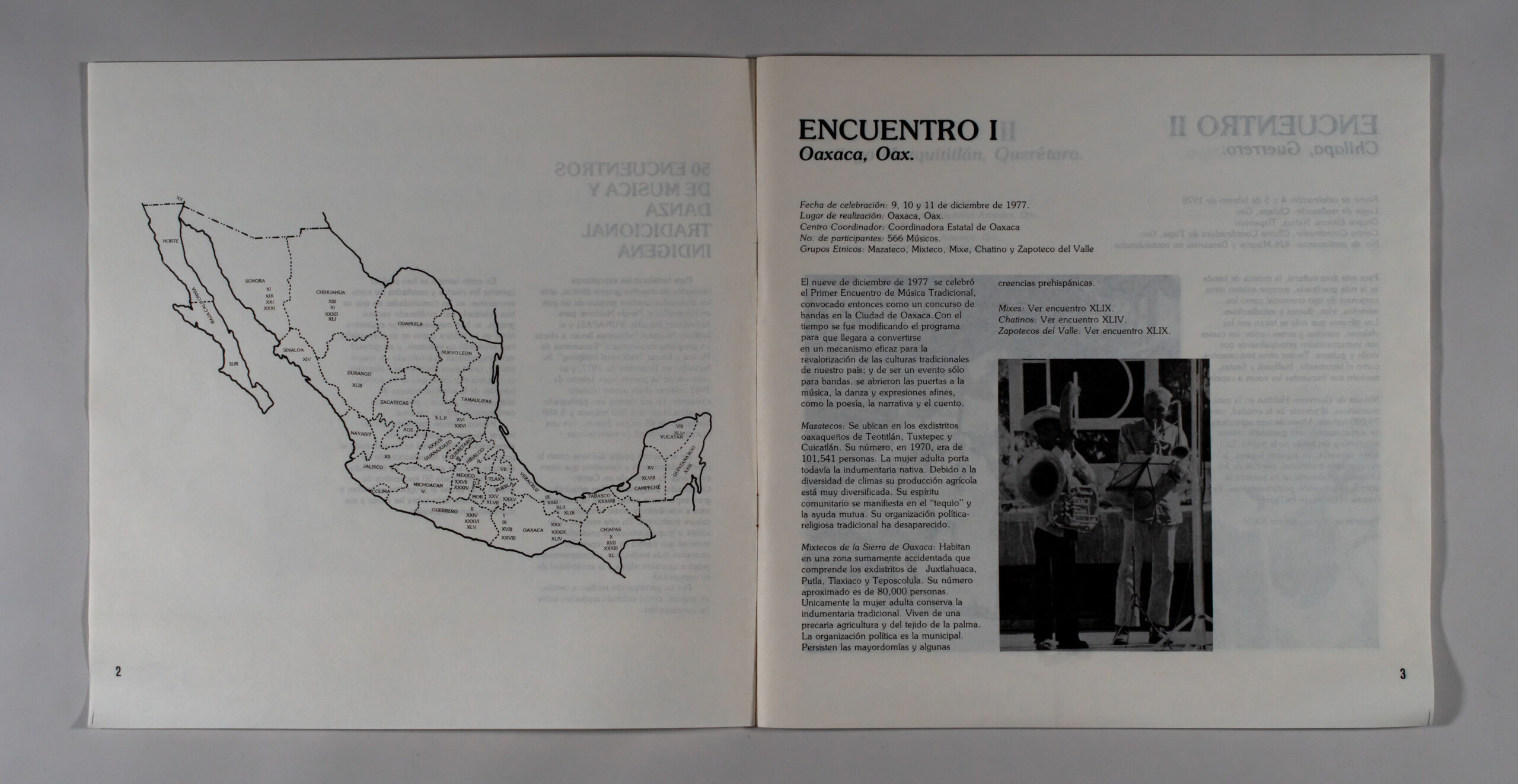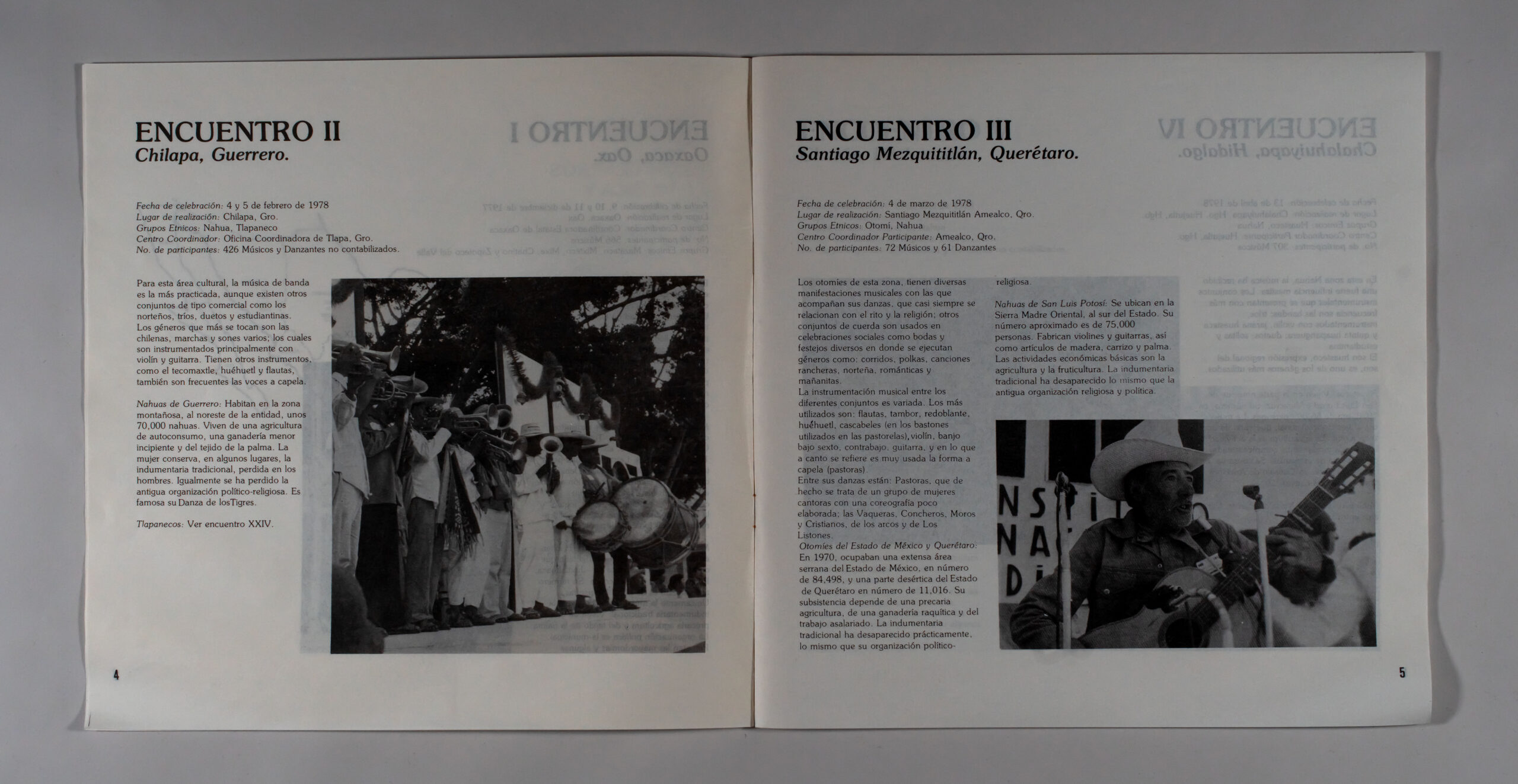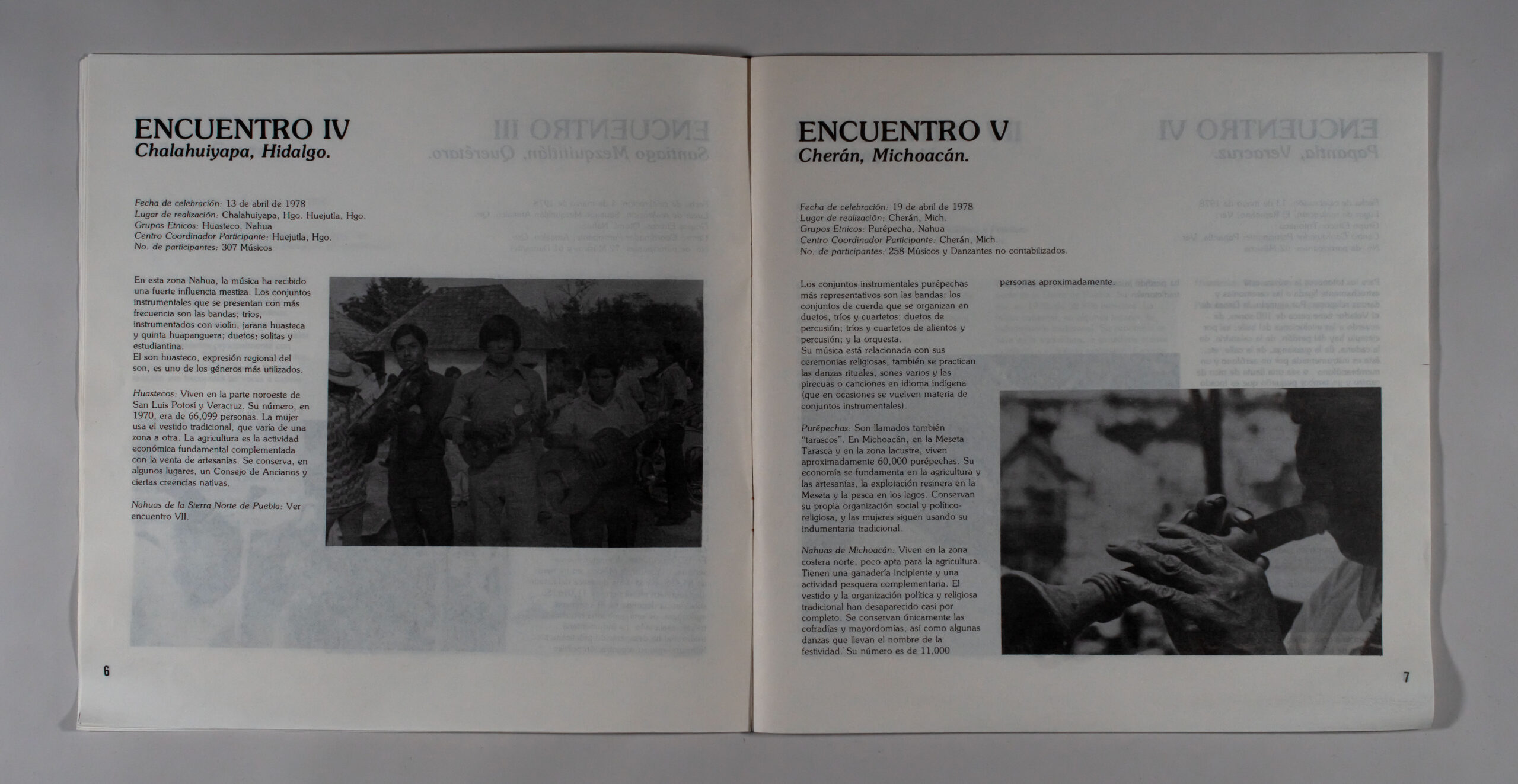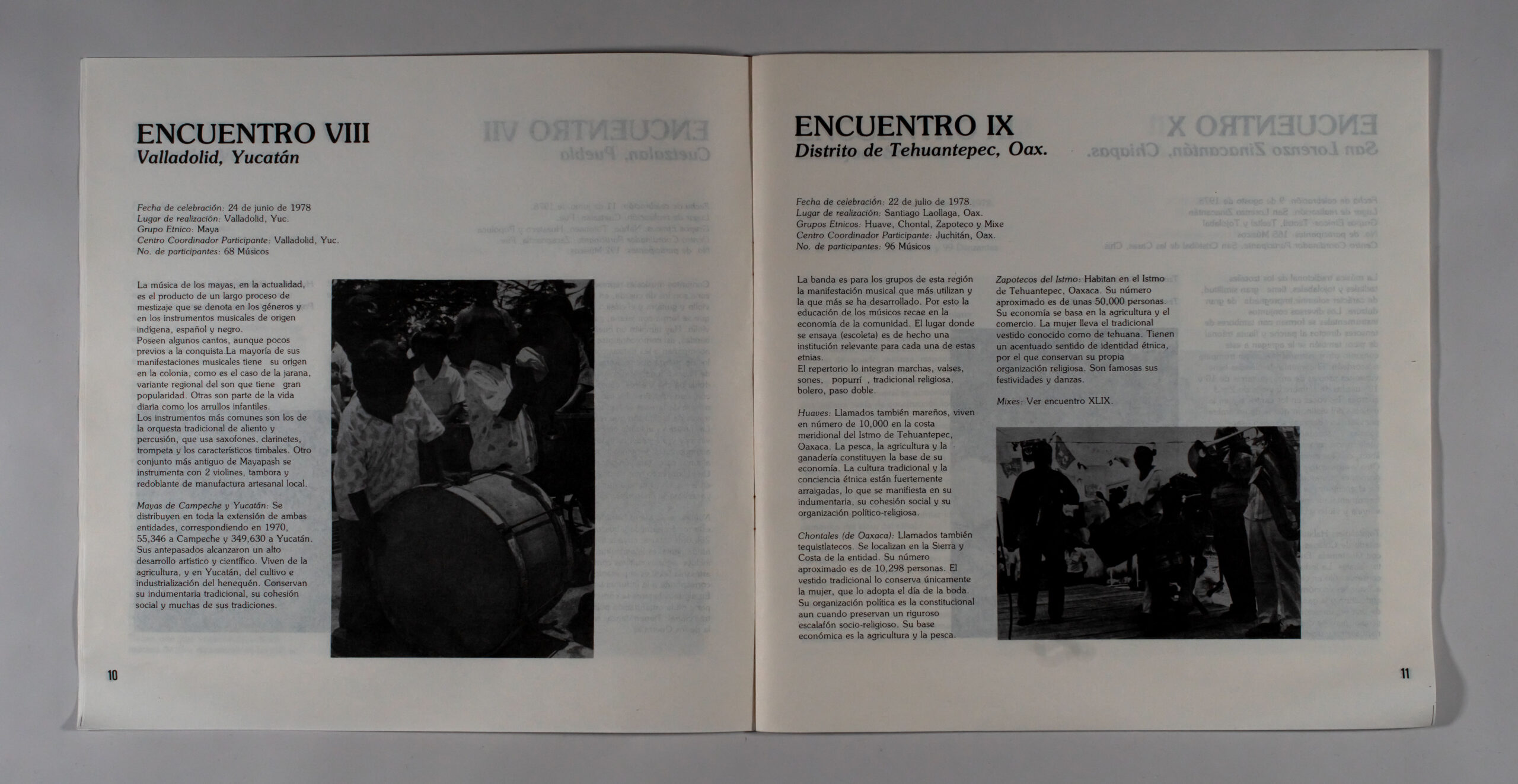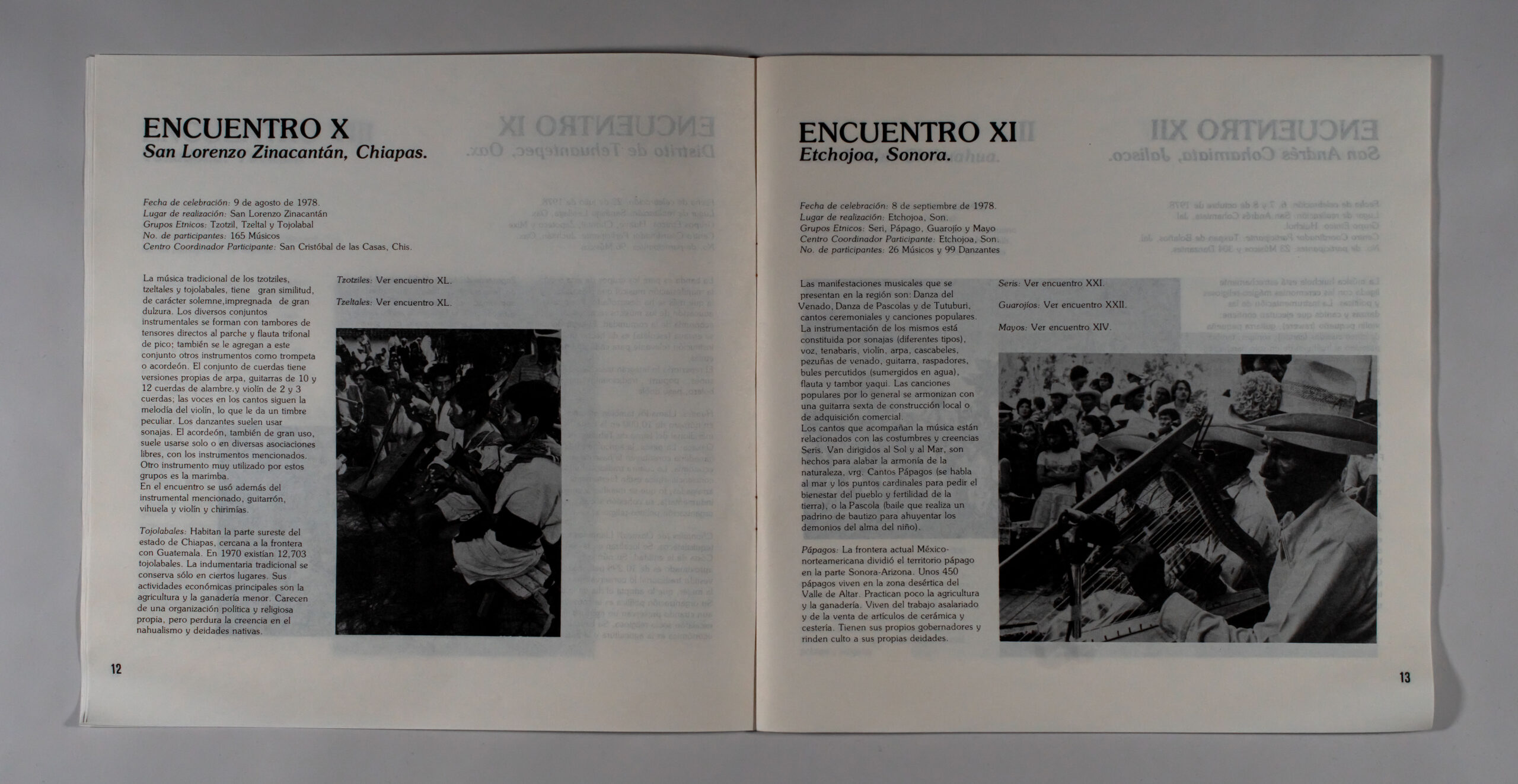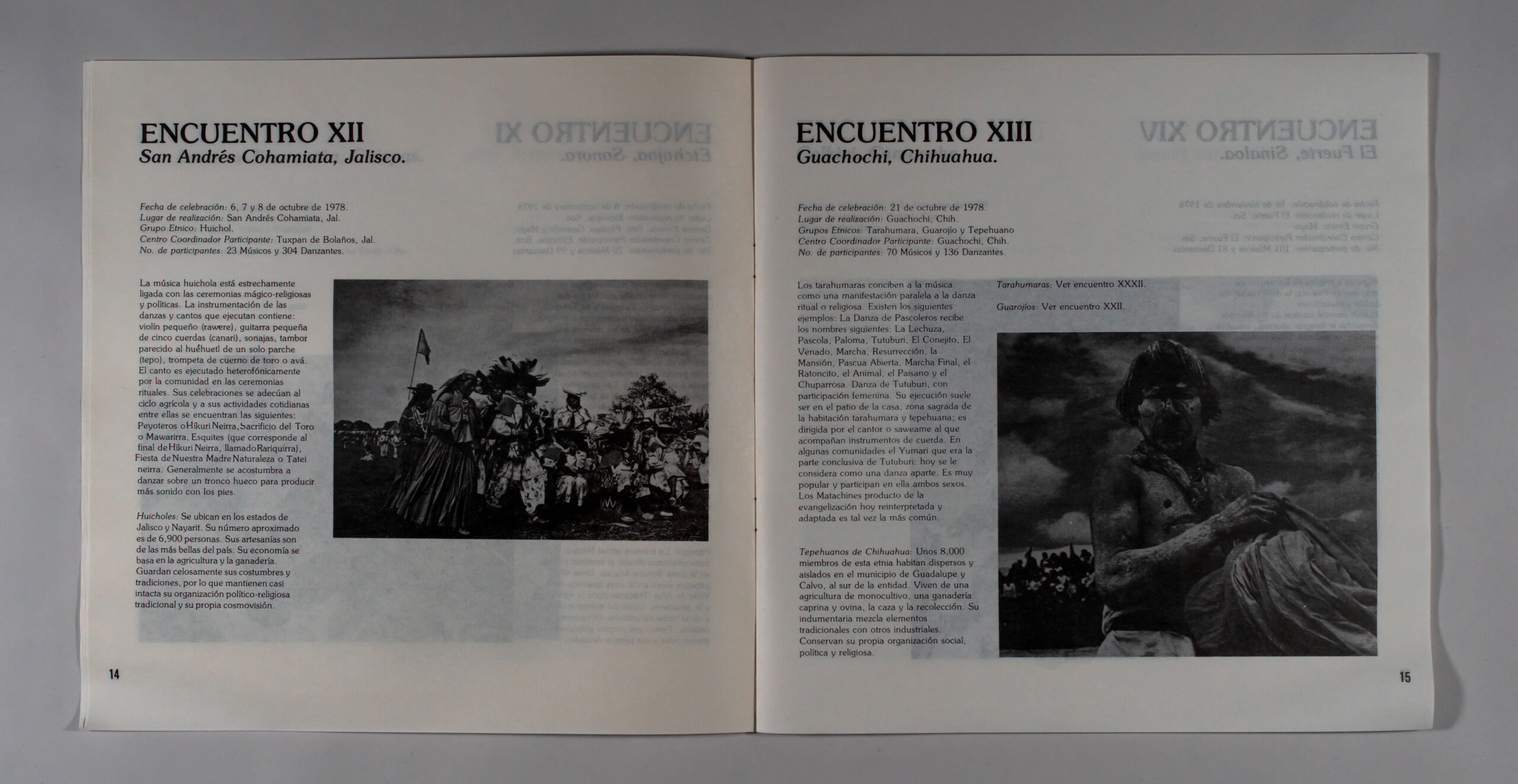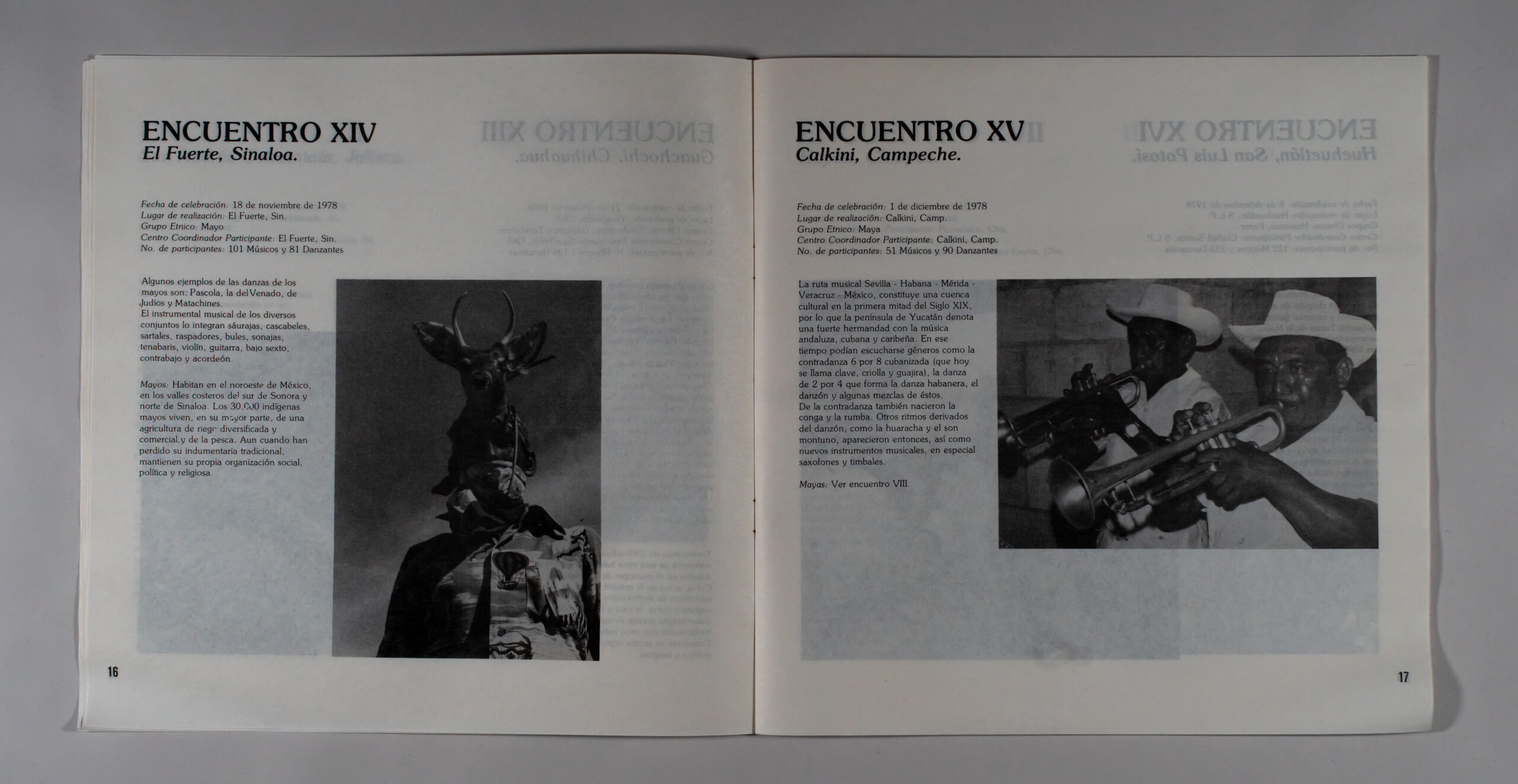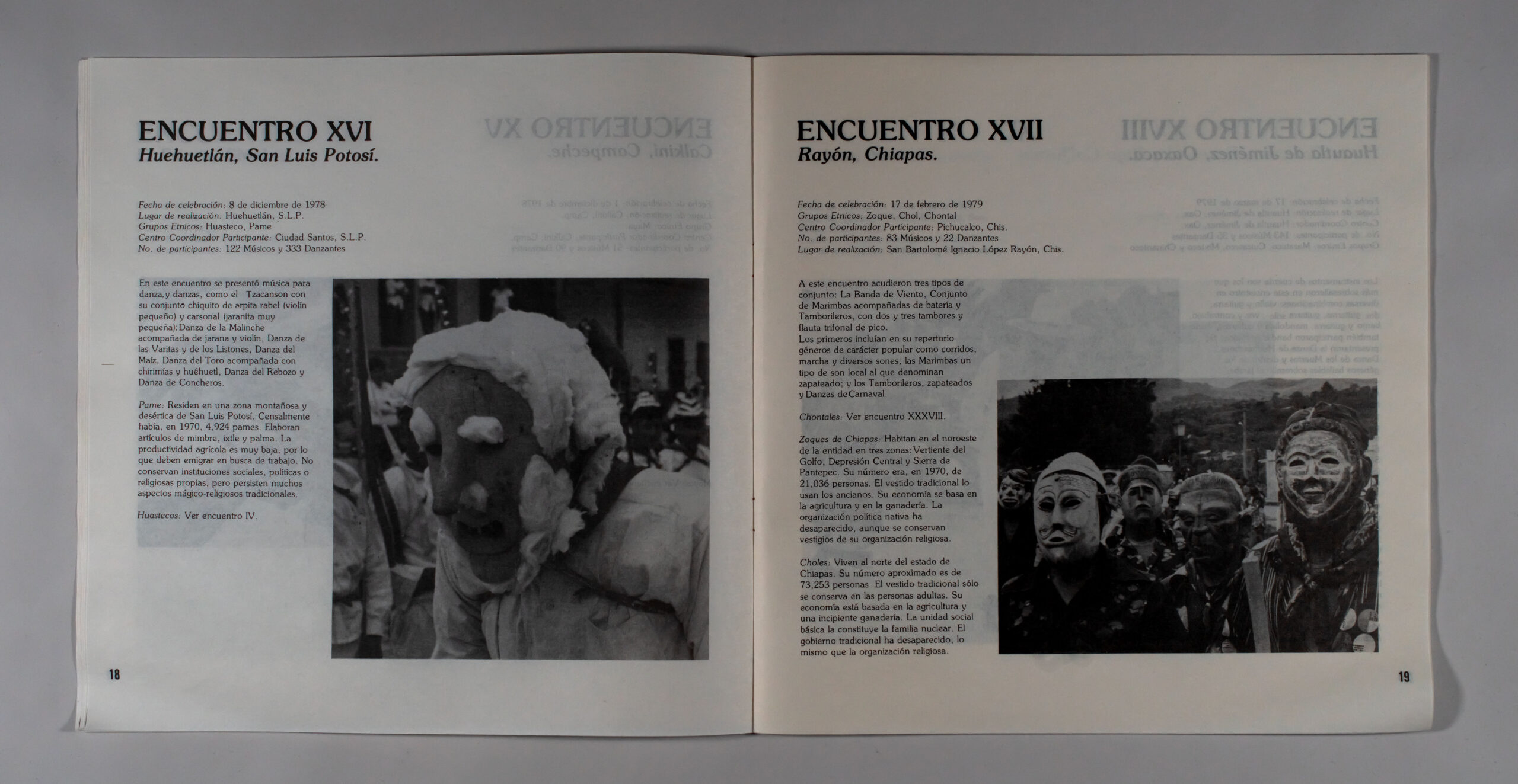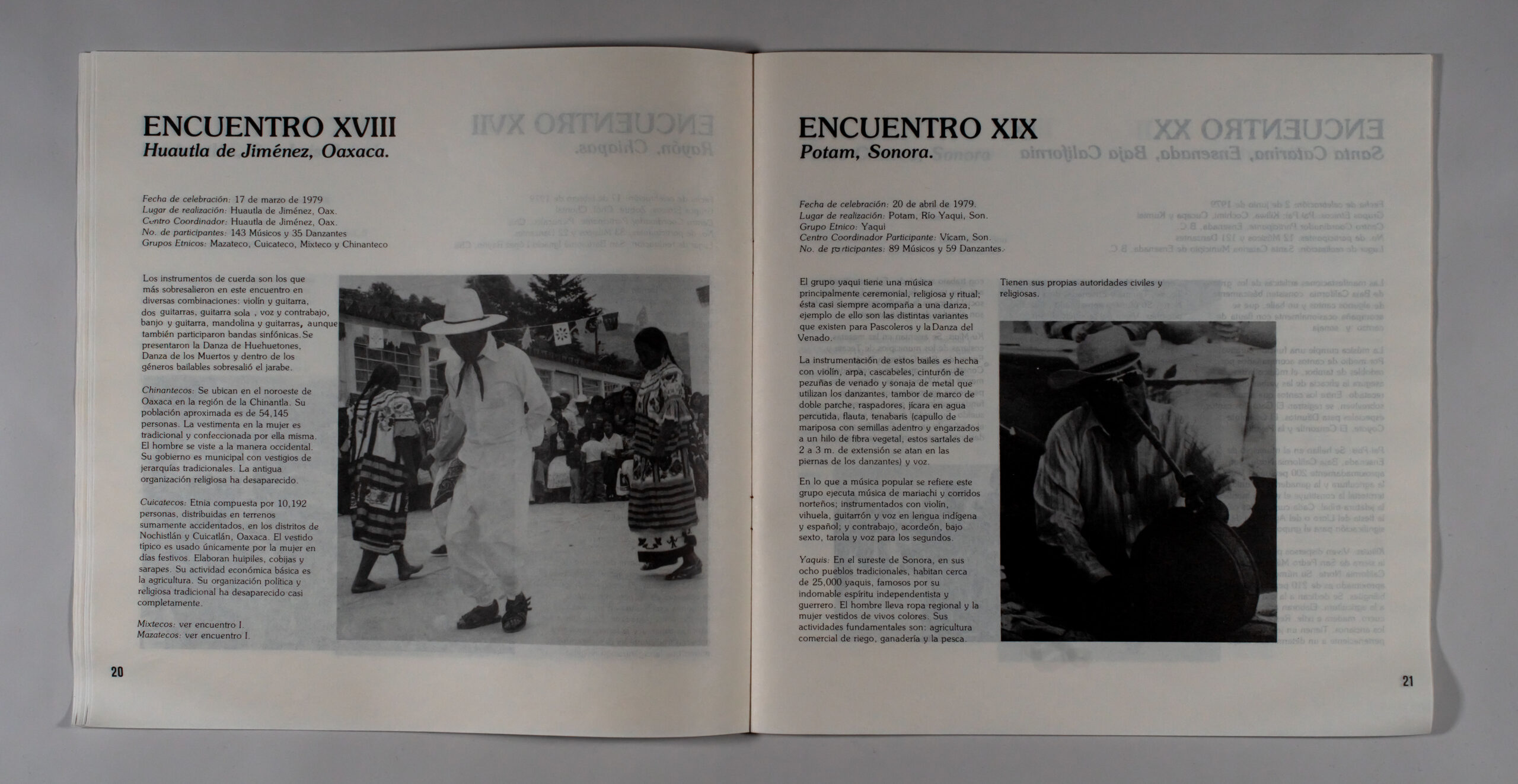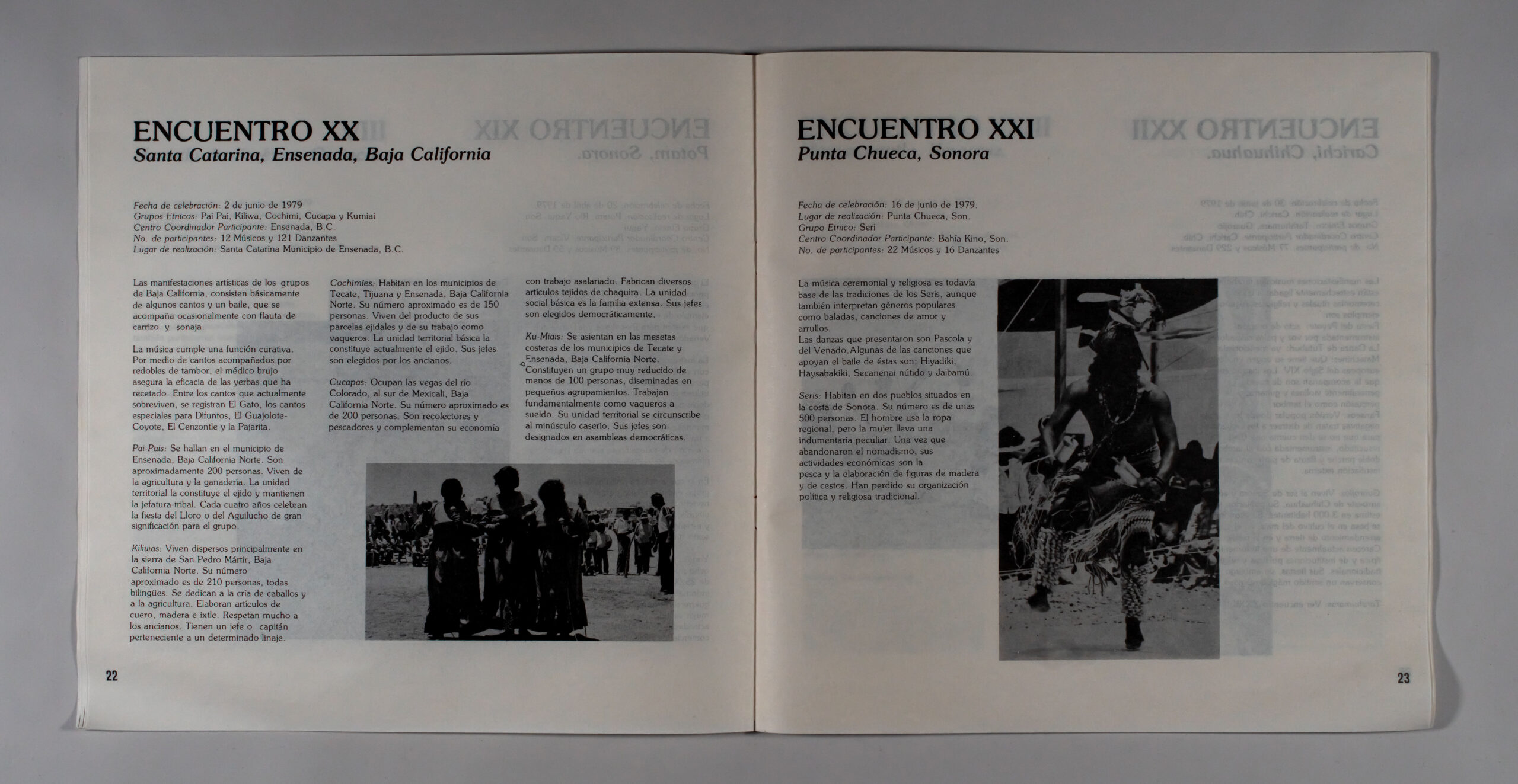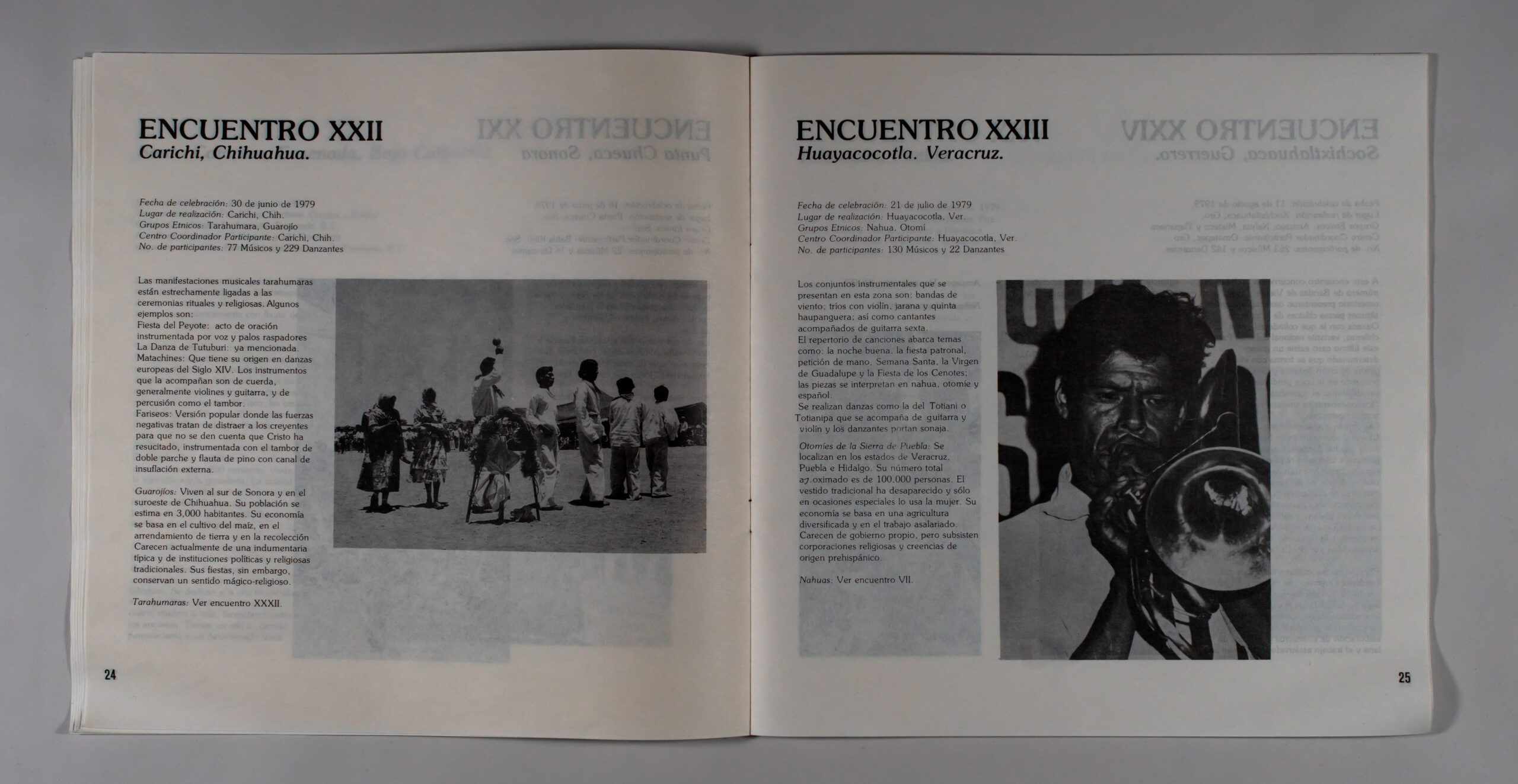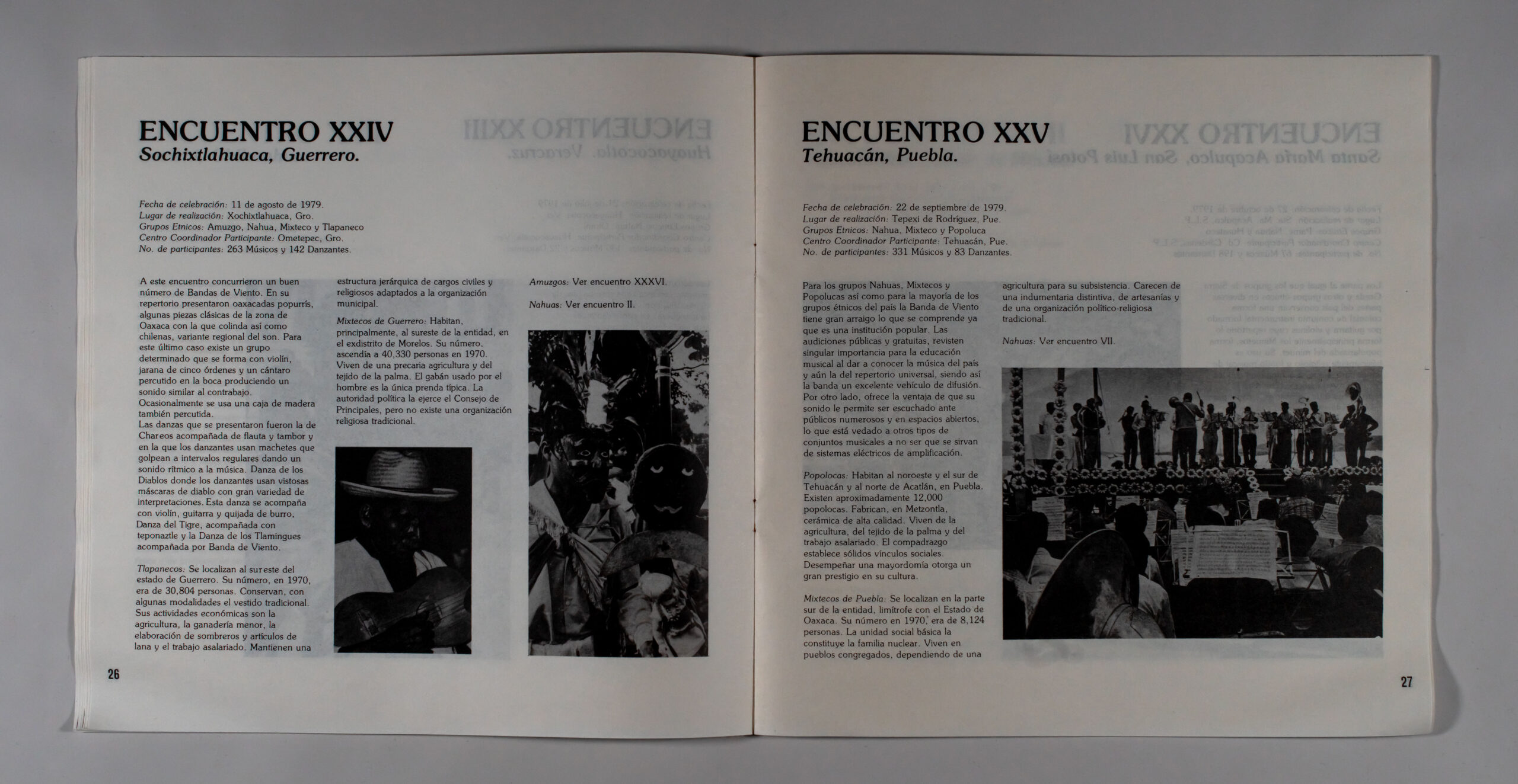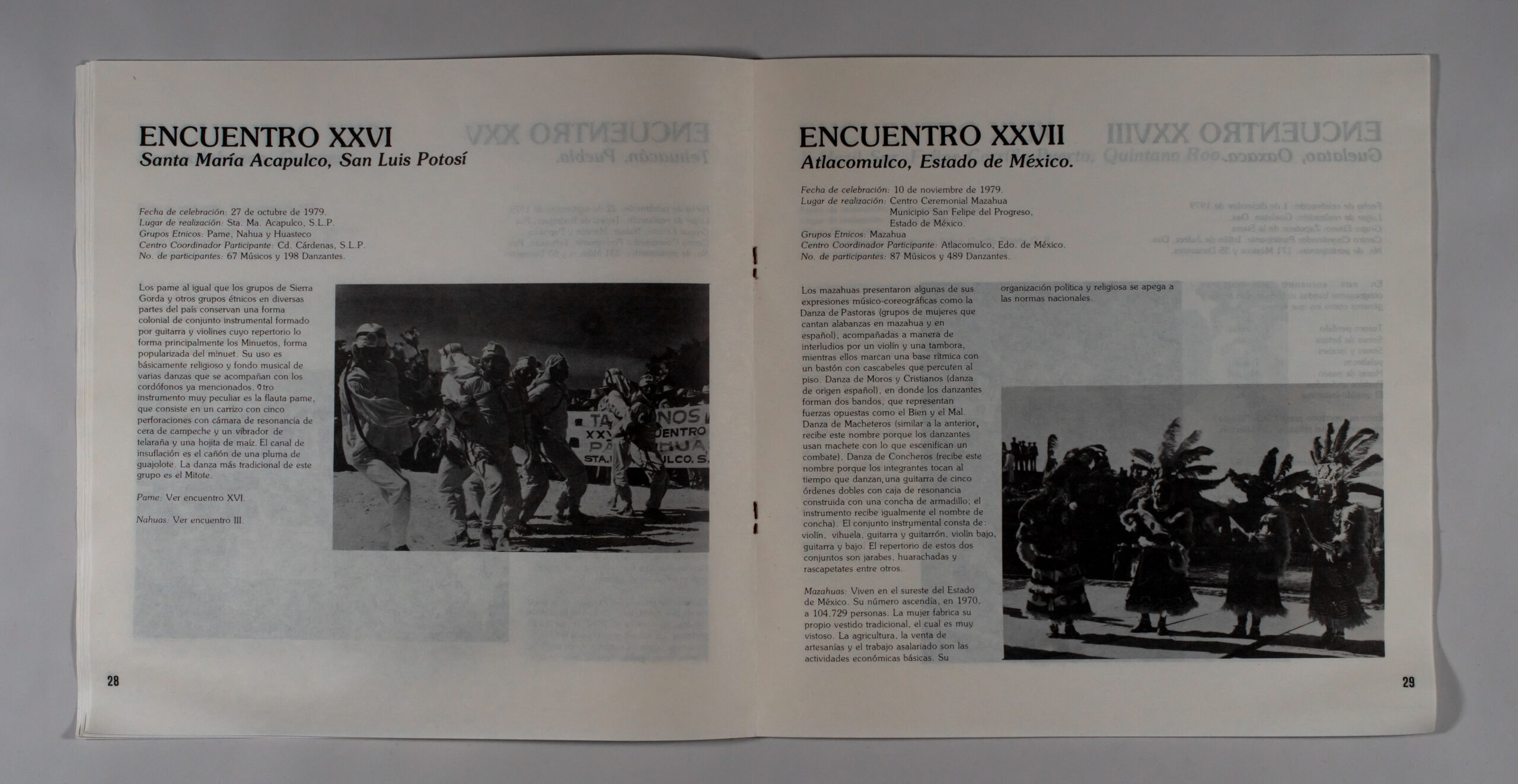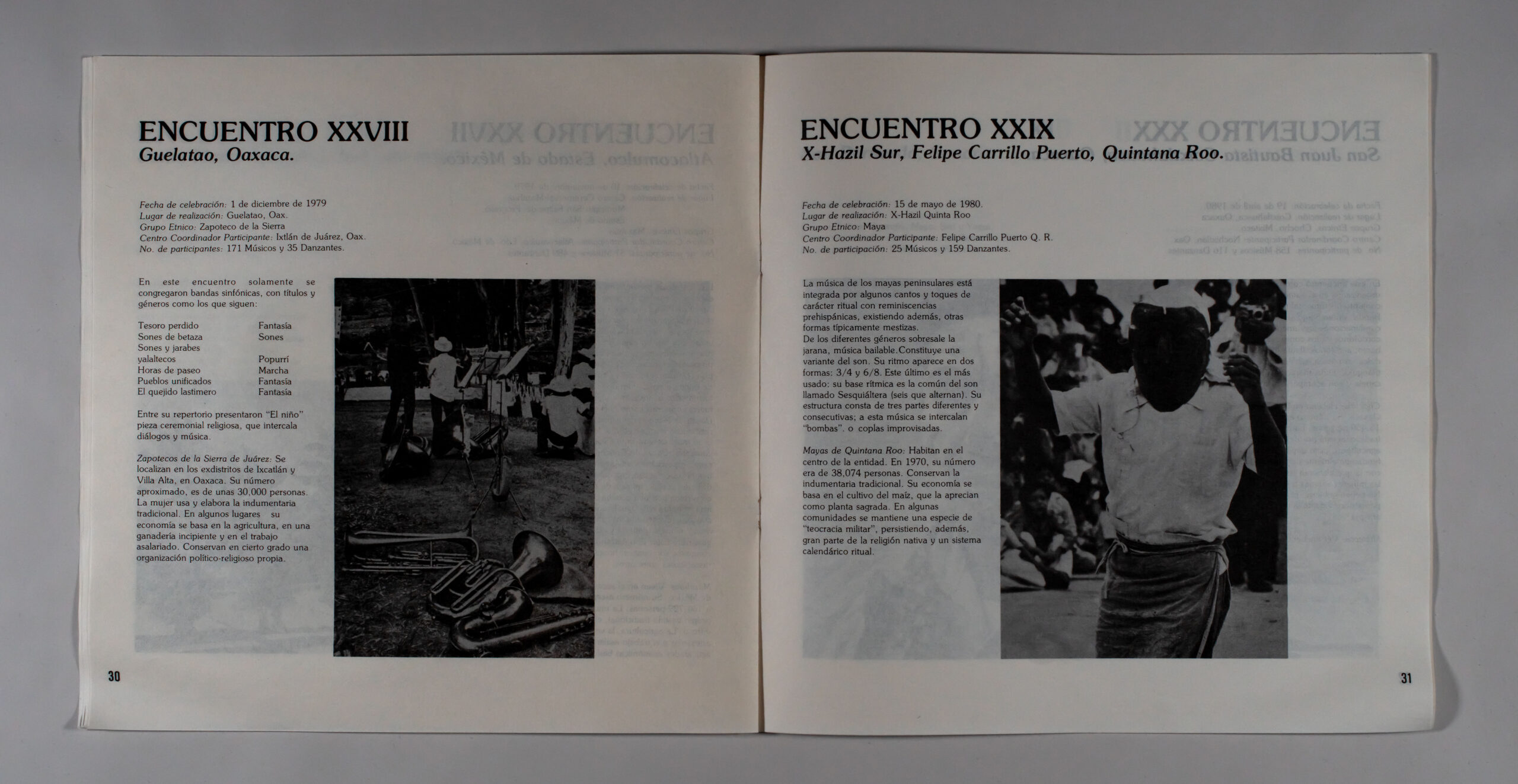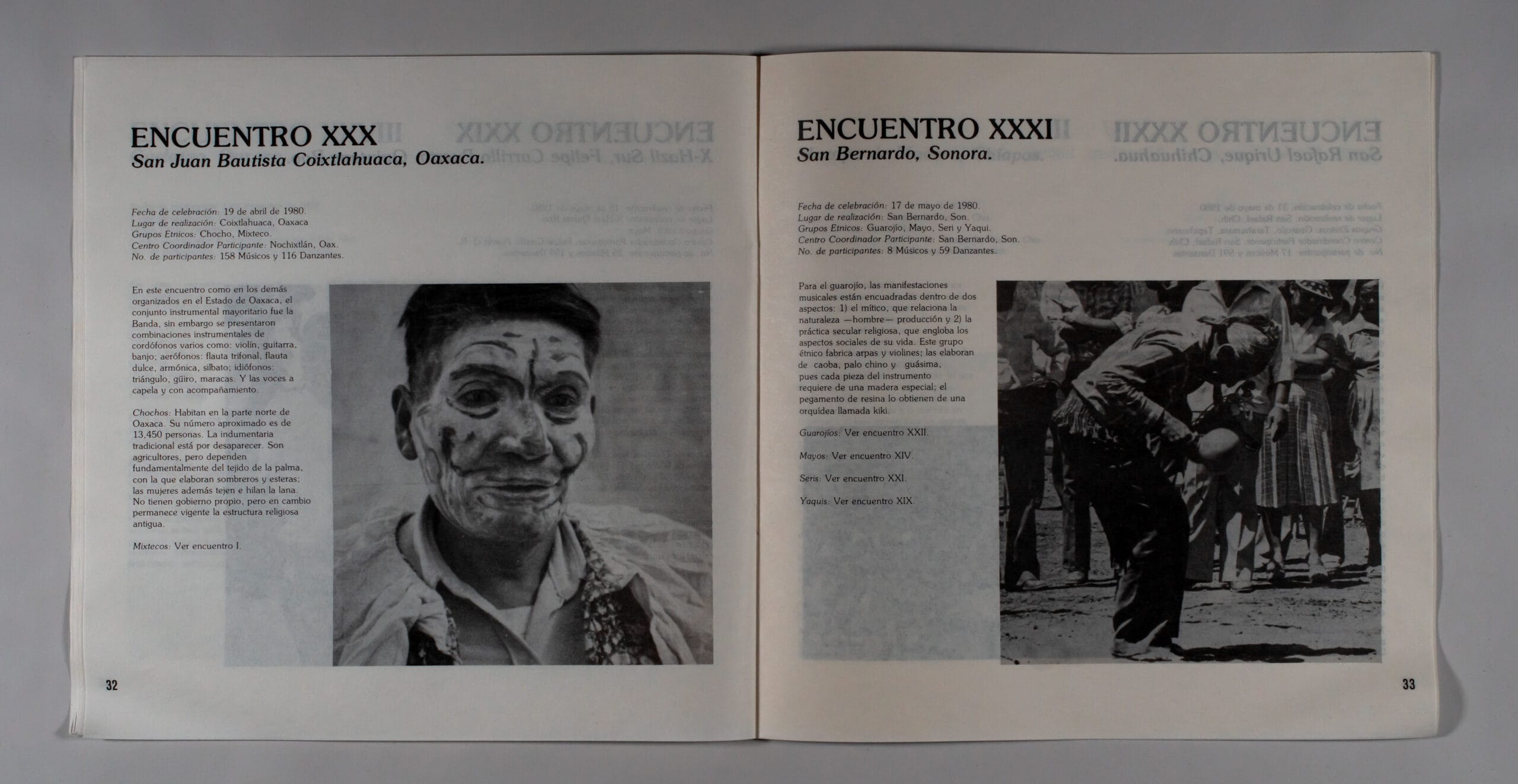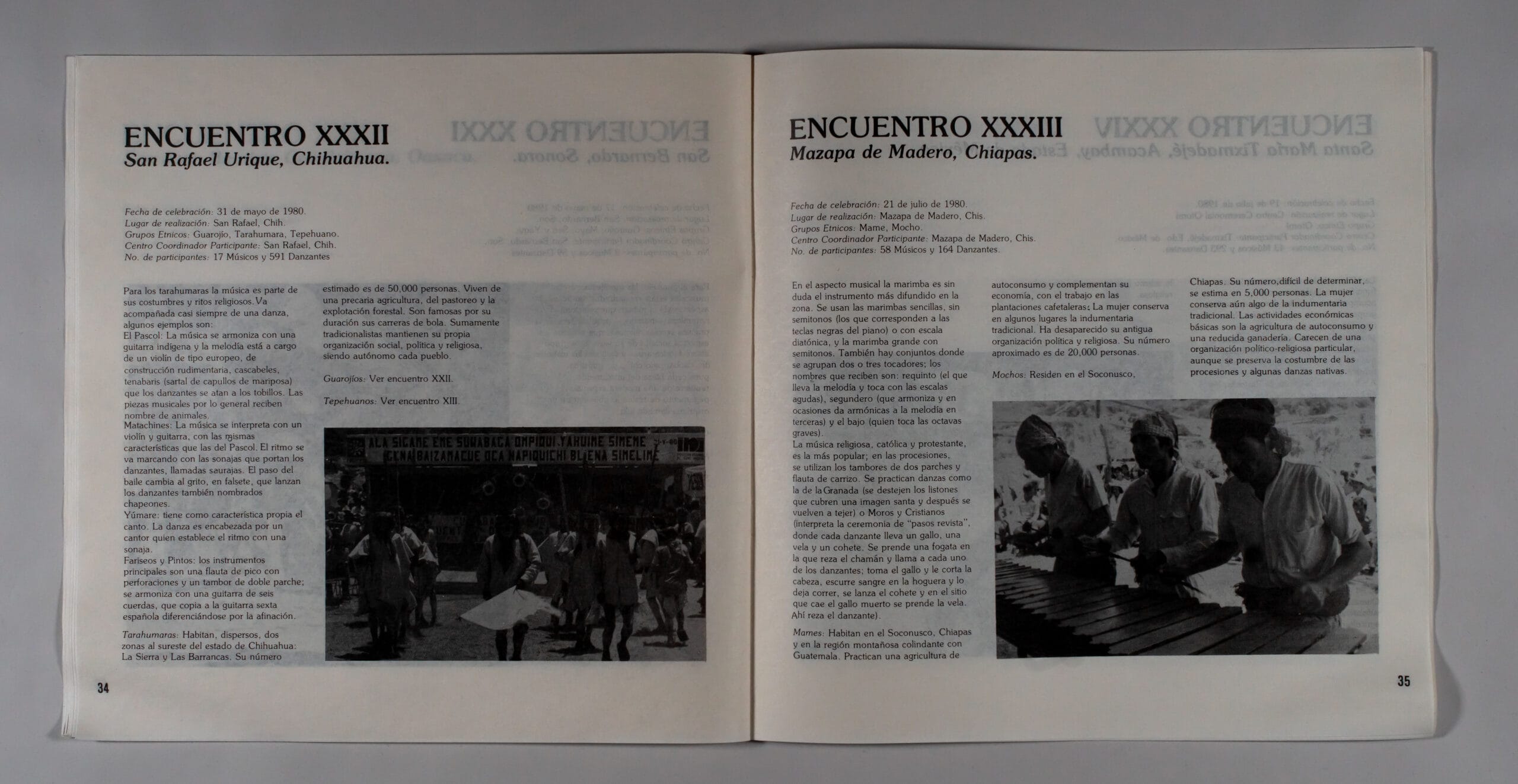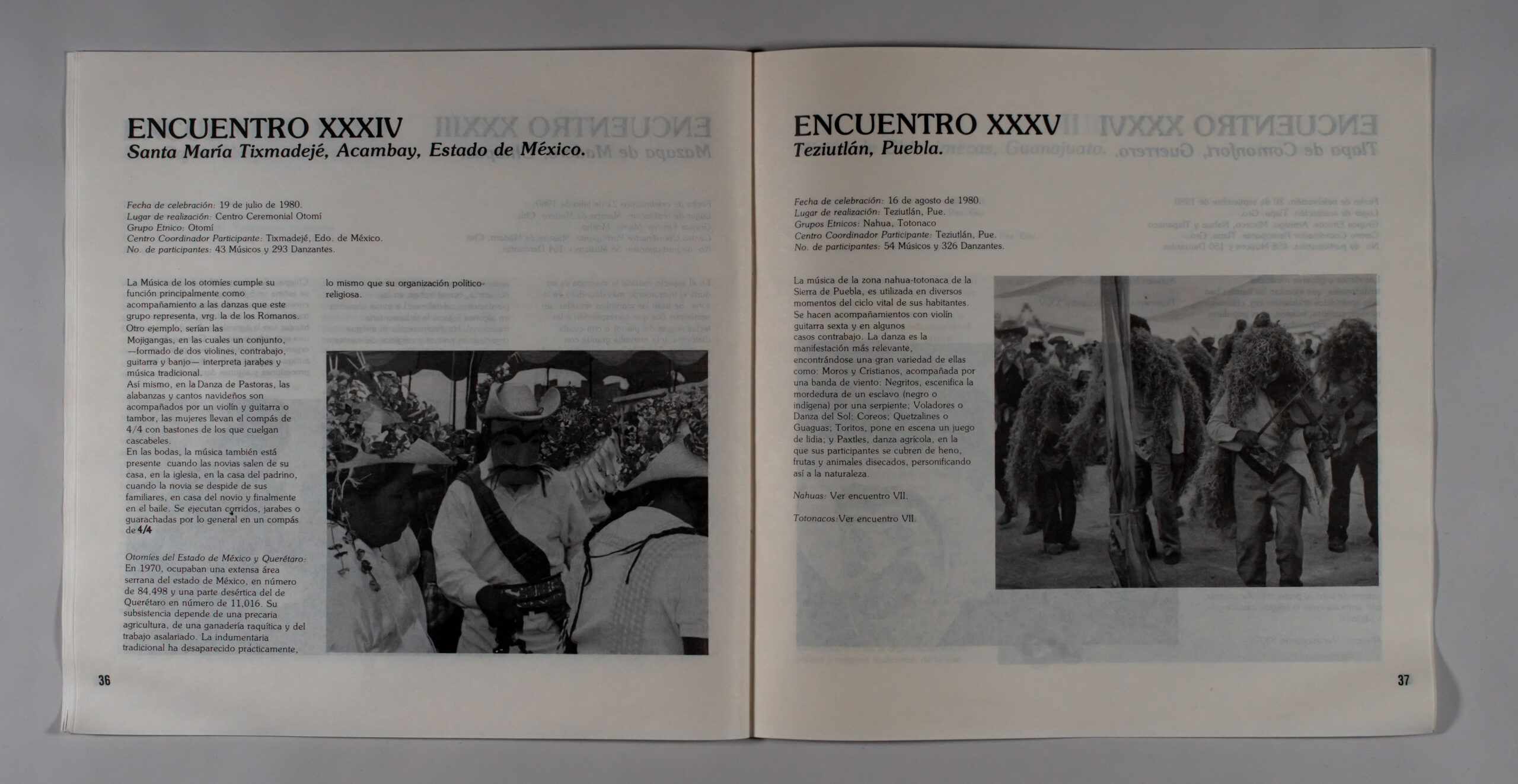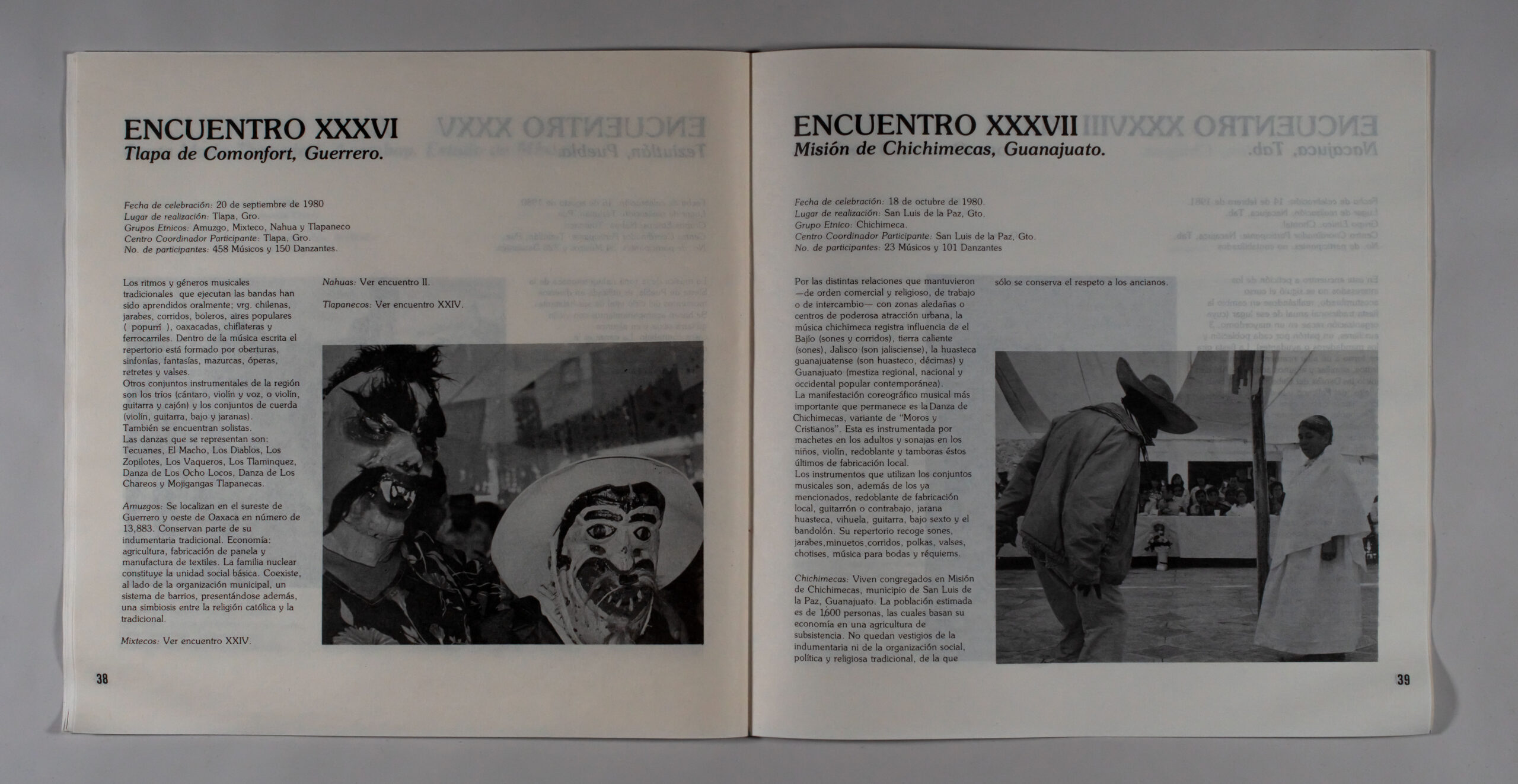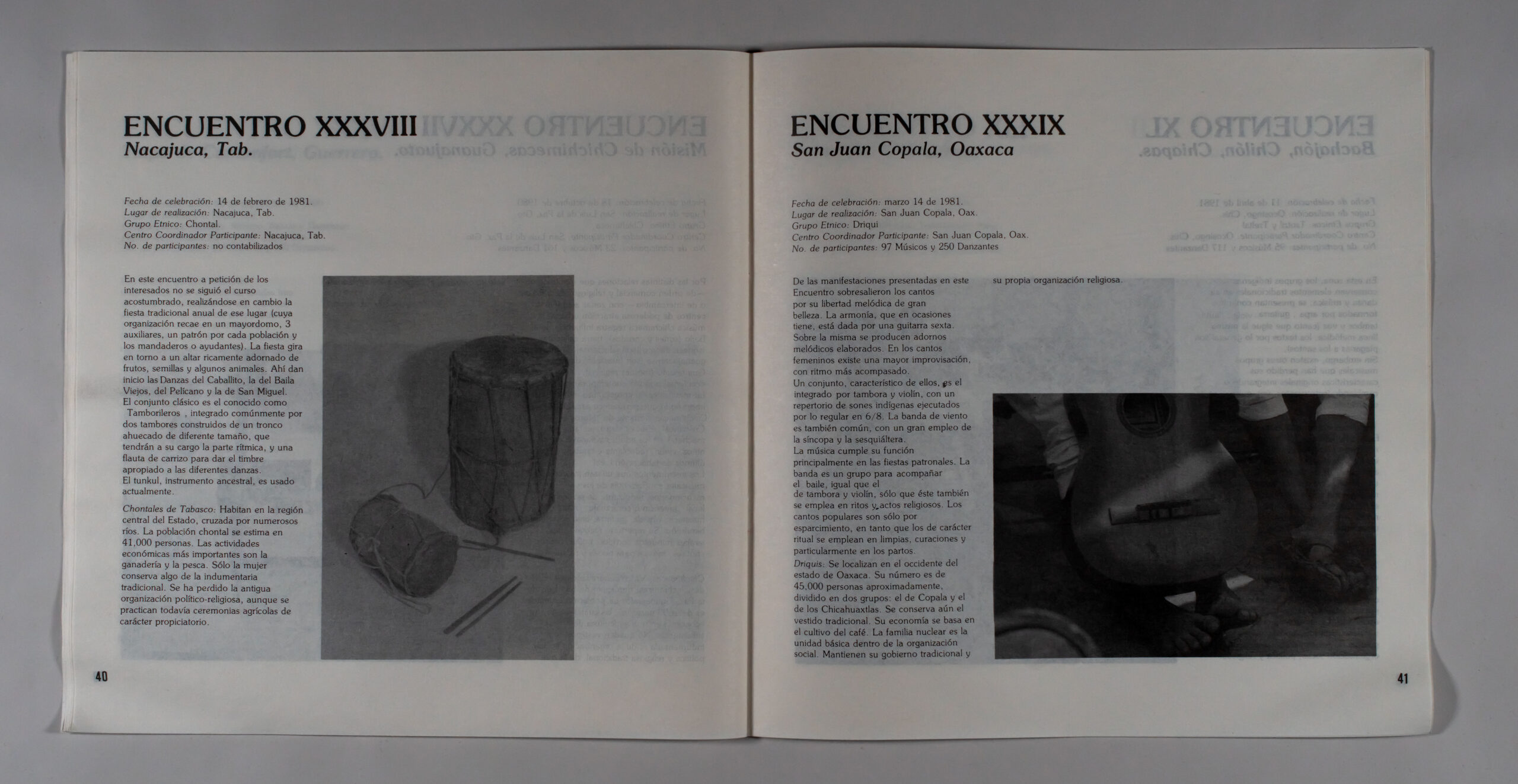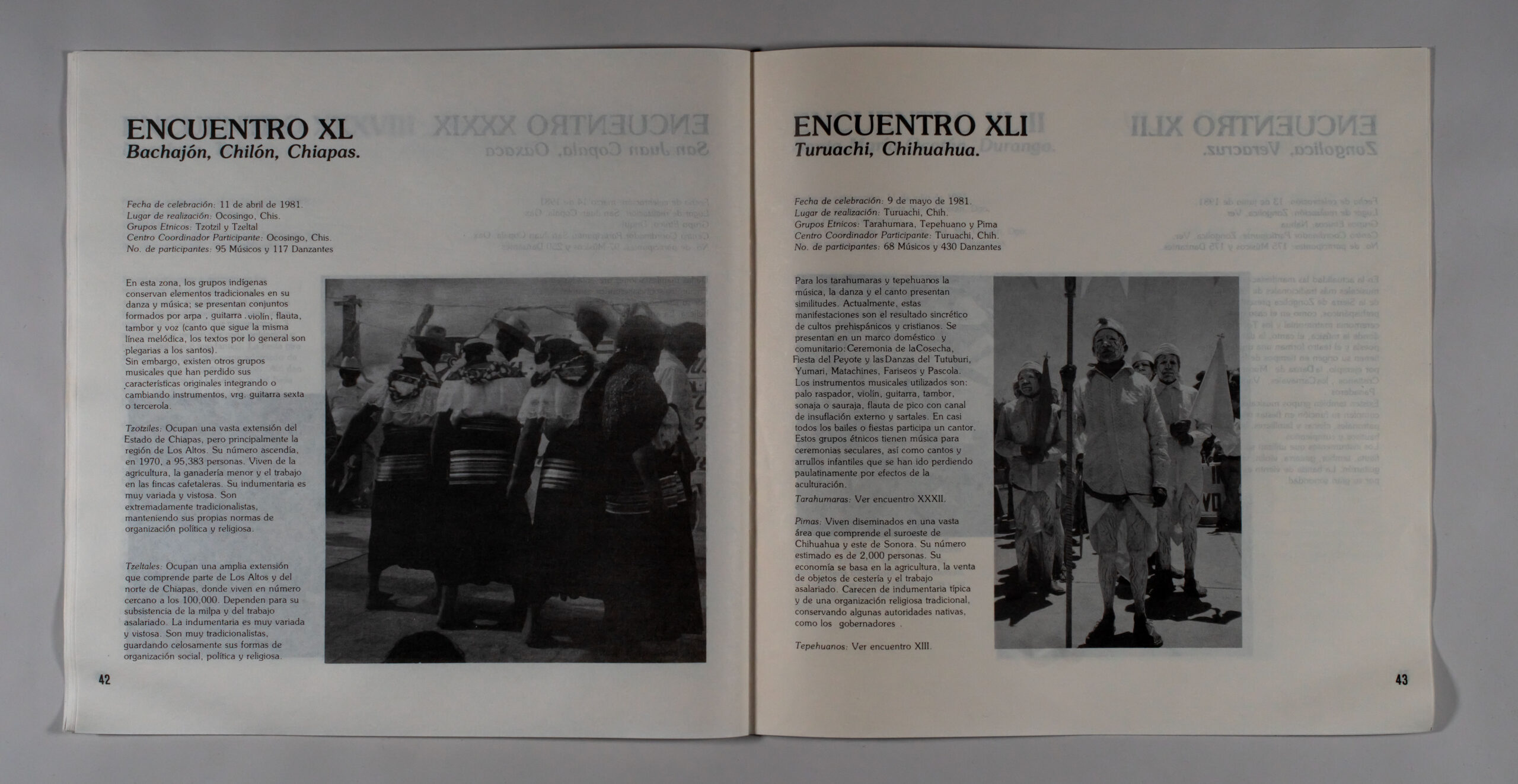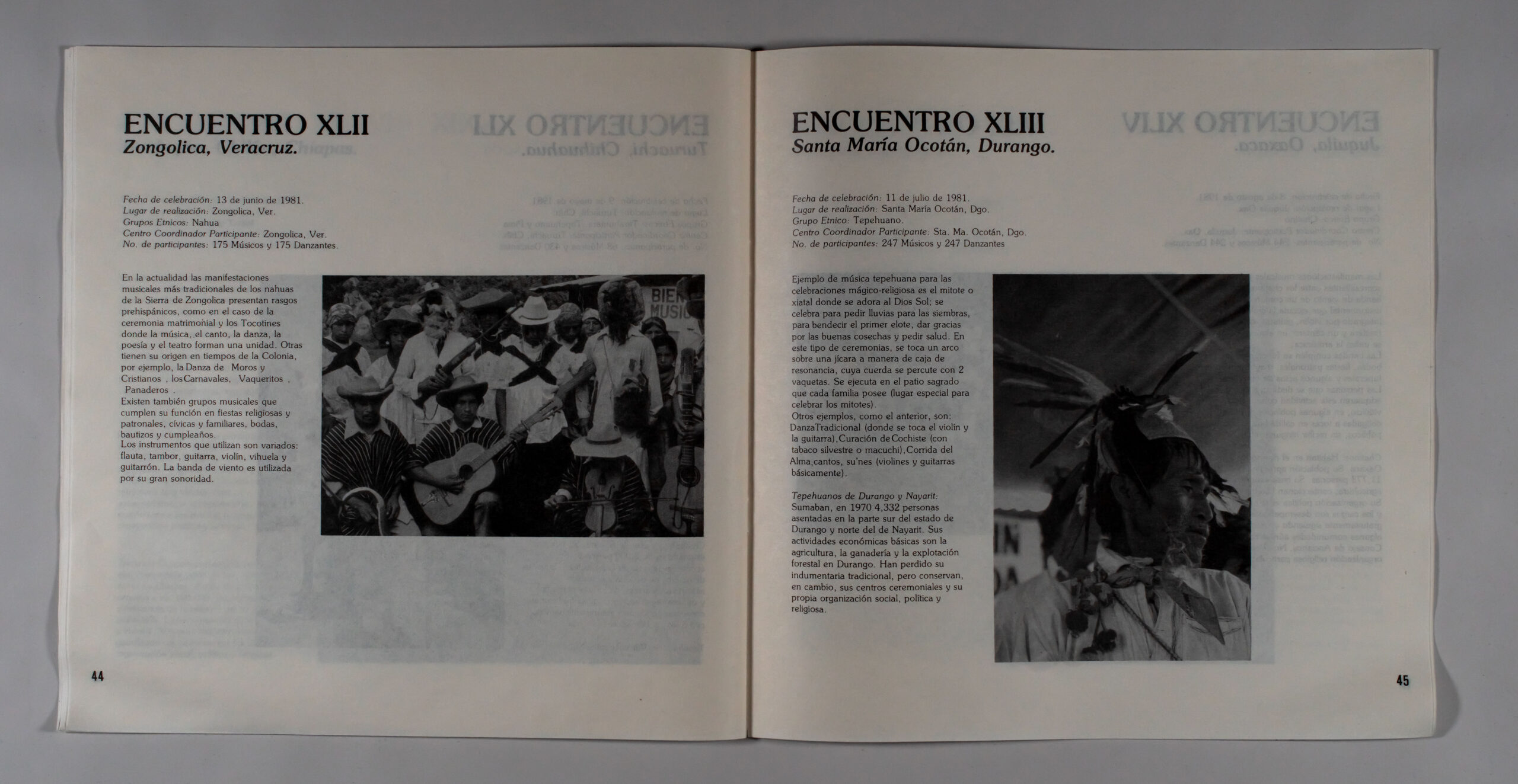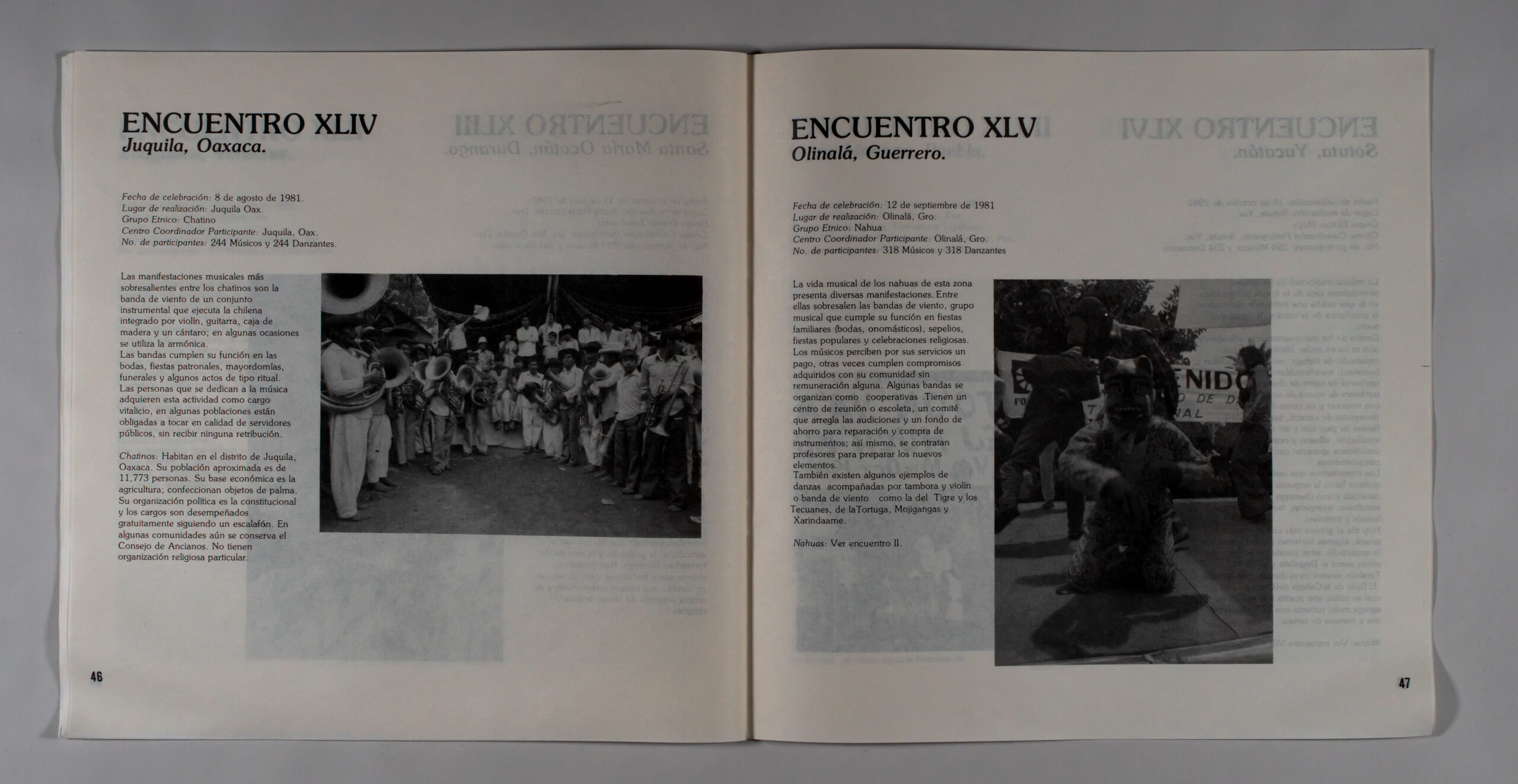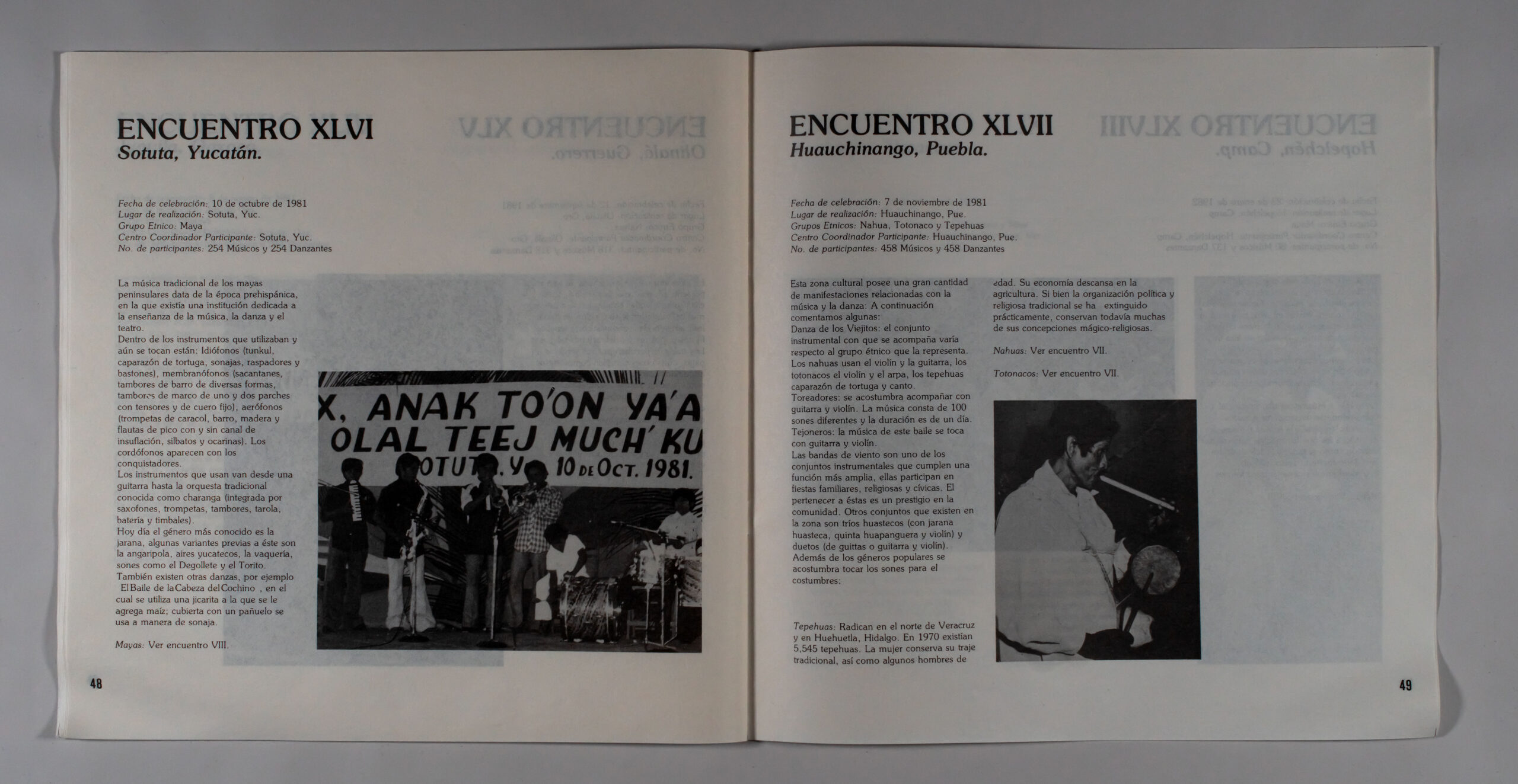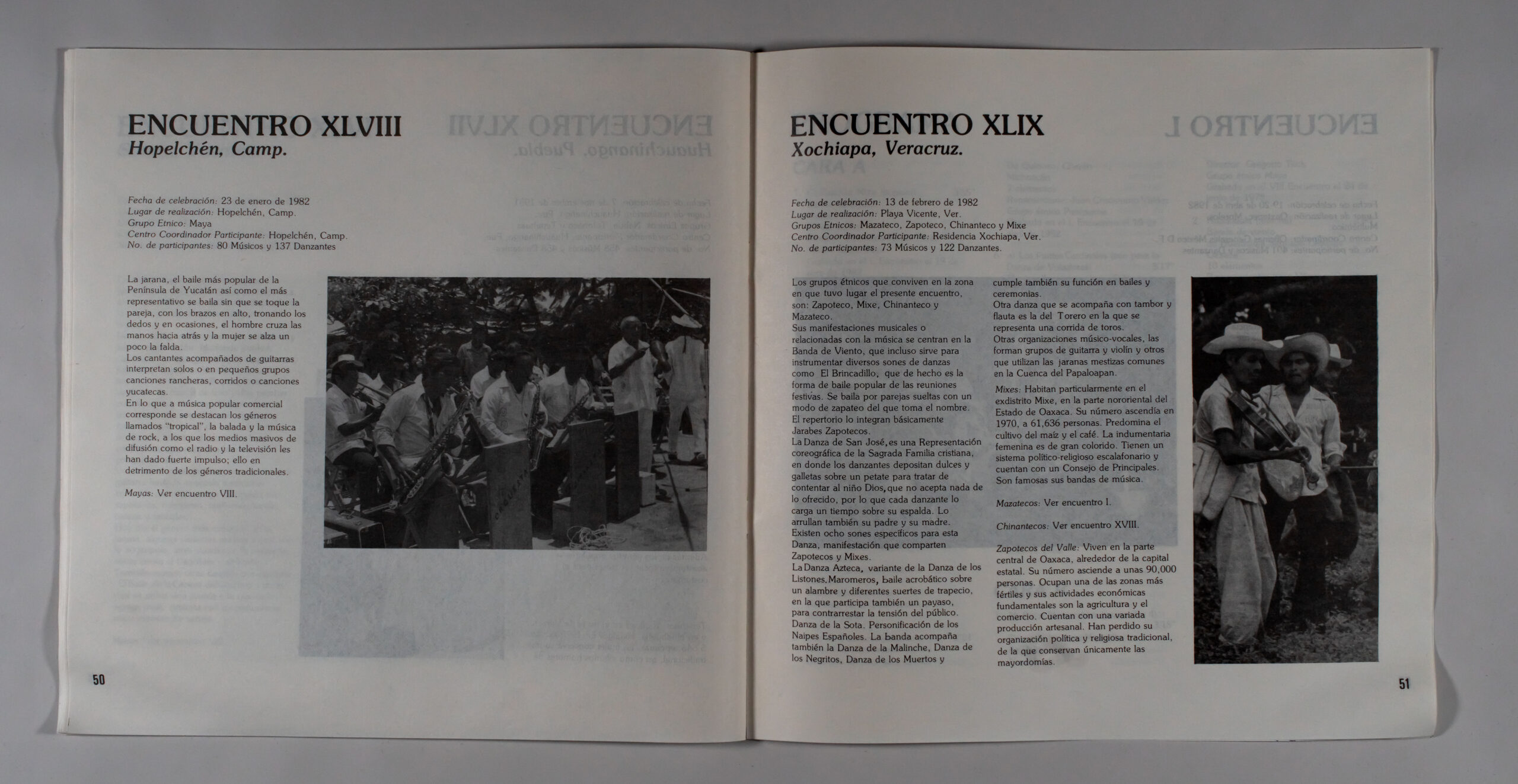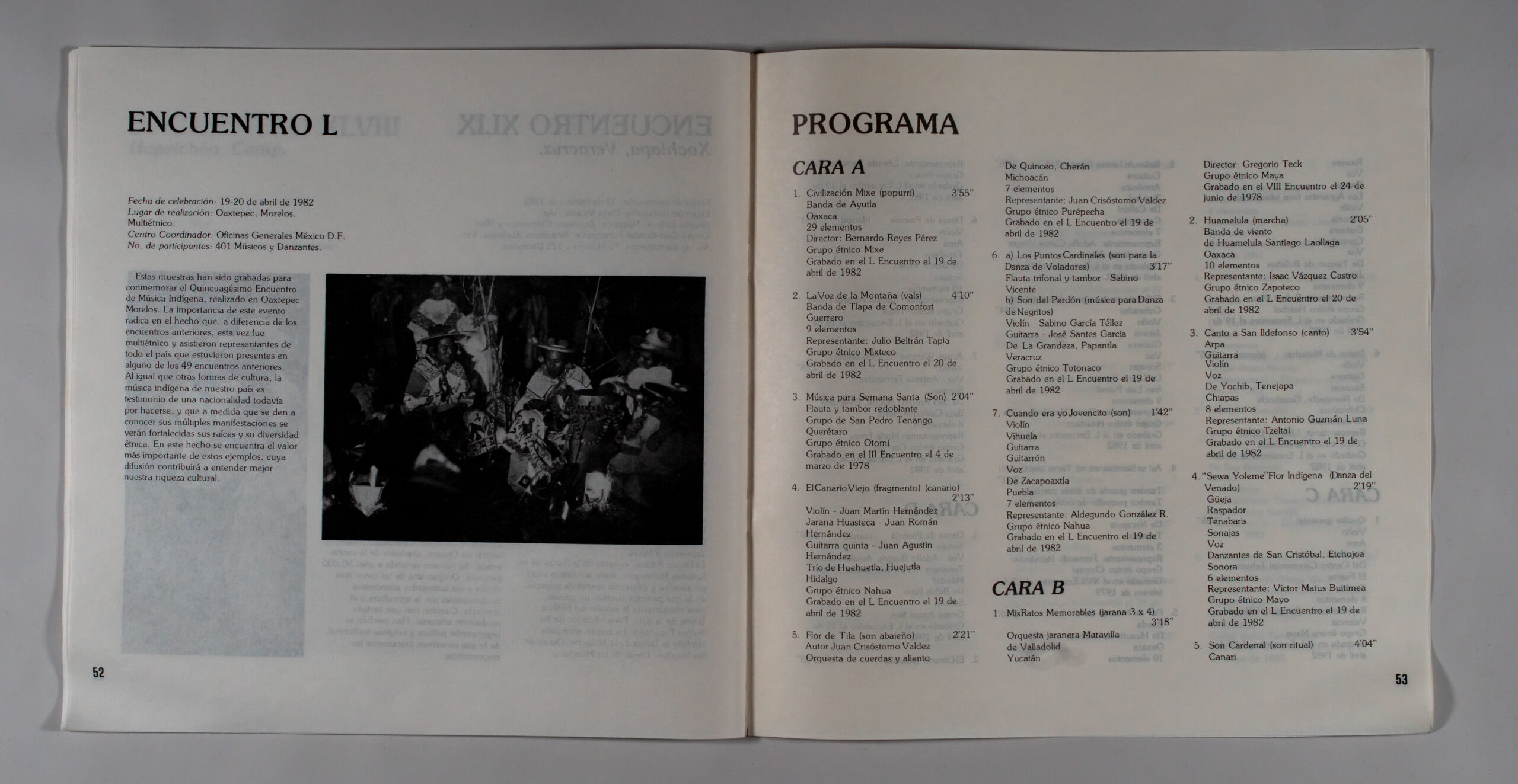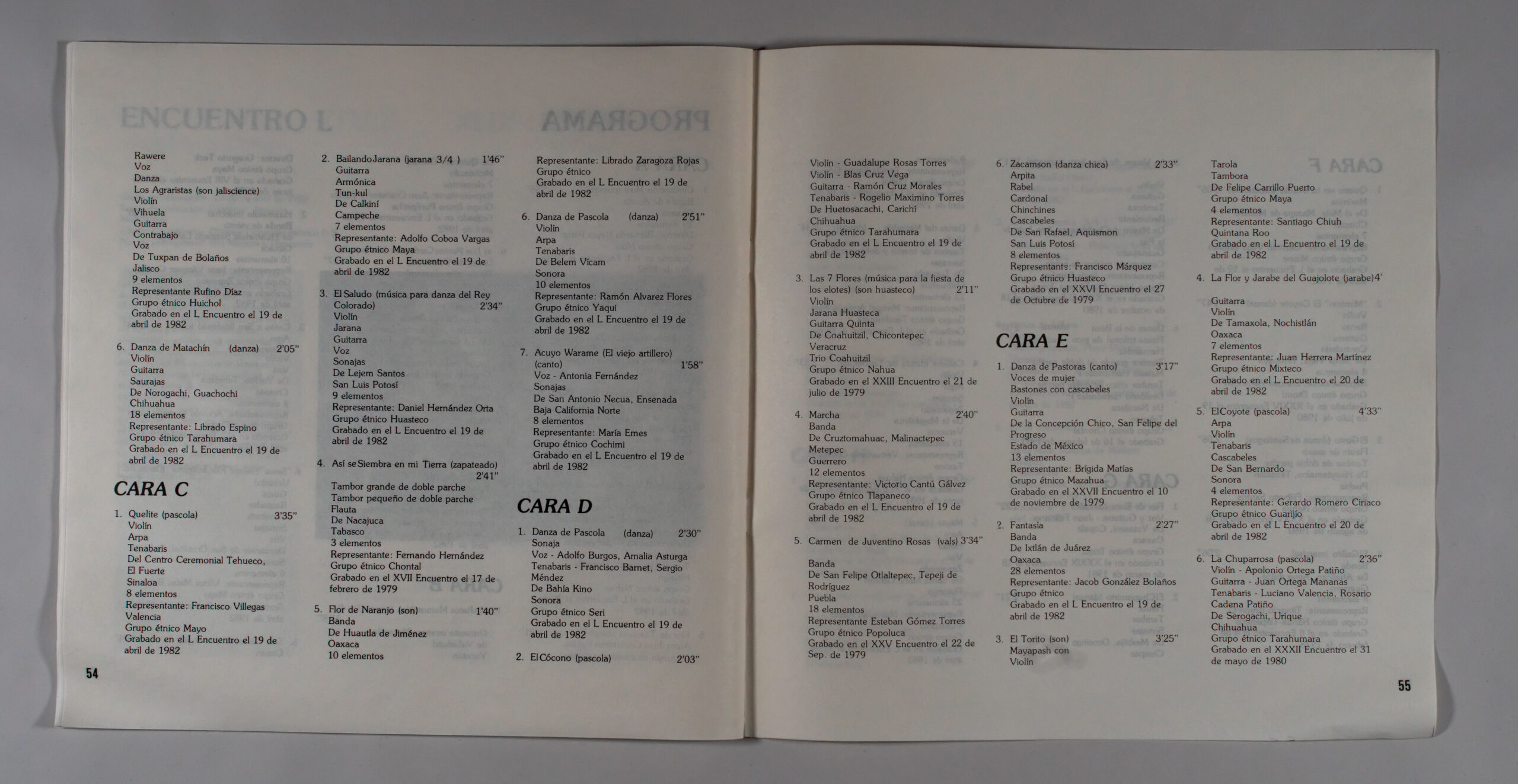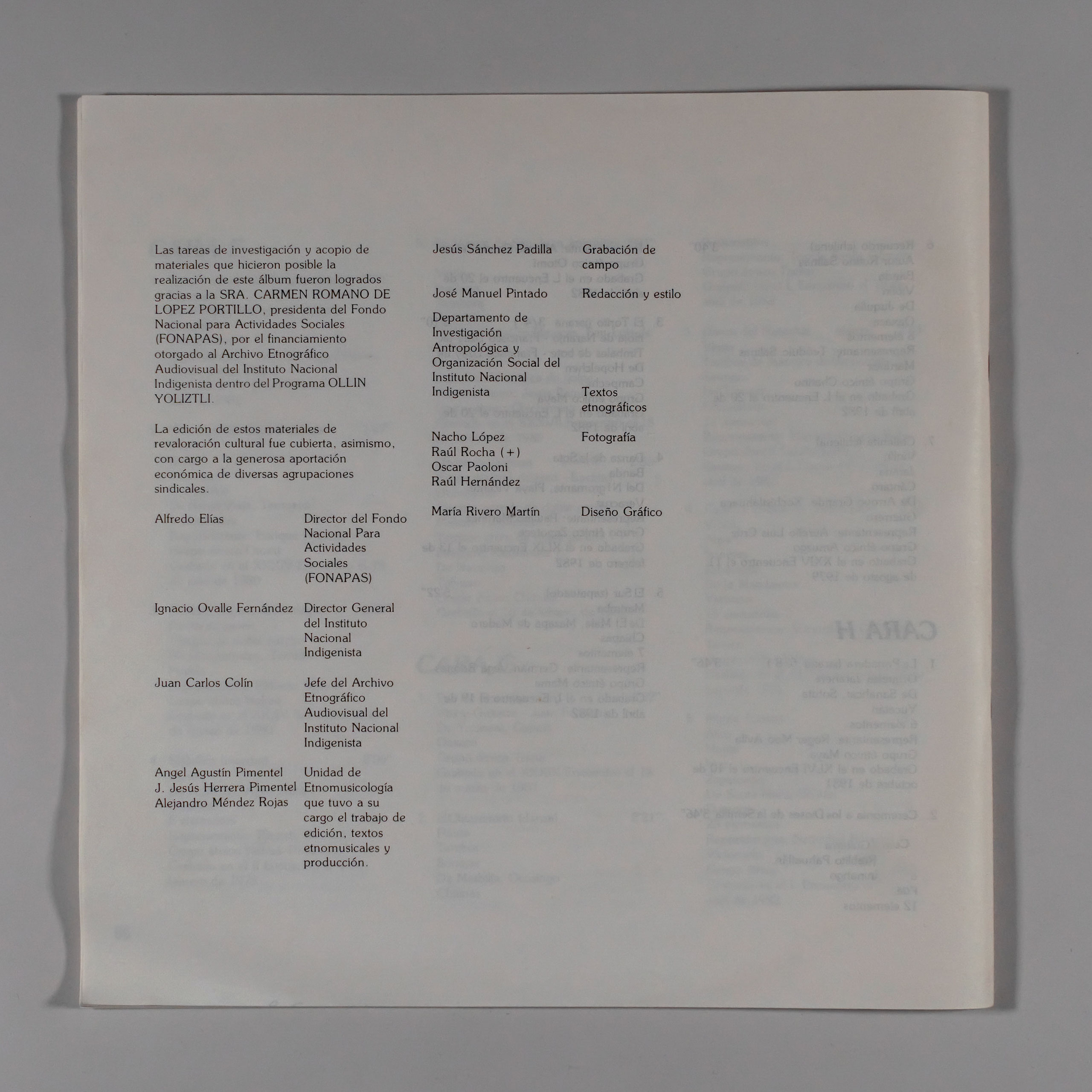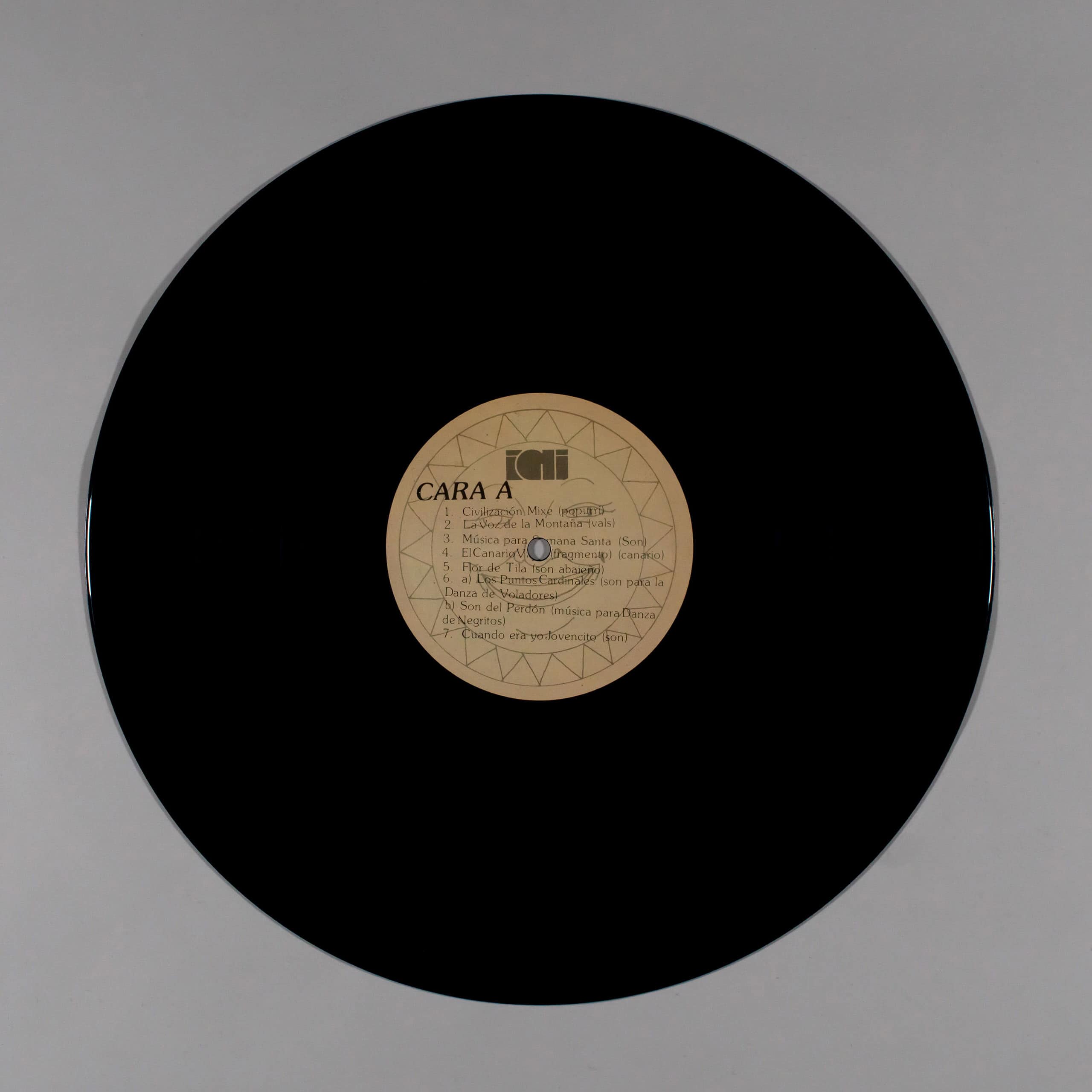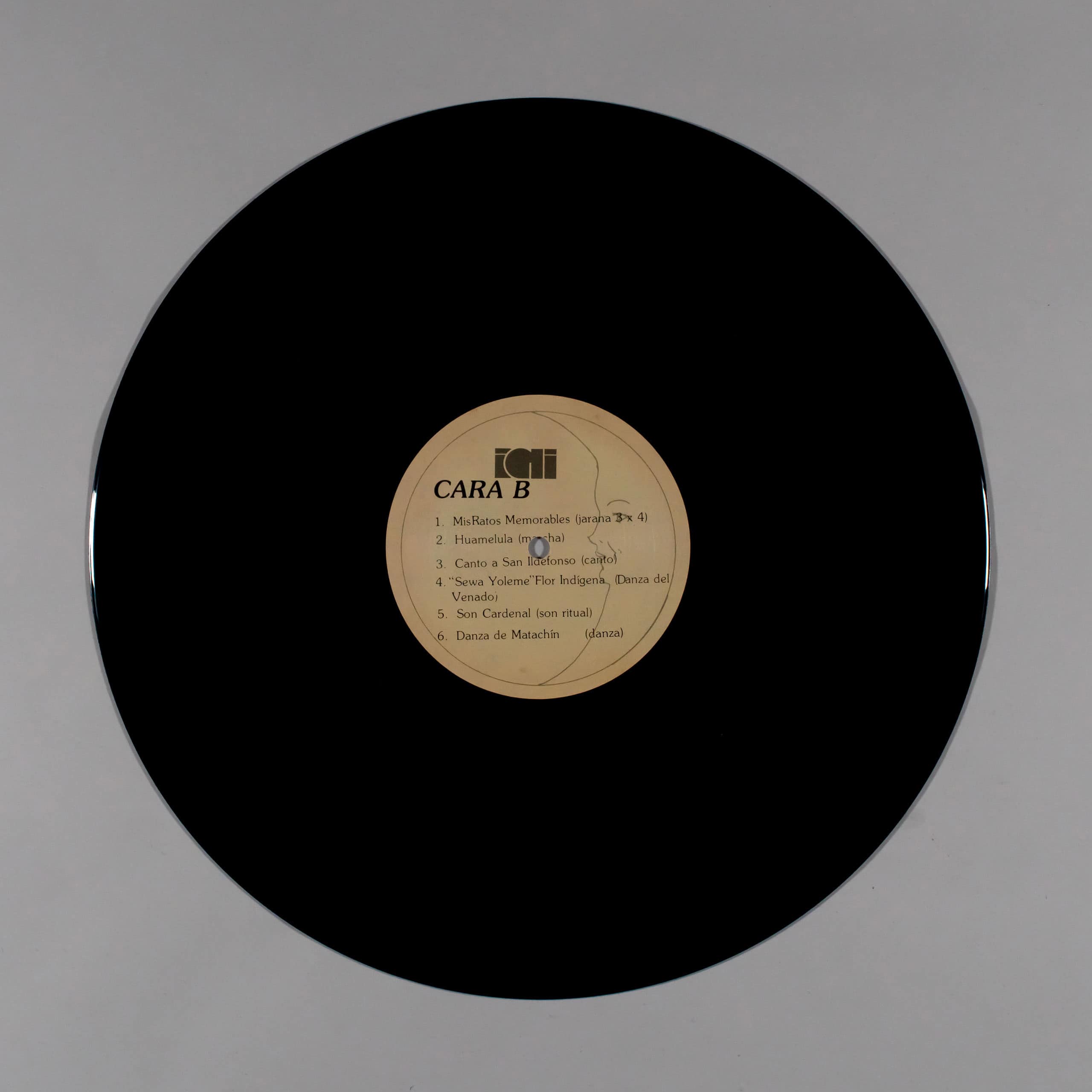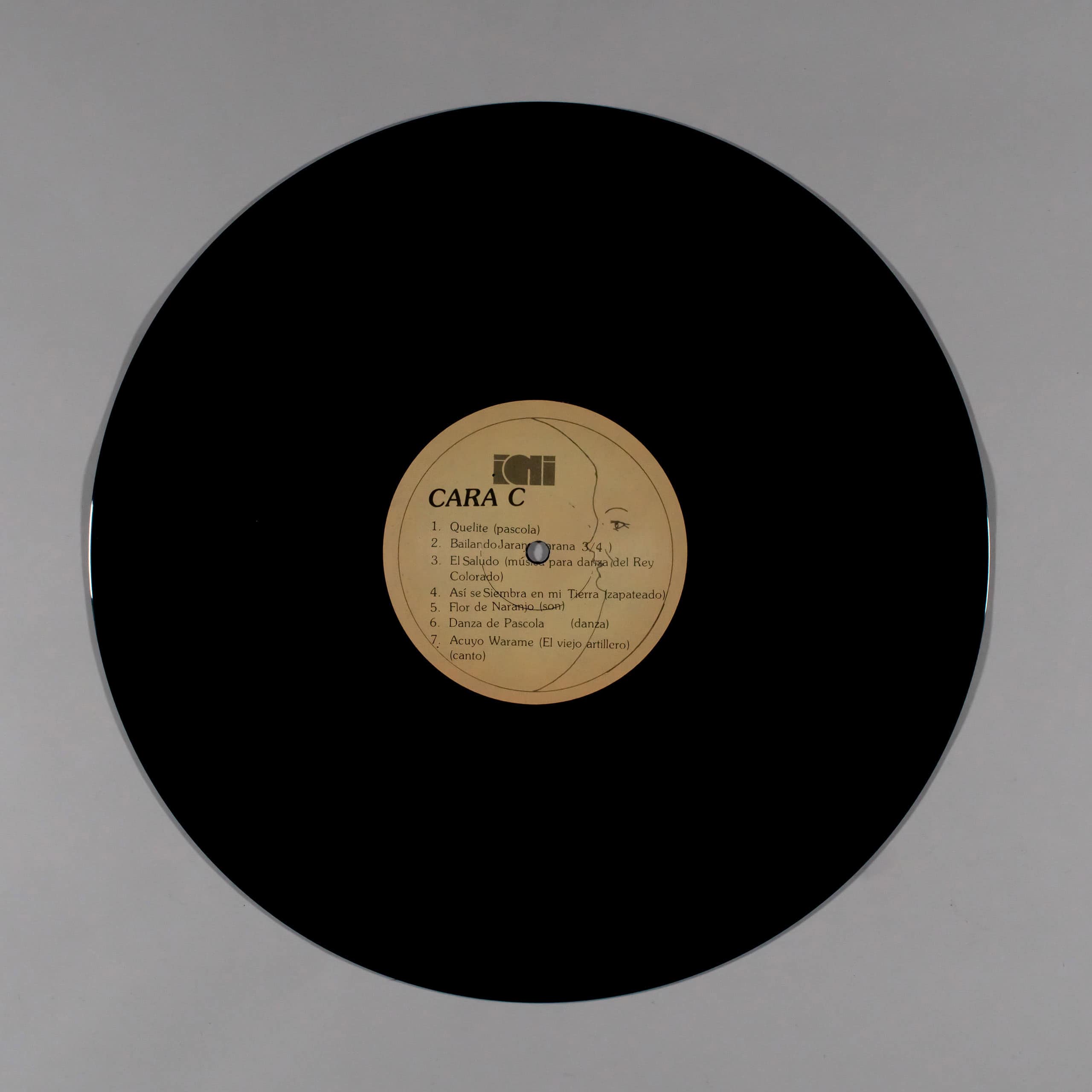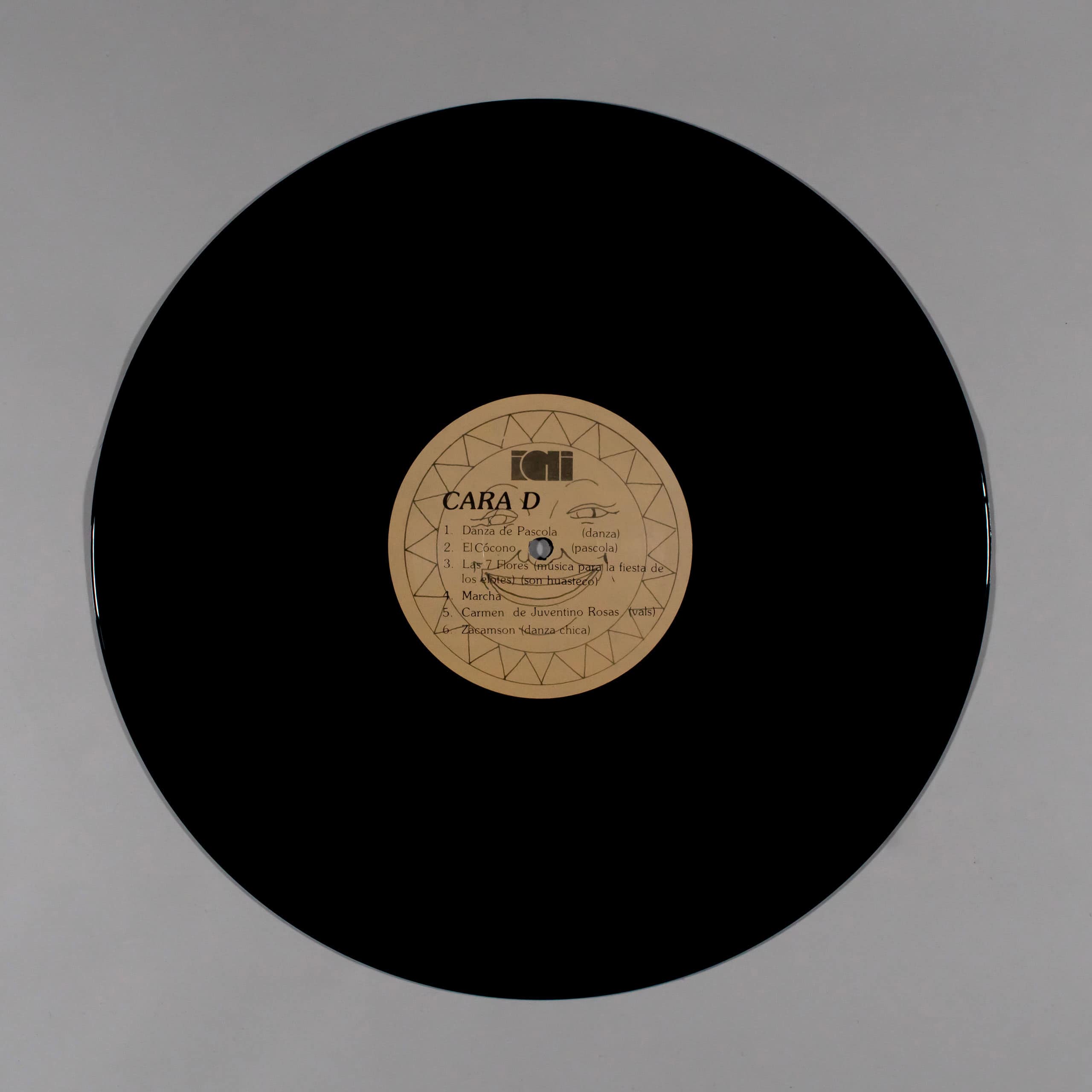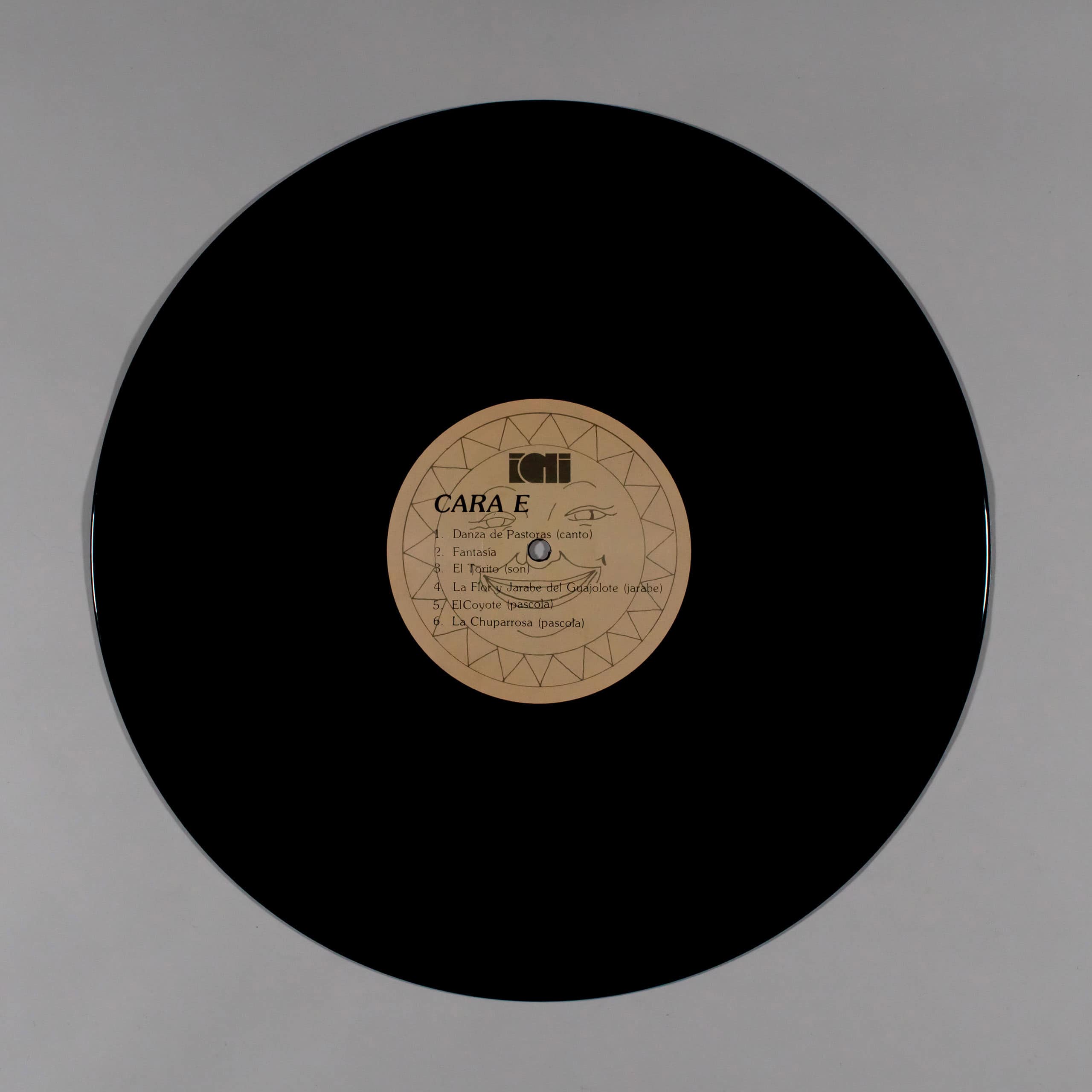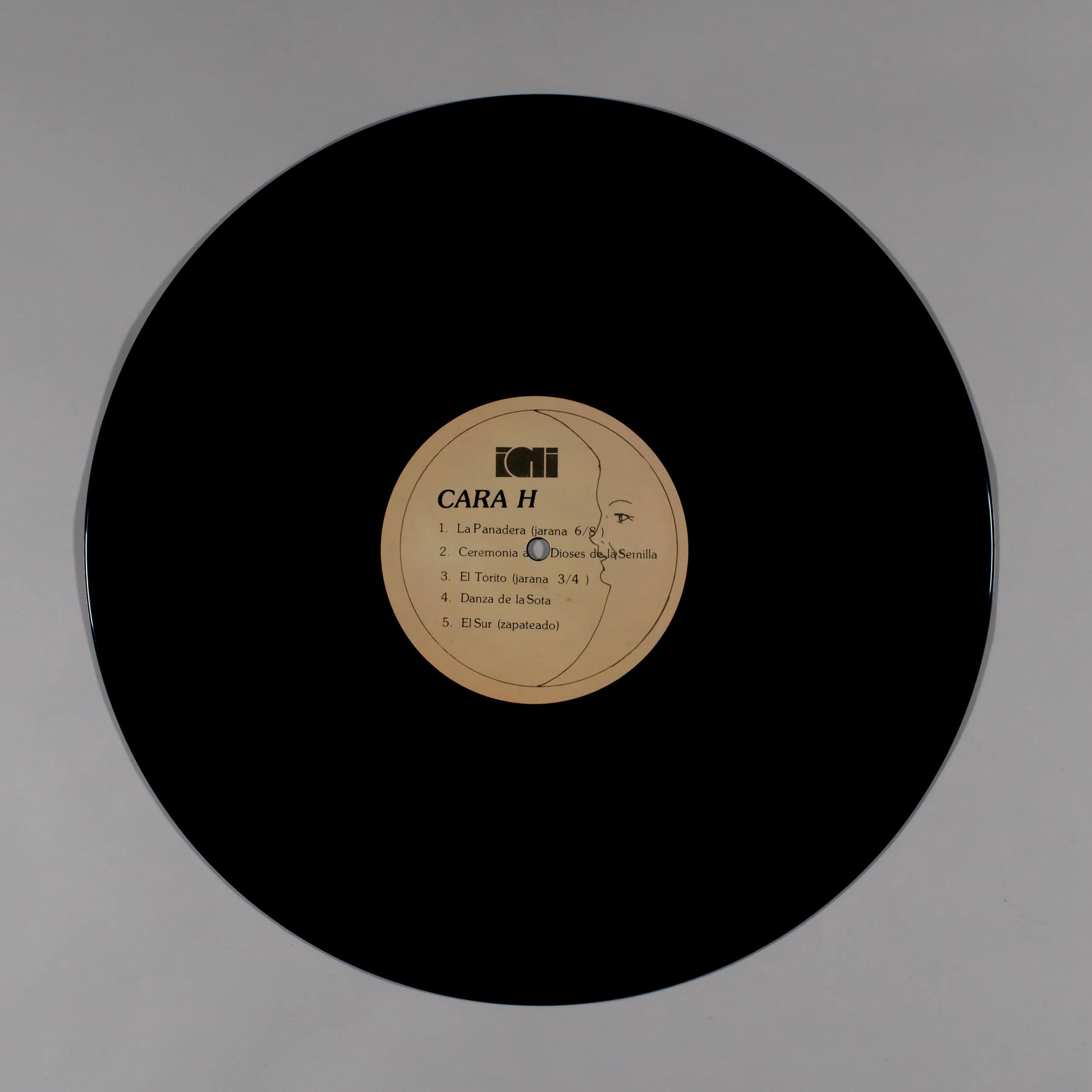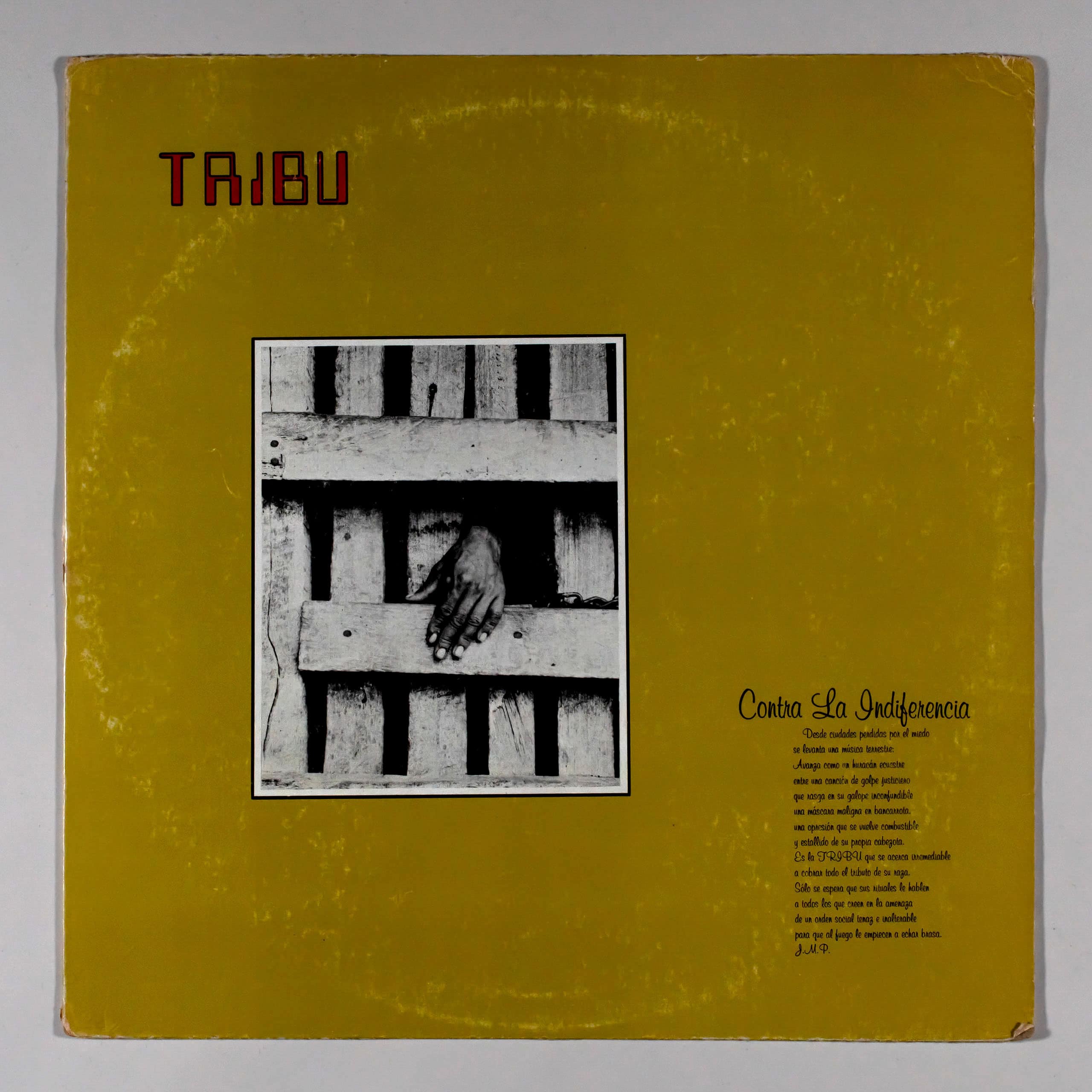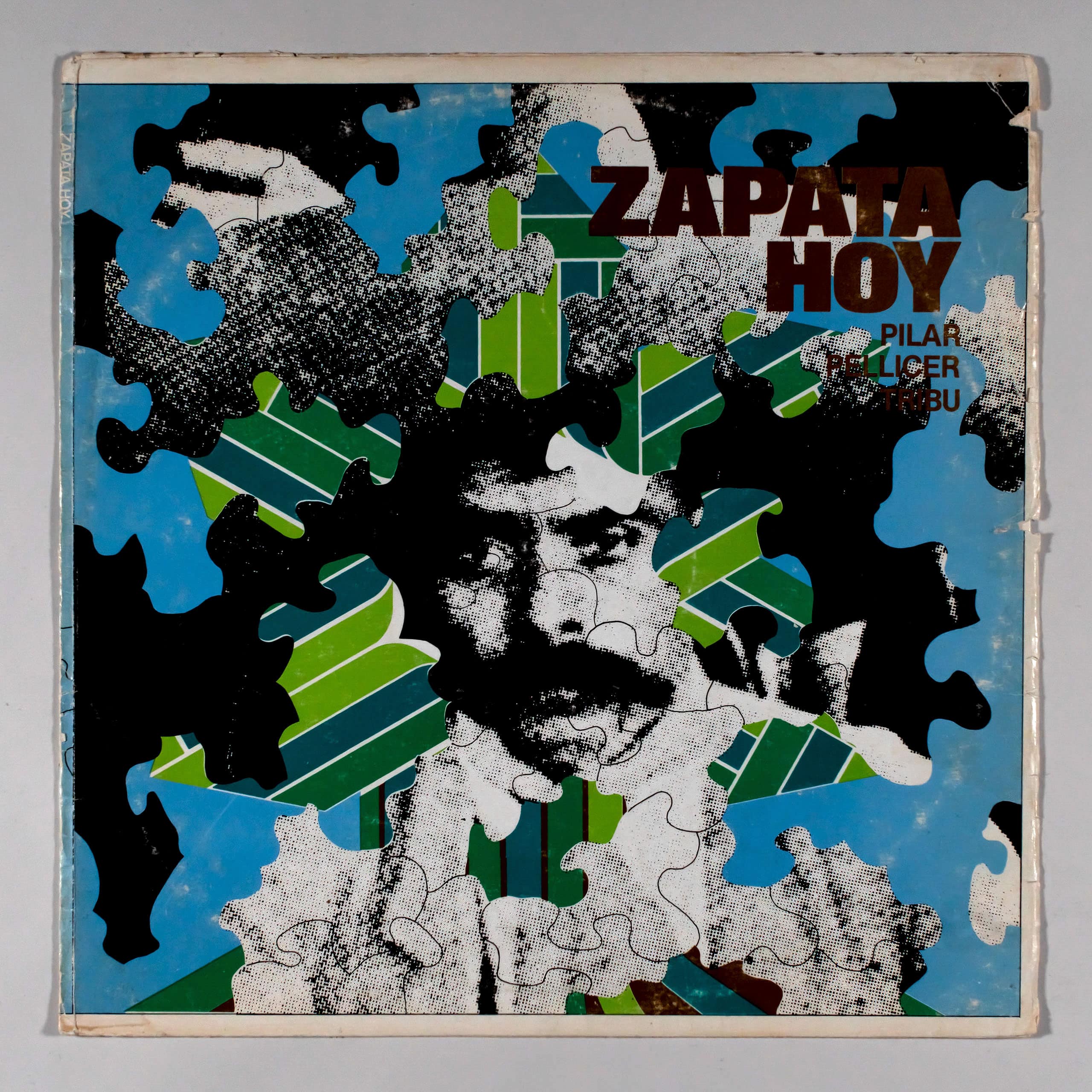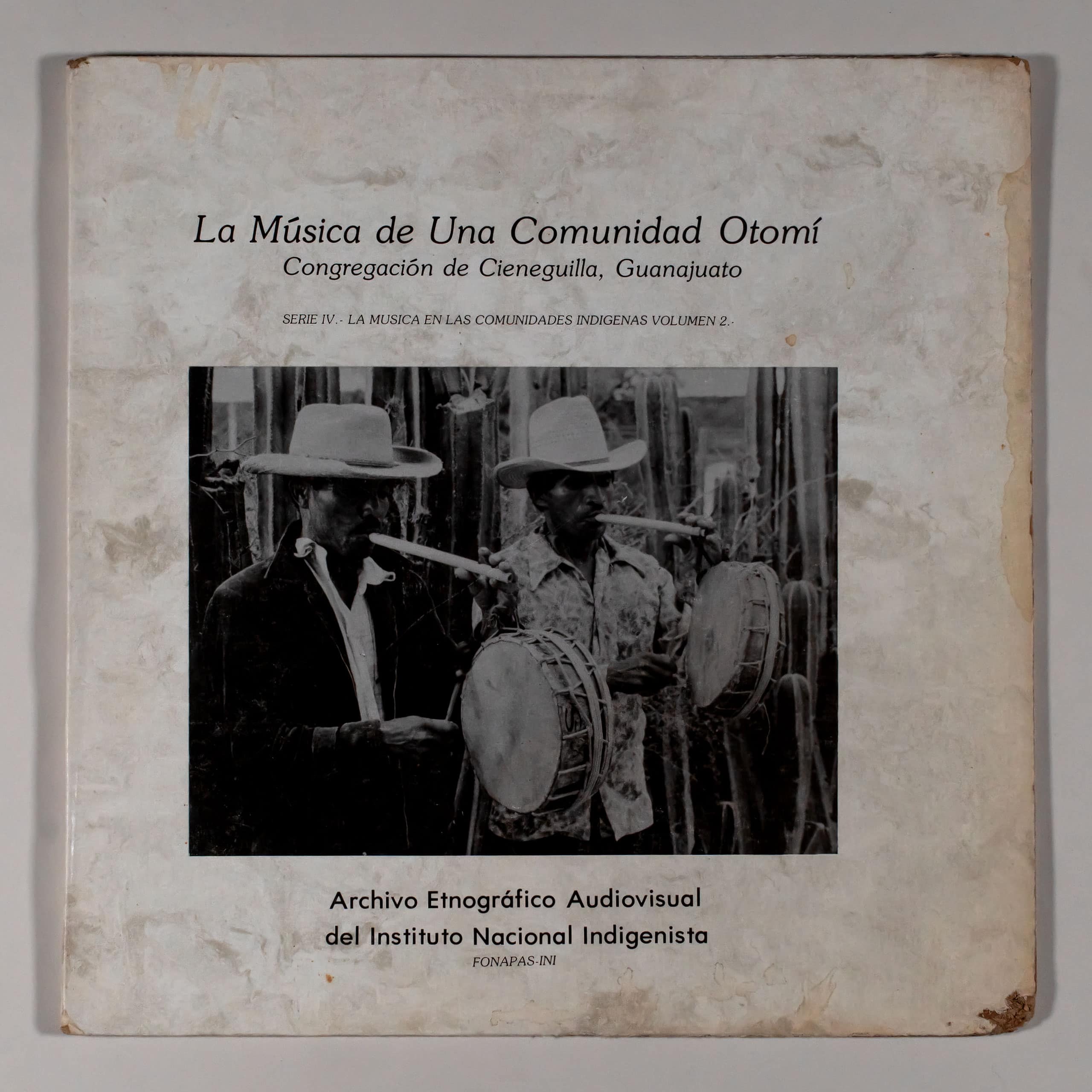50 MEETINGS OF INDIGENOUS MUSIC AND DANCE
Fonapas Ini
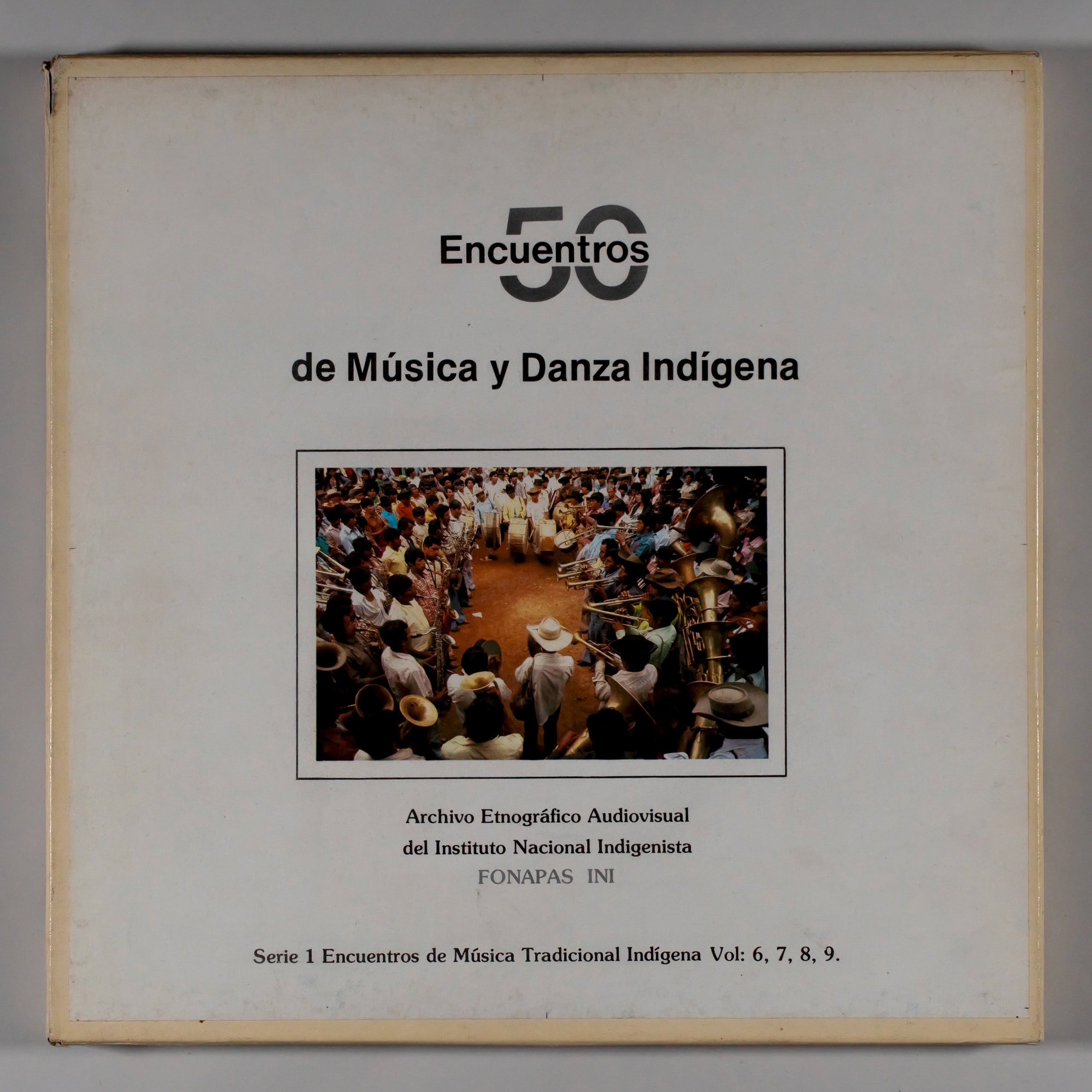
|
Label: FONAPAS-INI SERIES I, VOL. 6, 7, 8, 9 Released: 1982 |
Country: Mexico Genre: Folk World & Country |
Info:
50 MEETINGS OF INDIGENOUS MUSIC AND DANCE
Audiovisual Ethnographic Archive of the National Indigenous Institute
FONAPAS (National Fund for Social Activities) – INI
Series 1 Indigenous Traditional Music Meetings Vol: 6, 7, 8, 9.
50 MEETINGS OF INDIGENOUS MUSIC AND DANCE
In order to strengthen the musical expressions of our ethnic groups, in the face of the accelerated changes typical of a developing country, the National Fund for Social Activities (FONAPAS) and the National Indigenous Institute carry out a program called “Meetings of Traditional Indigenous Music and Dance” (Its beginning was in December 1977, and its continuity has allowed the fiftieth meeting to be held in February 1982. In that time, approximately 6,960 musicians and 5,488 dancers from 45 ethnic groups have participated, with a large number of spectators.-
A meeting could be defined as a gathering of musicians and dancers who live in the area of action of an Indigenous Coordinating Centre. They have acquired great importance as a factor of intra- and inter-ethnic cohesion and as a promotion of traditional culture. At this meeting, each participating soloist or group presents the material that they consider most traditional within their repertoire, or their own compositions that are in line with the sensitivity of their community.
For their participation they receive a prize in exchange, as an equal incentive among the contestants.
In a short time, the effects and results of these meetings have been appreciated: in the communities where they have been held, new groups have proliferated, existing ones have improved both in their music and in their choreography, they have renewed their costumes, and in general these expressions have gained greater interest, both for the performers themselves and for the public, who has been able to notice the immense wealth of instruments, dances and genres that make up the national culture.
We wanted to share this experience with a larger number of people, and this is why this CD has been produced. An example from each meeting has been selected, so that 50 musical meetings could be included. The glosses to the programme are limited to a brief commentary on the ethnic groups and their musical manifestations.
1st MEETING
Oaxaca, Oax.
Date of celebration: December 9, 10 and 11, 1977.
Place of celebration: Oaxaca, Oax.
Coordinating Center: State Coordinator of Oaxaca.
No. of participants: 566 musicians.
Ethnic groups: Mazatec, Mixtec, Mixe, Chatino and Zapotec del Valle.
On December 9, 1977, the First Traditional Music Meeting was held, convened at the time as a band competition in the City of Oaxaca. Over time, the program was modified to become an effective mechanism for the revaluation of the traditional cultures of our country; and from being an event only for bands, the doors were opened to music, dance and related expressions, such as poetry, narrative and storytelling.
Mazatecs: They are located in the former Oaxacan districts of Teotitlan, Tuxtepec and Cuicatlán. In 1970, their population was 101,541. Adult women still wear native clothing. Due to the diversity of climates, their agricultural production is very diversified. Their community spirit is manifested in the “tequio” and mutual aid. Their traditional political-religious organization has disappeared.
Mixtecs of the Sierra de Oaxaca: They live in a very rugged area that includes the former districts of Juxtlahuaca, Putla, Tlaxiaco and Teposcolula. Their approximate number is 80,000 people. Only adult women retain traditional clothing. They live from precarious agriculture and palm weaving. The political organization is municipal. Stewards and some pre-Hispanic beliefs persist.
Mixes: See 49th meeting.
Chatinos: See 44th meeting.
Zapotecs of the Valley: See 49th meeting.
2nd MEETING
Chilapa, Guerrero.
Date of celebration: February 4 and 5, 1978.
Place of celebration: Chilapa, Gro.
Ethnic groups: Nahua, Tlapaneco.
Coordinating center: Coordinating Office of Tlapa, Gro.
Number of participants: 426 Musicians and Dancers not counted.
For this cultural area, band music is the most practiced, although there are other commercial groups such as the northerners, trios, duets and estudiontinas. The most played genres are chilenas, marches and various sones; which are mainly instrumented with violin and guitar. They have other instruments such as the tecomaxtle, huehuetl and flutes, and a cappella vocals are also frequent.
Nahuas of Guerrero: About 70,000 Nahuas live in the mountainous area to the northeast of the state. They live off subsistence agriculture, incipient small-scale livestock farming, and palm weaving. In some places, women still wear traditional clothing, which men have lost. The ancient political-religious organization has also been lost. Their Dance of the Tigers is famous.
Tlapanecos: See 24th meeting.
3rd MEETING
Santiago Mezquititlan, Queretaro.
Date of celebration: March 4, 1978.
Place of realization: Santiago Mexquititlan Amealco. Qro.
Ethnic Groups: Otomi, Nahua.
Participating Coordinating Center: Amealco, Qro.
Number of participants: 72 Musicians and 61 Dancers.
The Otomi of this area have various musical manifestations that accompany their dances, which are almost always related to ritual and religion; other string groups are used in social celebrations such as weddings and various festivities where genres such as: corridos, polkas, ranchera songs, norteña, romantic and mañanitas are performed.
The musical instrumentation among the different groups is varied. The most used are: flutes, drum, snare drum, huéhuetl, bells (on the sticks used in the pastorelas), violin, banjo, bass sixth, double bass, guitar, and as far as singing is concerned, the a capella form (shepherds) is very used.
Among their dances are: Pastoras, which is in fact a group of female singers with a little elaborate choreography; the Vaqueras, Concheros, Moors and Christians, of the arches and The Slats.
Otomi from the State of Mexico and Queretaro: In 1970, they occupied a large mountainous area of the State of Mexico, numbering 84,498, and a desert part of the State of Queretaro, numbering 11,016. Their subsistence depended on precarious agriculture, meager livestock farming, and wage labor. Traditional clothing has practically disappeared, as has their political-religious organization.
Nahuas from San Luis Potosi: They are located in the Sierra Madre Oriental, in the south of the state. Their approximate number is 75,000 people. They make violins and guitars, as well as articles made of wood, reeds and palm. The basic economic activities are agriculture and fruit growing. Traditional clothing has disappeared, as has the old religious and political organization.
4th MEETING
Chalahuiyapa, Hidalgo.
Date of celebration: April 13, 1978.
Place of realization: Chalahuiyapa, Hgo. Huejutla, Hgo.
Ethnic Groups: Huasteco, Nahua.
Participating Coordinating Center: Huejutla, Hgo.
Number of participants: 307 Musicians.
In this Nahua area, music has received a strong mestizo influence. The most frequently performed instrumental groups are bands; trios, instrumented with violin, jarana huasteca and quinta huapanguera; duets; soloists and student groups.
The son huasteco, a regional expression of the son, is one of the most used genres.
Huastecos: They live in the northwestern part of San Luis Potosí and Veracruz. In 1970, their population was 66,099. Women wear traditional clothing, which varies from one area to another. Agriculture is the main economic activity, complemented by the sale of handicrafts. In some places, a Council of Elders and certain native beliefs are preserved.
Nahuas of the Northern Sierra of Puebla: See 7th meeting.
5th MEETING
Cheran, Michoacan.
Date of celebration: April 19, 1978.
Place of celebration: Cheran, Mich.
Ethnic groups: Purepecha, Nahua.
Participating Coordinating Center: Cheran, Mich.
Number of participants: 258 Musicians and Dancers not counted.
The most representative Purepecha instrumental groups are the bands; string groups that are organized into duets, trios and quartets; percussion duets; wind and percussion trios and quartets; and the orchestra.
Their music is related to their religious ceremonies, and ritual dances, various sones and pirekuas or songs in indigenous language are also practiced (which sometimes become the subject of instrumental groups).
Purepechas: They are also called “Tarascans” Approximately 60,000 Purepechas live in Michoacan, in the Tarascan Plateau and in the lake area. Their economy is based on agriculture and crafts, resin exploitation in the Plateau and fishing in the lakes. They maintain their own social and political-religious organization, and women continue to wear their traditional clothing.
Nahuas of Michoacan: They live in the northern coastal area, which is not very suitable for agriculture. They have an incipient livestock farming and a complementary fishing activity. The traditional dress and political and religious organization have almost completely disappeared. Only the brotherhoods and stewardships are preserved, as well as some dances that bear the name of the festival: They number approximately 11,000 people.
6th MEETING
Papantla, Veracruz.
Date of celebration: May 13, 1978.
Place of celebration: El Remolino, Ver.
Ethnic Group: Totonac.
Participating Coordinating Center: Papantla, Ver.
No. of participants: 62 musicians.
For the Totonacs, music is closely linked to religious ceremonies and dances. For example, the Dance of the Flyer has about 100 sounds, according to the evolutions of the dance; for example, there is the dance of forgiveness, the dance of the calandria, the dance of the chain, the dance of the guasanga, the dance of the street, etc.; this is played with an aerophone and a membranophone, that is, a flute made of reeds and a small drum that is played even when the dancers climb onto the flying pole where the musician dances at the top.
Some of the dances that are practiced are related in popular knowledge in the following way: one version is the one that tells us that in ancient times there was no light and people lived in darkness; then a great party was held to ask for light, which began with the Dance of the Negritos, then the Voladores continued and when they were going around the sun began to rise, that is why their plumes are like the rising sun; then it rained and that was when the guaguas or quetzalines danced and the rainbow was printed in the sky.
Totonacs of Veracruz: They are located on the coast of the Gulf of Mexico, in the north of the state. In 1970, their number was 70,169 people. Native clothing is disappearing. They have a wide variety of crops, many of them commercial. The traditional political-religious organization has been lost.
7th MEETING
Cuetzalan, Puebla.
Date of celebration: June 11, 1978.
Place of celebration: Cuetzalan, Pue.
Ethnic groups: Nahua, Totonaco, Huasteco and Popoluca.
Participating Coordinating Center: Zacapoaxtla, Pue.
Number of participants: 192 musicians.
Representative musical groups of the area are the string groups, in associations of violin and guitar and the classic Trio Huasteco which is formed with jarana, fifth guitar and violin. There are also a good number of bands, as well as groups that accompany the dances such as; the string groups already mentioned, those of triphonal recorder flute and small double-headed drum and others, such as the northern group and the trios, which although they are not from the area have been introduced through radio broadcasting. Music is used in weddings, baptisms, wakes and prayers, ceremonies accompanied by violin and guitar; in some cases also by the double bass. An instrument that has stopped being played in the region is the bass fifth, because it is hardly ever made anymore.
Nahuas of the Sierra Norte of Puebla: In this humid and forested region live some 250,000 Nahuas, whose main economic activity is agriculture, which includes some commercial crops. Textile crafts are important and colorful and correspond to women’s clothing. In some places part of the traditional political-religious organization is still preserved. They have important dances such as that of the Quetzales.
Totonacs of Puebla: They live in the northern part of the Sierra de Puebla. In 1970, their population was 52,806. In some places, women still wear traditional clothing. Their economy is based on agriculture, incipient small-scale livestock farming, and wage labor. They lack their own political-religious organization, although many elements of the native worldview persist.
Huastecos: See 4th meeting.
Popolocas: See 25th meeting.
8th MEETING
Valladolid, Yucatan.
Date of celebration: June 24, 1978.
Place of celebration: Valladolid, Yuc.
Ethnic group: Maya.
Participating Coordinating Center: Valladolid, Yuc.
Number of participants: 68 musicians.
The music of the Mayas today is the product of a long process of fusion that is evident in the genres and musical instruments of indigenous, Spanish and black origin.
They have some songs, although few date back to before the conquest. Most of their musical manifestations have their origin in the colony, as is the case of the jarana, a regional variant of the son that is very popular. Others are part of daily life, such as children’s lullabies.
The most common instruments are those of the traditional wind and percussion orchestra, which uses saxophones, clarinets, trumpets and the characteristic timpani. Another older Mayapax ensemble is made up of 2 violins, a tambora and a snare drum of local handcraft.
Mayas of Campeche and Yucatan: They are distributed throughout the entire territory of both states, corresponding in 1970, 55,346 to Campeche and 349,630 to Yucatan. Their ancestors achieved a high artistic and scientific development. They live from agriculture, and in Yucatan, from the cultivation and industrialization of henequen. They preserve their traditional clothing, their social cohesion and many of their traditions.
9th MEETING
Tehuantepec District, Oax.
Date of celebration: July 22, 1978.
Place of celebration: Santiago Laollaga, Oax.
Ethnic groups: Huave, Chontal, Zapotec and Mixe.
Participating Coordinating Center: Juchitán, Oax.
Number of participants: 96 musicians.
The band is the musical expression that the groups of this region use the most and the one that has developed the most. For this reason, the education of the musicians falls on the community’s economy. The place where they rehearse (escoleta) is in fact an important institution for each of these ethnic groups.
The repertoire includes marches, waltzes, sones, potpourri, traditional religious, bolero, paso doble.
Huaves: Also called mareños, they live in numbers of 10,000 on the southern coast of the Isthmus of Tehuantepec, Oaxaca. Fishing, agriculture and livestock are the basis of their economy. Traditional culture and ethnic awareness are deeply rooted, which is evident in their clothing, social cohesion and political-religious organization.
Chontales (from Oaxaca): Also called tequistlatecos. They are located in the Sierra and Coast of the state. Their approximate number is 10,298 people. The traditional dress is kept only by the woman, who adopts it on her wedding day. Their political organization is constitutional even though they preserve a rigorous socio-religious hierarchy. Their economic base is agriculture and fishing.
Zapotecs of the Isthmus: They live in the Isthmus of Tehuantepec, Oaxaca. Their approximate number is about 50,000 people. Their economy is based on agriculture and commerce. Women wear the traditional dress known as Tehuana. They have a strong sense of ethnic identity, which is why they maintain their own religious organization. Their festivals and dances are famous.
Mixes: See 49th meeting.
10th MEETING
San Lorenzo Zinacantan, Chiapas.
Date of celebration: August 9, 1978.
Place of celebration: San Lorenzo Zinacantan.
Ethnic groups: Tzotzil, Tzeltal and Tojolabal.
Number of participants: 165 musicians.
Participating Coordinating Center: San Cristóbal de las Casas, Chis.
The traditional music of the Tzotzils, Tzeltals and Tojolabales is very similar, solemn in character, imbued with great sweetness. The various instrumental groups are formed with drums with direct tension on the head and a three-tone recorder; other instruments such as a trumpet or accordion are also added to this group. The string group has its own versions of the harp, 10- and 12-string wire guitars, and a 2- and 3-string violin; the voices in the songs follow the melody of the violin, which gives it a peculiar tone. The dancers often use rattles. The accordion, also widely used, is often used alone or in various free associations, with the aforementioned instruments. Another instrument widely used by these groups is the marimba.
In addition to the aforementioned instruments, the guitarrón, vihuela, violin and shawms were used at the meeting.
Tojolabales: They live in the southeastern part of the state of Chiapas, close to the border with Guatemala. In 1970 there were 12,703 Tojolabales. Traditional clothing is preserved only in certain places. Their main economic activities are agriculture and small-scale livestock raising. They lack their own political and religious organization, but the belief in nahualism and native deities persists.
Tzotziles: See 40th meeting.
Tzeltals: See 40th meeting.
11th MEETING
Etchojoa, Sonora.
Date of celebration: September 8, 1978.
Place of celebration: Etchojoa, Son.
Ethnic groups: Seri, Papago, Guarijío and Mayo.
Participating Coordinating Center: Etchojoa, Son.
Number of participants: 26 musicians and 99 dancers.
The musical manifestations that are presented in the region are: Deer Dance, Pascolas Dance and Tutuburi, ceremonial songs and popular songs. The instrumentation of these is made up of rattles (different types), voice, tenabaris, violin, harp, bells, deer hooves, guitar, scrapers, percussed bules (submerged in water), flute and Yaqui drum. Popular songs are generally harmonized with a sixth guitar of local construction or commercial acquisition.
The songs that accompany the music are related to Seris customs and beliefs. They are directed to the Sun and the Sea, they are made to praise the harmony of nature, e.g. Papago songs (spoken to the sea and the cardinal points to ask for the well-being of the people and fertility of the land), or the Pascola (dance performed by a godfather of baptism to drive away the demons from the soul of the child).
Papago: The current Mexican-American border divided the Papago territory into the Sonora-Arizona portion. About 450 Papago live in the desert area of the Altar Valley. They practice little agriculture or cattle raising. They live from wage labor and the sale of pottery and basketry items. They have their own governors and worship their own deities.
Seris: See 21st meeting.
Guarijios: See 22nd meeting.
Mayos: See 14th meeting.
12th MEETING
San Andres Cohamiata, Jalisco.
Date of celebration: October 6, 7 and 8, 1978.
Place of celebration: San Andres Cohamiata, Jal.
Ethnic group: Huichol.
Participating Coordinating Center: Tuxpan de Bolaños, Jal.
Number of participants: 23 musicians and 304 dancers.
Huichol music is closely linked to magical-religious and political ceremonies. The instrumentation of the dances and songs they perform includes: a small violin (rawere), a small five-string guitar (canari), rattles, a drum similar to a one-headed huehuetl (lepo), and a bull horn trumpet or avá. The song is performed heterophonically by the community in ritual ceremonies. Their celebrations are adapted to the agricultural cycle and their daily activities, including the following: Peyoteros or Hikuri Neirra, Bull Sacrifice or Mawarirra, Esquites (which corresponds to the end of Hikuri Neirra, called Rariquirra), Festival of Our Mother Nature or Tatei neirra. Generally, it is customary to dance on a hollow trunk to produce more sound with the feet.
Huichol: They are located in the states of Jalisco and Nayarit. Their approximate number is 6,900 people. Their crafts are among the most beautiful in the country. Their economy is based on agriculture and livestock. They jealously guard their customs and traditions, so they maintain almost intact their traditional political-religious organization and their own worldview.
13th MEETING
Guachochi, Chihuahua.
Date of celebration: October 21, 1978.
Place of celebration: Guachochi, Chih.
Ethnic groups: Tarahumara, Guarijío and Tepehuano.
Participating Coordinating Center: Guachochi, Chih.
Number of participants: 70 musicians and 136 dancers.
The Tarahumaras conceive music as a manifestation parallel to ritual or religious dance. There are the following examples: The Pascoleros Dance has the following names: The Owl, Pascola, Dove, Tutuburi, The Bunny, The Deer, March, Resurrection, The Mansion, Open Easter, Final March, The Little Mouse, The Animal, The Countryman and The Chuparrosa. Tutuburi Dance, with female participation It is usually performed in the courtyard of the house. It is the sacred area of the Tarahumara and Tepehuan dwelling; it is directed by the singer or saweame who is accompanied by string instruments. In some communities, the Yumari, which was the concluding part of Tutuburi, is now considered a separate dance. It is very popular and both sexes participate in it. The Matachines, a product of evangelization, today reinterpreted and adapted, are perhaps the most common.
Tepehuanos of Chihuahua: Some 8,000 members of this ethnic group live scattered and isolated in the municipality of Guadalupe y Calvo, in the south of the state. They live from monoculture agriculture, goat and sheep farming, hunting and gathering. Their clothing mixes traditional elements with industrial ones. They maintain their own social, political and religious organization.
14th MEETING
El Fuerte, Sinaloa.
Date of celebration: November 18, 1978.
Place of celebration: El Fuerte, Sin.
Ethnic group: Mayo.
Participating Coordinating Center: El Fuerte, Sin.
Number of participants: 101 musicians and 81 dancers.
Some examples of the May dances are: Pascola, the Deer, the Jews and Matachines.
The musical instruments of the various groups are made up of zaorejas, bells, sartales, scrapers, bules, rattles, tenabaris, violin, guitar, bass sixth, double bass and accordion.
Mayos: They live in northwestern Mexico, in the coastal valleys of southern Sonora and northern Sinaloa. The 30,000 indigenous Mayos live, for the most part, from diversified and commercial irrigation agriculture and fishing. Although they have lost their traditional clothing, they maintain their own social, political and religious organization.
15th MEETING
Calkini, Campeche.
Date of celebration: December 1, 1978.
Place of celebration: Calkini, Camp.
Ethnic group: Maya.
Participating Coordinating Center: Calkini, Camp.
Number of participants: 51 musicians and 90 dancers.
The musical route from Seville to Havana to Merida to Veracruz to Mexico City was a cultural basin in the first half of the 19th century, and the Yucatan Peninsula was therefore strongly linked to Andalusian, Cuban and Caribbean music. At that time, genres such as the Cubanized 6 by 8 contradanza (which today is called clave, criolla and guajira), the 2 by 4 dance that forms the Havana dance, the danzón and some mixtures of these could be heard.
The conga and the rumba were also born from the contradanza. Other rhythms derived from the danzón, such as the guaracha and the son montuno, appeared then, as well as new musical instruments, especially saxophones and timbales.
Mayas: See 8th meeting.
16th MEETING
Huehuetlan, San Luis Potosi.
Date of celebration: December 8, 1978.
Place of celebration: Huehuetlan, S.L.P.
Ethnic groups: Huasteco, Pame.
Participating Coordinating Center: Ciudad Santos, S.L.P.
Number of participants: 122 musicians and 333 dancers.
At this meeting, music for dance was presented, as well as dances such as the Tzacanson with its small ensemble of arpita rabel (small violin) and carsonal (very small jaranita); Dance of the Malinche accompanied by jarana and violin, Dance of the Wands and the ribbons, Dance of the Corn, Dance of the Bull accompanied by shawms and huéhuetl, Dance of the Rebozo and Dance of the Concheros.
Pame: They live in a mountainous and desert area of San Luis Potosí. According to the census in 1970, there were 4,924 Pames. They make articles from wicker, ixtle and palm. Agricultural productivity is very low, so they must emigrate in search of work. They do not maintain their own social, political or religious institutions, but many traditional magical-religious aspects persist.
Huastecos: See 4th meeting.
17th MEETING
Rayon, Chiapas.
Celebration date: February 17, 1979.
Ethnic groups: Zoque, Chol, Chontal.
Participating Coordinating Center: Pichucalco, Chis.
No. of participants: 83 musicians and 22 dancers.
Place of realization: San Bartolomé Ignacio López Rayon, Chis.
Three types of ensembles attended this meeting: the Wind Band, the Marimba Ensemble accompanied by drums and the Tamborileros, with two and three drums and a three-tone recorder.
The former included in their repertoire popular genres such as corridos, marchs and various sones (sounds); the Marimbas, a type of local son (sound) called zapateado (tap dance); and the Tamborileros, zapateados (tap dances) and Carnival Dances.
Chontales: See 38th meeting.
Zoques of Chiapas: They live in the northwest of the state in three areas: the Gulf Coast, the Central Depression and the Pantepec Mountains. In 1970, their population was 21,036. The traditional dress is worn by the elderly. Their economy is based on agriculture and livestock. The native political organization has disappeared, although vestiges of their religious organization are preserved.
Choles: They live in the north of the state of Chiapas. Their approximate number is 73,253 people. Traditional dress is only preserved by adults. Their economy is based on agriculture and incipient livestock farming. The basic social unit is the nuclear family. Traditional government has disappeared, as has religious organization.
18th MEETING
Huautla de Jimenez, Oaxaca.
Date of celebration: March 17, 1979.
Place of realization: Huautla de Jimenez, Oax.
Coordinating group: Huautla de Jimenez, Oax.
No. of participants: 143 musicians and 35 dancers.
Ethnic groups: Mazateco, Cuicateco, Mixteco and Chinanteco.
String instruments were the most prominent in this event in various combinations: violin and guitar, two guitars, solo guitar, voice and double bass, banjo and guitar, mandolin and guitars, although symphonic bands also participated. The Danza de Huehuentones, Danza de los Muertos were presented, and among the dance genres, the jarabe stood out.
Chinantecos: They are located in the northwest of Oaxaca in the Chinantla region. Their approximate population is 54,145 people. Women’s clothing is traditional and made by themselves. Men dress in a Western style. Their government is municipal with vestiges of traditional hierarchies. The ancient religious organization has disappeared.
Cuicatecos: Ethnic group made up of 10,192 people, distributed in extremely rugged terrain, in the districts of Nochixtlan and Cuicatlán, Oaxaca. The traditional dress is worn only by women on holidays. They make huipiles, blankets and sarapes. Their basic economic activity is agriculture. Their traditional political and religious organization has almost completely disappeared.
Mixtec: see 1st meeting.
Mazatec: see 1st meeting.
19th MEETING
Potam, Sonora.
Date of celebration: April 20, 1979.
Place of celebration: Potam, Yaqui River, Son.
Ethnic group: Yaqui.
Participating Coordinating Center: Vicam, Son.
Number of participants: 89 musicians and 59 dancers.
The Yaqui group has a mainly ceremonial, religious and ritual music; this almost always accompanies a dance, an example of this are the different variants that exist for Pascoleros and the Dance of the Deer.
The instrumentation of these dances is made with violin, harp, bells, deer hooves belt and metal rattle that the dancers use, double-headed frame drum, scrapers, gourd in water percussed, flute, tenabaris (butterfly cocoon with seeds inside and strung to a thread of vegetable fiber, these 2 to 3 m. long strings are tied to the legs of the dancers) and voice.
As far as popular music is concerned, this group plays mariachi music and northern corridos; instrumented with violin, vihuela, guitarrón and voice in indigenous language and Spanish; and double bass, accordion, bass sixth, snarola and voice for the latter.
Yaquis: In the southeast of Sonora, in their eight traditional villages, live about 25,000 Yaquis, famous for their indomitable spirit of independence and war. The men wear regional clothing and the women wear brightly colored dresses. Their main activities are: irrigated commercial agriculture, cattle raising and fishing. They have their own civil and religious authorities.
20th MEETING
Santa Catarina, Ensenada, Baja California.
Date of celebration: June 2, 1979. Ethnic Groups: Pai Pai, Kiliwa, Cochimí, Cucapa and Kumiai.
Participating Coordinating Center: Ensenada, B.C.
No. of participants: 12 Musicians and 121 Dancers.
Place of realization: Santa Catarina Municipality of Ensenada. B.C.
The artistic manifestations of the Baja California groups basically consist of some songs and a dance, which is occasionally accompanied by a reed flute and a rattle.
Music has a curative function. Through songs accompanied by drum rolls, the witch doctor ensures the effectiveness of the herbs he has prescribed. Among the songs that currently survive, the following are recorded: The Cat, the special songs for the Dead, The Turkey-Coyote, Cenzontle and The Bow Tie.
Pai-Pais: They are found in the municipality of Ensenada, Baja California Norte. There are approximately 200 people. They live from agriculture and livestock. The territorial unit is the ejido and they maintain the tribal leadership. Every four years they celebrate the festival of Lloro or Aguilucho, which is of great significance to the group.
Kiliwas: They live scattered mainly in the Saint Pedro Martir mountain range, Baja California Norte. Their approximate number is 210 people, all bilingual. They are dedicated to horse breeding and agriculture. They make articles from leather, wood and ixtle. They greatly respect the elderly. They have a chief or captain belonging to a certain lineage.
Cochimies: They live in the municipalities of Tecate, Tijuana and Ensenada, Baja California Norte. They number approximately 150 people. They live off the produce of their communal plots and their work as cowboys. The basic territorial unit is currently the ejido. Their leaders are elected by the elders.
Cucapas: They occupy the plains of the Colorado River, south of Mexicali, Baja California Norte. They number approximately 200 people. They are gatherers and fishermen and supplement their income with wage labor. They make various woven articles from beads. The basic social unit is the extended family. Their leaders are democratically elected.
Ku-Miais: They live on the coastal plateaus of the municipalities of Tecate and Ensenada, Baja California Norte. They are a very small group of less than 100 people, spread out in small groups. They work mainly as paid cowboys. Their territorial unity is limited to the tiny hamlet. Their leaders are appointed in democratic assemblies.
21st MEETING
Chueca Point, Sonora.
Date of celebration: June 16, 1979.
Place of celebration: Punta Chueca, Son.
Ethnic group: Seri.
Participating Coordinating Center: Bahia Kino, Son.
Number of participants: 22 musicians and 16 dancers.
Ceremonial and religious music is still the basis of the Seris traditions, although they also perform popular genres such as ballads, love songs and lullabies.
The dances they presented are Pascola and Venado. Some of the songs that support the dance of these are: Hiyadiki, Haysabakiki, Secanenai nútido and Jaibamú.
Seris: They live in two villages on the coast of Sonora. They number about 500 people. The men wear regional clothing, but the women wear peculiar attire. Once they abandoned nomadism, their economic activities are fishing and the making of wooden figures and baskets. They have lost their traditional political and religious organization.
22nd MEETING
Carichi, Chihuahua.
Date of celebration: June 30, 1979.
Place of celebration: Carichi, Chih.
Ethnic groups: Tarahumara, Guarijío.
Participating Coordinating Center: Carichi, Chih.
Number of participants: 77 musicians and 229 dancers.
Tarahumara musical manifestations are closely linked to ritual and religious ceremonies. Some examples are:
Peyote Festival: an act of prayer orchestrated by voice and scraping sticks. The Tutuburi Dance: already mentioned. Matachines: Which has its origin in European dances of the 14th century. The instruments that accompany it are stringed, generally violins and guitar, and percussion instruments such as the drum.
Pharisees: Popular version where negative forces try to distract believers so that they do not realize that Christ has risen, orchestrated with a double-headed drum and a pine flute with an external inflation channel.
Guarijios: They live in southern Sonora and southwest Chihuahua. Their population is estimated at 3,000 inhabitants. Their economy is based on corn cultivation, land leasing and harvesting. They currently lack typical clothing and traditional political and religious institutions. Their festivals, however, retain a magical-religious meaning.
Tarahumaras: See 32nd meeting.
23rd MEETING
Huayacocotla, Veracruz.
Celebration date: July 21, 1979.
Place of celebration: Huayacocotla. Ver.
Ethnic groups: Nahua. Otomí.
Participating Coordinating Center: Huayacocotla. Ver.
No. of participants: 130 musicians and 22 dancers.
The instrumental groups that perform in this area are: wind bands; trios with violin, jarana and quinta huapanguera: as well as singers accompanied by a sixth guitar.
The repertoire of songs covers themes such as: Christmas Eve, the patronal feast, marriage proposal, Holy Week, the Virgin of Guadalupe and the Festival of the Cenotes; the pieces are performed in Nahuatl, Otomi and Spanish.
Dances such as the Totiani or Totianipa are performed, which is accompanied by guitar and violin and the dancers carry rattles.
Otomi of the Sierra de Puebla: They are located in the states of Veracruz, Puebla and Hidalgo. Their total number is approximately 100,000 people. Traditional dress has disappeared and is only worn by women on special occasions. Their economy is based on diversified agriculture and wage labor. They lack their own government, but religious corporations and beliefs of pre-Hispanic origin remain.
Nahuas: See 7th meeting.
24th MEETING
Xochistlahuaca, Guerrero.
Date of celebration: August 11, 1979.
Place of celebration: Xochistlahuaca, Gro.
Ethnic groups: Amuzgo, Nahua, Mixteco and Tlapaneco.
Participating Coordinating Center: Ometepec, Gro.
Number of participants: 263 musicians and 142 dancers.
A good number of Wind Bands attended this meeting. In their repertoire they presented Oaxacan medleys, some classical pieces from the Oaxaca area with which it borders, as well as Chilean pieces, a regional variant of the son. For the latter case there is a specific group that is formed with a violin, a jarana with five courses and a pitcher struck in the mouth producing a sound similar to the double bass.
Occasionally a wooden box is also used, also struck.
The dances that were presented were the Chareos accompanied by flute and drum and in which the dancers use machetes that they hit at regular intervals giving a rhythmic sound to the music. Dance of the Devils where the dancers use colorful devil masks with a great variety of interpretations. This dance is accompanied by violin, guitar and donkey jawbone. Dance of the Tiger, accompanied by teponaztle and the Dance of the Tlamingues accompanied by a Wind Band.
Tlapanecos: They are located in the south-east of the state of Guerrero. In 1970, their population was 30,804. They still wear traditional clothing, with some variations. Their economic activities are agriculture, small livestock raising, the production of hats and woollen articles, and wage labour. They maintain a hierarchical structure of civil and religious positions adapted to the municipal organisation.
Mixtecs of Guerrero: They live mainly in the southeast of the state, in the former district of Morelos. Their number rose to 40,330 people in 1970. They live from precarious agriculture and palm weaving. The overcoat worn by the man is the only typical garment. Political authority is exercised by the Council of Principals, but there is no traditional religious organization.
Amuzgos: See 36th meeting.
Nahuas: See 2nd meeting.
25th MEETING
Tehuacan, Puebla.
Date of celebration: September 22, 1979.
Place of celebration: Tepexi de Rodriguez, Pue.
Ethnic groups: Nahua, Mixtec and Popoluca.
Participating Coordinating Center: Tehuacan, Pue.
Number of participants: 331 musicians and 83 dancers.
For the Nahua, Mixtec and Popoluca groups, as well as for the majority of the country’s ethnic groups, the Wind Band is deeply rooted, which is understandable since it is a popular institution. The free public auditions are of singular importance for musical education, as they make the country’s music and even the universal repertoire known, making the band an excellent vehicle for dissemination. On the other hand, it offers the advantage that its sound allows it to be heard before large audiences and in open spaces, which is forbidden to other types of musical groups unless they use electric amplification systems.
Popolocas: They live in the northwest and south of Tehuacán and north of Acatlan, in Puebla. There are approximately 12,000 Popolocas. They make high-quality pottery in Metzontla. They live from agriculture, palm weaving and wage labor. Godfathers establish strong social ties. Performing a stewardship grants great prestige in their culture.
Mixtecs of Puebla: They are located in the southern part of the state, bordering the State of Oaxaca. In 1970, their number was 8,124 people. The basic social unit is the nuclear family. They live in congregated villages, depending on agriculture for their subsistence. They lack distinctive clothing, crafts, and a traditional political-religious organization.
Nahuas: See 7th meeting.
26th MEETING
Santa Maria Acapulco, San Luis Potosi.
Date of celebration: October 27, 1979.
Place of realization: Santa Ma. Acapulco, S.L.P.
Ethnic Groups: Pame, Nahua and Huasteco.
Participating Coordinating Center: Cd. Cárdenas, S.L.P.
Number of participants: 67 Musicians and 198 Dancers.
The Pame, like the Sierra Gorda groups and other ethnic groups in various parts of the country, preserve a colonial form of an instrumental group made up of guitar and violins, whose repertoire consists mainly of the Minuets, a popularized form of the minuet. Its use is basically religious and provides background music for various dances that are accompanied by the aforementioned stringed instruments. Another very peculiar instrument is the Pame flute, which consists of a reed with five holes with a resonance chamber made of logwood wax and a spider web vibrator and a corn leaf. The insufflation channel is the barrel of a turkey feather. The most traditional dance of this group is the Mitote.
Pame: See 16th meeting.
Nahuas: See 3rd meeting.
27th MEETING
Atlacomulco, State of Mexico.
Date of celebration: November 10, 1979.
Place of celebration: Mazahua Ceremonial Center, San Felipe del Progreso Municipality, State of Mexico.
Ethnic Groups: Mazahua.
Participating Coordinating Center: Atlacomulco, State of Mexico.
Number of participants: 87 Musicians and 489 Dancers.
The Mazahuas presented some of their musical-choreographic expressions such as: Danza de Pastoras (groups of women who sing praises in Mazahua and Spanish), accompanied by a violin and a drum as interludes, while they mark a rhythmic base with a cane with bells that they strike on the floor. Danza de Moros y Cristianos (dance of Spanish origin), where the dancers form two groups, which represent opposing forces such as Good and Evil. Danza de Macheteros (similar to the previous one, it receives this name because the dancers use a machete with which they stage a combat). Danza de Concheros (it receives this name because the members play, while they dance, a five-course double guitar with a sound box built with an armadillo shell; the instrument is also called a shell). The instrumental group consists of: violin, vihuela, guitar and guitarrón, bass violin, guitar and bass. The repertoire of these two groups includes jarabes, huarachadas and raspapetates, among others.
Mazahuas: They live in the southeast of the State of Mexico. In 1970, their number rose to 104,729 people. The women make their own traditional clothing, which is very attractive. Agriculture, the sale of handicrafts and wage labor are the basic economic activities. Their political and religious organization adheres to national norms.
28th MEETING
Guelatao, Oaxaca.
Date of celebration: December 1, 1979.
Place of celebration: Guelatao, Oax.
Ethnic group: Zapotec of the Sierra.
Participating Coordinating Center: lxtlan de Juarez, Oax.
Number of participants: 171 musicians and 35 dancers.
Only symphonic bands attended this meeting, with titles and genres such as the following:
Lost treasure – Fantasy
Sones de betaza – Sones
Sones y jarabes yalaltecos – Popurrí
Hours of walking – March
Unified towns – Fantasy
The plaintive moan – Fantasy
Among their repertoire they presented “El niño” (The Child), a religious ceremonial piece, which intersperses dialogue and music.
Zapotecs of the Sierra de Juarez: They are located in the former districts of Ixcatlan and Villa Alta, in Oaxaca. Their approximate number is about 30,000 people. Women use and make traditional clothing. In some places their economy is based on agriculture, incipient livestock farming and wage labor. To a certain degree they maintain their own political-religious organization.
29th MEETING
X-Hazil Sur, Felipe Carrillo Puerto, Quintana Roo.
Date of celebration: May 15, 1980.
Place of celebration: X-Hazil Quintana Roo.
Ethnic group: Maya.
Participating Coordinator Center: Felipe Carrillo Puerto Q. R.
No. of participants: 25 musicians and 159 dancers.
The music of the peninsular Mayans is made up of some songs and ritual beats with pre-Hispanic reminiscences, and there are also other typically mestizo forms.
Of the different genres, the jarana stands out, a dance music. It is a variant of the son. Its rhythm appears in two forms: 3/4 and 6/8. The latter is the most used: its rhythmic base is the common one of the son called Sesquiáltera (six alternating). Its structure consists of three different and consecutive parts; this music is interspersed with “bombas” or improvised verses.
Mayas of Quintana Roo: They live in the center of the state. In 1970, their number was 38,074 people. They preserve traditional clothing. Their economy is based on the cultivation of corn, which they value as a sacred plant. In some communities a kind of “military theocracy” is maintained, and much of the native religion and a ritual calendar system persist.
30th MEETING
San Juan Bautista Coixtlahuaca, Oaxaca.
Celebration date: April 19, 1980.
Place of celebration: Coixtlahuaca. Oaxaca.
Ethnic groups: Chocho. Mixteco.
Participating Coordinating Center: Nochixtlan. Oax.
Number of participants: 158 musicians and 116 dancers.
In this meeting, as in others organized in the State of Oaxaca, the majority instrumental group was the Band, however there were also instrumental combinations of various chordophones such as: violin, guitar, banjo; aerophones: triphonal flute, recorder, harmonica, whistle; idiophones: triangle, güiro, maracas. And the voices a cappella and with accompaniment.
Chochos: They live in the northern part of Oaxaca. Their approximate number is 13,450 people. The traditional clothing is on the verge of disappearing. They are farmers, but they depend mainly on weaving palm leaves, with which they make hats and mats; the women also weave and spin wool. They do not have their own government, but the ancient religious structure remains in force.
Mixtecs: See 1st meeting.
31st MEETING
San Bernardo, Sonora.
Date of celebration: May 17, 1980.
Place of celebration: San Bernardo, Sonora.
Ethnic groups: Guarijío, Mayo, Seri and Yaqui.
Participating Coordinating Center: San Bernardo, Sonora.
Number of participants: 8 musicians and 59 dancers.
For the Guarijio, musical manifestations are framed within two aspects: 1) the mythical, which relates nature – man – production and 2) the secular religious practice, which encompasses the social aspects of their life. This ethnic group makes harps and violins; they make them from mahogany, palo chino and guásima, since each piece of the instrument requires a special wood; the resin glue is obtained from an orchid called kiki.
Guarijios: See 22nd meeting.
Mayos: See14th meeting.
Seris: See 21st meeting.
Yaquis: See 19th meeting.
32nd MEETING
San Rafael Urique, Chihuahua.
Date of celebration: May 31, 1980.
Place of celebration: San Rafael, Chih.
Ethnic groups: Guarijio. Tarahumara, Tepehuano.
Participating Coordinating Center: San Rafael, Chih.
Number of participants: 17 musicians and 591 dancers.
For the Tarahumaras, music is part of their customs and religious rites. It is almost always accompanied by a dance. Some examples are:
The Pascol: The music is harmonized with an indigenous guitar and the melody is played by a European-style violin, of rudimentary construction, bells, tenabaris (a string of butterfly cocoons) that the dancers tie to their ankles. The musical pieces are usually named after animals.
Matachines: The music is played with a violin and guitar, with the same characteristics as those of the Pascol. The rhythm is marked with the rattles that the dancers carry, called saurajas. The dance steps change to the falsetto shout that the dancers also call chapeones.
Yumare: Its characteristic is singing. The dance is led by a singer who sets the rhythm with a rattle.
Pharisees and Pintos: The main instruments are a perforated recorder and a double-headed drum; they are harmonized with a six-string guitar, which copies the Spanish sixth guitar, but differs in its tuning.
Tarahumaras: They live, dispersed, in two areas in the southeast of the state of Chihuahua: La Sierra and Las Barrancas. Their estimated number is 50,000 people. They live from precarious agriculture, herding and forestry. They are famous for their long ball races. Extremely traditional, they maintain their own social, political and religious organization, with each town being autonomous.
Guarijios: See 22nd meeting.
Tepehuanos: See 13th meeting.
33rd MEETING
Mazapa de Madero, Chiapas.
Date of celebration: July 21, 1980.
Place of celebration: Mazapa de Madero, Chis.
Ethnic groups: Mame, Mochó.
Participating Coordinating Center: Mazapa de Madero, Chis.
Number of participants: 58 musicians and 164 dancers
In terms of music, the marimba is undoubtedly the most widely used instrument in the area. Simple marimbas are used, without semitones (the ones that correspond to the black keys of the piano) or with a diatonic scale, and the large marimba with semitones. There are also groups where two or three players are grouped together; the names they receive are: requinto (the one who carries the melody and plays with the high scales), segundero (who harmonizes and sometimes gives harmonics to the melody in thirds) and the bajo (who plays the low octaves).
Religious music, both Catholic and Protestant, is the most popular; in the processions, two-headed drums and a reed flute are used. Dances such as Granada (the ribbons that cover a holy image are unraveled and then woven again) or Moors and Christians (the ceremony of “pasos reseña” is performed, where each dancer carries a rooster, a candle and a rocket. A bonfire is lit and the shaman prays and calls each of the dancers; he takes the rooster and cuts off its head, drips blood into the bonfire and lets it run, the rocket is launched and the candle is lit where the dead rooster falls. There the dancer prays).
Mames: They live in the Soconusco, Chiapas and the mountainous region bordering Guatemala. They practice subsistence agriculture and supplement their income with work on coffee plantations. In some places, women still wear traditional clothing. Their ancient political and religious organization has disappeared. They number approximately 20,000 people.
Mochos: They live in Soconusco, Chiapas. Their number, difficult to determine, is estimated at 5,000 people. Women still retain some of their traditional clothing. Their basic economic activities are subsistence agriculture and a small amount of livestock. They lack a particular political-religious organization, although the custom of processions and some native dances are preserved.
34th MEETING
Santa Maria Tixmadeje, Acambay, State of Mexico.
Date of celebration: July 19, 1980.
Place of celebration: Otomí Ceremonial Center
Ethnic Group: Otomí
Participating Coordinating Center: Tixmadeje, State of Mexico.
Number of participants: 43 Musicians and 293 Dancers.
The music of the Otomi mainly serves as an accompaniment to the dances that this group represents, e.g. that of the Romans.
Another example would be the Mojigangas, in which a group —made up of two violins, double bass, guitar and banjo— plays jarabes and traditional music.
Likewise, in the Danza de Pastoras, the praises and Christmas songs are accompanied by a violin and guitar or drum, the women keep time in 4/4 with sticks from which bells hang.
At weddings, music is also present when the brides leave their house, in the church, at the godfather’s house, when the bride says goodbye to her relatives, at the groom’s house and finally at the dance. Corridos, jarabes or guarachadas are usually played in 4/4 time.
Otomi of the State of Mexico and Queretaro: In 1970, they occupied a large mountainous area of the State of Mexico, numbering 84,498, and a desert part of Queretaro, numbering 11,016. Their subsistence depends on precarious agriculture, meager livestock farming, and wage labor. Their traditional clothing has practically disappeared, as has their political-religious organization.
35th MEETING
Teziutlan, Puebla.
Date of celebration: August 16, 1980.
Place of celebration: Teziutlan, Pue.
Ethnic groups: Nahua, Totonaco.
Participating Coordinating Center: Teziutlan, Pue.
Number of participants: 54 musicians and 326 dancers.
The music of the Nahua-Totonac region of the Sierra de Puebla is used at various times in the life cycle of its inhabitants. They are accompanied by violin, sixth guitar and in some cases double bass. Dance is the most relevant manifestation, with a great variety of dances such as: Moros y Cristianos, accompanied by a wind band: Negritos (Little black people), which represents the bite of a slave (black or indigenous) by a snake; Voladores or Dance of the Sun: Coreos; Quetzalines or Guaguas; Toritos, which represents a bullfighting game; and Paxtles, an agricultural dance in which its participants cover themselves with hay, fruit and stuffed animals, thus personifying nature.
Nahuas: See 7th meeting.
Totonacs: See 7th meeting.
36th MEETING
Tlapa de Comonfort, Guerrero.
Date of celebration: September 20, 1980.
Place of celebration: Tlapa, Gro.
Ethnic groups: Amuzgo, Mixteco, Nahua and Tlapaneco.
Participating Coordinating Center: Tlapa, Gro.
Number of participants: 458 musicians and 150 dancers.
The traditional rhythms and musical genres played by the bands have been learned orally; for example: chilenas, jarabes, corridos, boleros, aires populares (popurri), oaxacadas, chiflateras and ferrocarriles. Within the written music, the repertoire is made up of overtures, symphonies, fantasies, mazurkas, operas, retretes and waltzes.
Other instrumental groups from the region are trios (jar, violin and voice, or violin, guitar and cajon) and string groups (violin, guitar, bass and jaranas).
There are also soloists.
The dances performed are: Tecuanes, The Male, Los Diablos, The Vultures, The Cowboys, The Tlaminques, Dance of the Eight Madmen, Dance of the Chareos and Tlapanecan Mojigangas.
Amuzgos: They are located in the southeast of Guerrero and west of Oaxaca, numbering 13,883. They retain part of their traditional clothing. Economy: agriculture, panela manufacturing and textile manufacturing. The nuclear family constitutes the basic social unit. Alongside the municipal organization, there is a system of neighborhoods, and there is also a symbiosis between the Catholic and traditional religions.
Mixtecs: See 24th meeting.
Nahuas: See 2nd meeting.
Tlapanecos: See 24th meeting.
37th MEETING
Mission of Chichimecas, Guanajuato.
Celebration date: October 18, 1980.
Place of celebration: San Luis de la Paz, Gto.
Ethnic group: Chichimeca.
Participating Coordinating Center: San Luis de la Paz, Gto.
Number of participants: 23 musicians and 101 dancers
Because of the different relationships they maintained—of a commercial and religious nature, of work or exchange—with surrounding areas or centers of powerful urban attraction, Chichimeca music registers influence from Bajío (sounds and corridos), Tierra Caliente (sounds), Jalisco (Jalisco’s sound), the Guanajuato’s huastec (huastec sound, tenths) and Guanajuato (regional, national and contemporary popular western mestizo).
The most important choreographic musical manifestation that remains is the Dance of Chichimecas, a variant of “Moros y Cristianos”. This is played with machetes for adults and rattles for children, violin, snare drum and tamboras, the latter of which are locally made.
The instruments used by the musical groups are, in addition to those already mentioned, a locally made snare drum, a guitarrón or double bass, a jarana huasteca, a vihuela, a guitar, a bass sixth and a bandolon. Its repertoire includes sounds, syrups, minuets, corridos, polkas, waltzes, chotis, wedding music and requiems.
Chichimecas: They live in the Chichimecas Mission, in the municipality of San Luis de la Paz, Guanajuato. The estimated population is 1,600 people, who base their economy on subsistence agriculture. There are no vestiges of traditional clothing or social, political and religious organization, of which only respect for the elderly remains.
38th MEETING
Nacajuca, Tab.
Date of celebration: February 14, 1981.
Place of celebration: Nacajuca, Tab.
Ethnic group: Chontal.
Participating Coordinating Center: Nacajuca, Tab.
Number of participants: not counted.
At this meeting, at the request of those interested, the usual course was not followed, and instead the traditional annual festival of that place was held (organized by a steward, 3 assistants, a patron for each town and the errand boys or assistants). The festival revolves around an altar richly decorated with fruits, seeds and some animals. There begin the Dances of the Little Horse, the Dance of the Old Men, the Dance of the Pelican and the Dance of San Miguel.
The classic group is known as the Tamborileros, commonly made up of two drums made from a hollowed-out trunk of different sizes, which will be in charge of the rhythmic part, and a reed flute to give the appropriate timbre to the different dances. The tunkul, an ancestral instrument, is currently used.
Chontales of Tabasco: They live in the central region of the state, crossed by numerous rivers. The Chontal population is estimated at 41,000 people. The most important economic activities are cattle raising and fishing. Only women retain some of the traditional clothing. The ancient political-religious organization has been lost, although agricultural ceremonies of a propitiatory nature are still practiced.
39th MEETING
San Juan Copala, Oaxaca.
Date of celebration: March 14, 1981.
Place of celebration: San Juan Copala, Oax.
Ethnic group: Driqui.
Participating Coordinating Center: San Juan Copala, Oax.
Number of participants: 97 musicians and 250 dancers.
Among the demonstrations presented at this meeting, the songs stood out for their melodic freedom of great beauty. The harmony, which is sometimes present, is provided by a sixth guitar. Elaborate melodic ornaments are produced on it. In the female songs there is greater improvisation, with a more measured rhythm.
A group, characteristic of them, is the one made up of a drum and violin, with a repertoire of indigenous sounds usually played in 6/8. The wind band is also common, with a great use of syncopation and sesquialtera.
Music plays its role mainly in patron saint festivals. The band is a group to accompany the dance, just like the drum and violin, except that it is also used in rites and religious acts. Popular songs are only for entertainment, while those of a ritual nature are used in cleansings, healings and particularly in childbirth.
Driquis: They are located in the western part of the state of Oaxaca. They number approximately 45,000 people, divided into two groups: the Copala and the Chicahuaxtlas. They still wear traditional clothing. Their economy is based on coffee cultivation. The nuclear family is the basic unit within the social organization. They maintain their traditional government and their own religious organization.
40th MEETING
Bachajon, Chilon, Chiapas.
Date of celebration: April 11, 1981.
Place of celebration: Ocosingo, Chis.
Ethnic groups: Tzotzil and Tzeltal.
Participating Coordinating Center: Ocosingo, Chis.
Number of participants: 95 musicians and 117 dancers.
In this area, indigenous groups preserve traditional elements in their dance and music; there are groups made up of harp, guitar, violin, flute, drum and voice (songs that follow the same melodic line, the texts are generally prayers to the saints).
However, there are other musical groups that have lost their original characteristics by integrating or changing instruments, for example, sixth guitar or third guitar.
Tzotziles: They occupy a vast area of the State of Chiapas, but mainly the Highlands region. In 1970, their number rose to 95,383 people. They live from agriculture, small livestock farming and work on the coffee plantations. Their clothing is very varied and colorful. They are extremely traditionalist, maintaining their own rules of political and religious organization.
Tzeltales: They occupy a large area that includes part of the Highlands and the north of Chiapas, where they live in numbers close to 100,000. They depend for their subsistence on the cornfields and on wage labor. Their clothing is very varied and colorful. They are very traditionalist, jealously guarding their forms of social, political and religious organization.
41st MEETING
Turuachi, Chihuahua.
Date of celebration: May 9, 1981.
Place of celebration: Turuachi, Chih.
Ethnic groups: Tarahumara, Tepehuano and Pima.
Participating Coordinating Center: Turuachi, Chih.
Number of participants: 68 musicians and 430 dancers.
For the Tarahumara and Tepehuan people, music, dance and song are similar. Today, these manifestations are the syncretic result of pre-Hispanic and Christian cults. They are presented in a domestic and community setting: Harvest Ceremony, Peyote Festival and the Dances of Tutuburi, Yumari, Matachines, Fariseos and Pascola.
The musical instruments used are: scraper stick, violin, guitar, drum, rattle or sauraja, recorder with external inflation channel and sartales. A singer participates in almost all dances or festivals. These ethnic groups have music for secular ceremonies, as well as children’s songs and lullabies that have been gradually lost due to the effects of acculturation.
Tarahumaras: See 32nd meeting.
Pimas: They live scattered over a vast area that includes southwestern Chihuahua and eastern Sonora. Their estimated number is 2,000 people. Their economy is based on agriculture, the sale of basketry and wage labor. They lack typical clothing and a traditional religious organization, but retain some native authorities, such as governors.
Tepehuanos: See 13th meeting.
42nd MEETING
Zongolica, Veracruz.
Date of celebration: June 13, 1981.
Place of celebration: Zongolica, Veracruz
Ethnic Groups: Nahua.
Participating Coordinating Center: Zongolica, Veracruz
No. of participants: 175 musicians and 175 dancers.
Today, the most traditional musical manifestations of the Nahua people of the Sierra de Zongolica have pre-Hispanic features, as in the case of the marriage ceremony and the Tocotines where music, song, dance, poetry and theatre form a unit. Others have their origin in colonial times, for example, the Dance of Moors and Christians, the Carnivals, Vaqueritos, Panaderos.
There are also musical groups that fulfill their function in religious and patronal festivals, civic and family celebrations, weddings, baptisms and birthdays.
The instruments they use are varied: flute, drum, guitar, violin, vihuela and guitarrón. The wind band is used for its great sound.
43rd MEETING
Santa Maria Ocotan, Durango.
Date of celebration: July 11, 1981.
Place of celebration: Santa María Ocotan, Dgo.
Ethnic group: Tepehuano.
Participating Coordinating Center: Sta. Ma. Ocotan, Dgo.
Number of participants: 247 musicians and 247 dancers.
An example of Tepehuan music for magical-religious celebrations is the mitote or xiatal, where the Sun God is worshipped; it is celebrated to ask for rain for the crops, to bless the first corncob, to give thanks for good harvests and to ask for health. In this type of ceremony, a bow is played on a gourd as a sound box, whose string is struck with 2 drumsticks. It is performed in the sacred patio that each family has (a special place to celebrate the mitotes).
Other examples, like the one above, are: Traditional Dance (where the violin and guitar are played), Curación de Cochiste (with wild tobacco or macuchi), Corrida del Alma, songs, su’nes (basically violins and guitars).
Tepehuanos of Durango and Nayarit: In 1970, there were 4,332 people living in the southern part of the state of Durango and the northern part of Nayarit. Their basic economic activities are agriculture, livestock and forestry in Durango. They have lost their traditional clothing, but have retained their ceremonial centers and their own social, political and religious organization.
44th MEETING
Juquila, Oaxaca.
Date of celebration: August 8, 1981.
Place of celebration: Juquila, Oaxaca.
Ethnic group: Chatino.
Participating Coordinating Center: Juquila, Oaxaca.
Number of participants: 244 musicians and 244 dancers.
The most outstanding musical manifestations among the Chatinos are the wind band, an instrumental group that plays the chilena, made up of a violin, guitar, wooden box and a jug; sometimes the harmonica is used.
The bands fulfill their function at weddings, patronal festivals, mayordomías, funerals and some ritual acts. People who dedicate themselves to music acquire this activity as a lifelong position; in some towns they are obliged to play as public servants, without receiving any remuneration.
Chatinos: They live in the district of Juquila, Oaxaca. Their approximate population is 11,773 people. Their economic base is agriculture; they make palm objects. Their political organization is constitutional and the positions are filled free of charge following a hierarchy. In some communities the Council of Elders is still preserved. They do not have a particular religious organization.
45th MEETING
Olinala, Guerrero.
Date of celebration: September 12, 1981.
Place of celebration: Olinala, Gro.
Ethnic group: Nahua.
Participating Coordinating Center: Olinala, Gro.
Number of participants: 318 musicians and 318 dancers.
The musical life of the Nahua people of this area has various manifestations. Among them, the wind bands stand out, a musical group that performs its function in family celebrations (weddings, name days), funerals, popular festivals and religious celebrations. The musicians receive payment for their services, other times they fulfill commitments made to their community without any remuneration. Some bands are organized as cooperatives. They have a meeting center or choir, a committee that arranges auditions and a savings fund for repair and purchase of instruments; likewise, teachers are hired to prepare the new elements.
There are also some examples of dances accompanied by a drum and violin or a wind band such as that of Tigre y los Tecuanes, de la Tortuga, Mojigangas and Xarindaame.
Nahuas: See 2nd meeting.
46th MEETING
Sotuta, Yucatan.
Date of celebration: October 10, 1981.
Place of celebration: Sotuta, Yuc.
Ethnic group: Maya.
Participating Coordinating Center: Sotuta, Yuc.
Number of participants: 254 musicians and 254 dancers.
The traditional music of the Peninsular Mayans dates back to pre-Hispanic times, when there was an institution dedicated to teaching music, dance and theatre.
Among the instruments they used and still play are: Idiophones (tunkul, turtle shell, rattles, scrapers and sticks), membranophones (sacantanes, clay drums of various shapes, frame drums with one and two heads with tensioners and made of sanded leather), aerophones (shell, clay, wooden trumpets and recorders with and without an insufflation channel, whistles and ocarinas). Chordophones appear with the conquistadors.
The instruments they use range from a guitar to the traditional orchestra known as charanga (made up of saxophones, trumpets, drums, snare drum, drum set and timpani).
Today the most well-known genre is the jarana, some previous variants of this are the angaripola, Yucatecan airs, the vaqueria, sones such as the Degollete and the Torito.
There are also other dances, for example: The Dance of the Pig’s Head, in which a small jicarita is used to which corn is added; covered with a handkerchief it is used as a rattle.
Mayas: See 8th meeting.
47th MEETING
Huauchinango, Puebla.
Date of celebration: November 7, 1981.
Place of celebration: Huauchinango, Pue.
Ethnic groups: Nahua, Totonac and Tepehuas.
Participating Coordinating Center: Huauchinango, Pue.
Number of participants: 458 musicians and 458 dancers.
This cultural zone has a large number of manifestations related to music and dance. Below we discuss some:
Dance of the Old Men: the instrumental group that accompanies it varies according to the ethnic group that represents it. The Nahuas use the violin and guitar, the Totonacs the violin and harp, the Tepehuas turtle shell and singing.
Toreadores: it is customary to accompany with guitar and violin. The music consists of 100 different sounds and lasts one day.
Tejoneros: the music of this dance is played with guitar and violin.
The wind bands are one of the instrumental groups that fulfill a broader function, they participate in family, religious and civic celebrations. Belonging to these is a prestige in the community. Other groups that exist in the area are Huastecan trios (with Huasteca jarana, quinta huapanguera and violin) and duets (guittas or guitar and violin).
In addition to popular genres, it is customary to play sones for customs.
Tepehuas: They live in the north of Veracruz and in Huehuetla, Hidalgo. In 1970 there were 5,545 Tepehuas. The women still wear their traditional clothing, as do some older men. Their economy is based on agriculture. Although the traditional political and religious organization has practically disappeared, they still retain many of their magical-religious concepts.
Nahuas: See meeting VII.
Totonacs: See meeting VII.
48th MEETING
Hopelchen, Camp.
Date of celebration: January 23, 1982
Place of celebration: Hopelchén, Camp.
Ethnic group: Maya.
Participating Coordinating Center: Hopelchén, Camp.
Number of participants: 80 musicians and 137 dancers.
The jarana, the most popular dance of the Yucatan Peninsula as well as the most representative, is danced without touching the partner, with the arms raised, snapping the fingers and sometimes, the man crosses his hands behind his back and the woman lifts her skirt a little.
The singers accompanied by guitars perform ranchera songs, corridos or Yucatecan songs alone or in small groups.
As far as popular commercial music is concerned, the genres called “tropical” stand out, the ballad and rock music, which have been strongly promoted by mass media such as radio and television; this to the detriment of traditional genres.
Mayans: See 8th meeting.
49th MEETING
Xochiapa, Veracruz.
Date of celebration: February 13, 1982.
Place of celebration: Playa Vicente, Ver.
Ethnic groups: Mazatec, Zapotec, Chinantec and Mixe.
Participating Coordinating Center: Sochiapa Residence, Ver.
No. of participants: 73 musicians and 122 dancers.
The ethnic groups that live in the area where this meeting took place are: Zapotec, Mixe, Chinanteco and Mazatec.
Their musical or music-related manifestations are centered on the Wind Band, which even serves to instrument various dance sounds such as El Brincadillo, which is in fact the popular dance form of festive gatherings. It is danced by loose couples with a way of tapping from which it takes its name.
The repertoire basically consists of Zapotec Jarabes.
The Dance of Saint Jose is a choreographic representation of the Christian Holy Family, where the dancers place sweets and cookies on a mat to try to please the baby Jesus, who does not accept anything offered, so each dancer carries him on his back for a while. His father and mother also rock him. There are eight specific sounds for this Dance, a manifestation that Zapotecs and Mixes share.
The Aztec Dance, a variation of the Dance of the Ribbons. The Maromeros, an acrobatic dance on a wire and different kinds of trapeze, in which a clown also participates, to counteract the tension of the public. The Dance of the Jack. Personification of the Spanish Playing Cards. The band also accompanies the Dance of the Malinche, the Dance of the Negritos, the Dance of the Dead and ceremonies.
Another dance that is accompanied by drums and flutes is that of the Torero, in which a bullfight is represented.
Other musical-vocal organizations are formed by guitar and violin groups and others that use the mestizo jaranas common in the Papaloapan Basin.
Mixes: They live mainly in the former Mixe district, in the northeastern part of the State of Oaxaca. In 1970, their number rose to 61,636 people. Corn and coffee are the predominant crops. Women’s clothing is very colorful. They have a political-religious system based on hierarchies and a Council of Principals. Their music bands are famous.
Mazatecs: See 1st encounter.
Chinantecs: See 18th encounter.
Zapotecs of the Valley: They live in the central part of Oaxaca, around the state capital. They number around 90,000 people. They occupy one of the most fertile areas and their main economic activities are agriculture and commerce. They have a varied artisanal production. They have lost their traditional political and religious organization, of which only the mayordomías remain.
50th MEETING
Date of celebration: April 19-20, 1982.
Place of celebration: Oaxtepec, Morelos.
Multiethnic.
Coordinating Center: General Offices, Mexico City.
Number of participants: 401 Musicians and Dancers.
These samples have been recorded to commemorate the 50th Indigenous Music Meeting, held in Oaxtepec, Morelos. The importance of this event lies in the fact that, unlike previous meetings, this time it was multi-ethnic and was attended by representatives from all over the country who were present at one of the 49 previous meetings.
Like other forms of culture, the indigenous music of our country is testimony to a nationality yet to be formed, and as its multiple manifestations become known, its roots and ethnic diversity will be strengthened. This fact is the most important value of these examples, whose dissemination will contribute to a better understanding of our cultural wealth.
PROGRAM
SIDE A
- Mixe Civilization (mash-up) 3’55”
Ayutla Band
Oaxaca
29 elements
Director: Bernardo Reyes Perez
Mixe ethnic group
Recorded at the 50th meeting on April 19, 1982
- The Voice of the Mountain (waltz) 4’10”
Tlapa de Comonfort Band
Guerrero
9 elements
Representative: Julio Beltran Tapia
Mixtec ethnic group
Recorded at the 50th meeting on April 20, 1982
- Music for Holy Week (Sound) 2’04”
Flute and snare drum
Group from San Pedro Tenango
Queretaro
Otomi ethnic group
Recorded at the 3rd Meeting on March 4, 1978
- The Old Canary (fragment) (canary) 2’13”
Violin – Juan Martin Hernandez
Jarana Huasteca – Juan Roman Hernandez
Fifth guitar – Juan Agustin Hernandez
Trio from Huehuetla, Huejutla
Hidalgo
Nahua ethnic group
Recorded at the 50th meeting on April 19, 1982
- Flower of Tila (abajeno sound) 2’21”
Author Juan Crisostomo Valdez
String and wind orchestra from Quinceo, Cheran
Michoacan
7 elements
Representative: Juan Crisostomo Valdez
Purepecha ethnic group
Recorded at the 50th meeting on April 19, 1982
- a) The Cardinal Points (they are for the Dance of the Flyers) 3’17”
Triphonal flute and drum – Sabino Vicente
b) Son of Forgiveness (music for the Dance of the Negritos)
Violin – Sabino García Tellez
Guitar – Jose Sanies Garcia
From La Grandeza, Papantla
Veracruz
Totonac ethnic group
Recorded at the 50th meeting on April 19, 1982
- When I was a Young Man (sound) 1’42”
Violin
Vihuela
Guitar
Guitarron
Voice
From Zacapoaxtla
Puebla
7 elements
Representative: Aldegundo Gonzalez R.
Nahua ethnic group
Recorded at the 50th meeting on April 19, 1982
SIDE B
- My Memorable Moments (jarana 3 x 4) 3’18”
Maravilla de Valladolid Jaranera Orchestra
Yucatan
Director: Gregorio Teck
Maya ethnic group
Recorded at the 8th Meeting on June 24, 1978
- Huamelula (march) 2’05”
Huamelula Santiago Laollaga wind band
Oaxaca
10 elements
Representative: Isaac Vazquez Castro
Zapotec ethnic group
Recorded at the 50th meeting on April 20, 1982
- Song to Saint Ildefonso (song) 3’54”
Harp
Guitar
Violin
Voice
From Yochib, Tenejapa
Chiapas
8 elements
Representative: Antonio Guzman Luna
Tzeltal ethnic group
Recorded at the 50th meeting on April 19, 1982
- “Sewa Yoleme” Indigenous Flower (Dance of the Deer) 2’19”
Güeja
Scraper
Tenabaris
Rattles
Voice
Dancers from San Cristóbal, Etchojoa
Sonora
6 elements
Representative: Víctor Matus Buitimea
Mayo ethnic group
Recorded at the 50th meeting on April 19, 1982
- Cardenal sound (ritual ) 4’04”
Canari
Rawere
Voice
Dance
Los Agraristas (jalisco’s sound)
Violin
Vihuela
Guitar
Double bass
Voice
From Tuxpan de Bolanos
Jalisco
9 elements
Representative Rufino Diaz
Ethnic group Huichol
Recorded at the 50th meeting on April 19, 1982
- Matachin Dance (dance) 2’05”
Violin
Guitar
Saurajas
From Norogachi, Guachochi
Chihuahua
18 elements
Representative: Librado Espino
Tarahumara ethnic group
Recorded at the 50th meeting on April 19, 1982
SIDE C
- Quelite (pascola) 3’35”
Violin
Harp
Tenabaris
From the Tehueco Ceremonial Center, El Fuerte
Sinaloa
8 elements
Representative: Francisco Villegas Valencia
Mayo ethnic group
Recorded at the 50th meeting on April 19, 1982
- Dancing Jarana (jarana 3/4) 1’46”
Guitar
Harmonica
Tun-kul
From Calkini
Campeche
7 elements
Representative: Adolfo Coboa Vargas
Maya ethnic group
Recorded at the 50th meeting on April 19, 1982
- The Greeting (music for the dance of the Colorado King) 2’34”
Violin
Jarana
Guitar
Voice
Rattles
From Lejem Santos
San Luis Potosi
9 elements
Representative: Daniel Hernandez Orta
Huasteco ethnic group
Recorded at the 50th meeting on April 19, 1982
- This is how my land is planted (tap dance) 2’41”
Large double-headed drum
Small double-headed drum
Flute
From Nacajuca
Tabasco
3 elements
Representative: Fernando Hernandez
Chontal ethnic group
Recorded at the 17th meeting on February 17, 1979
- Orange Blossom (sound) 1’40”
Band
From Huautla de Jimenez
Oaxaca
10 elements
Representative: Librado Zaragoza Rojas
Ethnic group
Recorded at the 50th meeting on April 19, 1982
- Pascola Dance (dance) 2’51”
Violin
Harp
Tenabaris
From Belem Vícam
Sonora
10 elements
Representative: Ramon Alvarez Flores
Yaqui ethnic group
Recorded at the 50th meeting on April 19, 1982
- Acuyo Warame (The old gunner) (song) 1’58”
Voice – Antonia Fernandez
Sonajas
From San Antonio Necua, Ensenada
Baja California Norte
8 elements
Representative: Maria Emes
Cochimi ethnic group
Recorded at the 50th meeting on April 19, 1982
SIDE D
- Pascola Dance (dance) 2’30”
Sonaja
Voice – Adolfo Burgos, Amalia Asturga
Tenabaris – Francisco Barnet, Sergio Mendez
From Bahia Kino
Sonora
Seri ethnic group
Recorded at the 50th meeting on April 19, 1982
- The Cocoon (pascola) 2’03”
Violin – Guadalupe Rosas Torres
Violin – Bias Cruz Vega
Guitar – Ramon Cruz Morales
Tenabaris – Rogelio Maximino Torres
From Huetosacachi, Carichi
Chihuahua
Tarahumara ethnic group
Recorded at the 50th meeting on April 19, 1982
- The 7 Flowers (music for the corn festival) (huasteco sound) 2’11”
Violin
Jarana Huasteca
Guitar Quinta
From Cuahuitzil, Chicontepec
Veracruz
Cuahuitzil Trio
Nahua ethnic group
Recorded at the 23th Meeting on July 21, 1979
- March 2’40”
Band
From Cruztomahuac, Malinaltepec
Metepec
Guerrero
12 members
Representative: Victoria Cantu Galvez
Tlapaneco ethnic group
Recorded at the 50th meeting on April 19, 1982
- Carmen by Juventino Rosas (waltz) 3’34”
Band
From San Felipe Otlaltepec, Tepexi de Rodriguez
Puebla
18 members
Representative Esteban Gomez Torres
Popoluca ethnic group
Recorded at the XXV Meeting on September 22, 1979
- Tzacam Sound (small dance) 2’33”
Arpita
Rabel
Cardona!
Chinchines
Jingle bells
From San Rafael, Aquismon
San Luis Potosi
8 elements
Representative: Francisco Marquez
Huasteco ethnic group
Recorded at the 26th Meeting on October 27, 1979
SIDE E
- Dance of the Shepherdesses (song) 3’17”
Women’s voices
Sticks with bells
Violin
Guitar
From Concepcion Chico, San Felipe del Progreso
State of Mexico
13 elements
Representative: Brigida Matias
Mazahua ethnic group
Recorded at the 27th Meeting on November 10, 1979
- Fantasy 2’27”
Band
From lxtlan de Juarez
Oaxaca
28 elements
Representative: Jacob Gonzalez Bolanos
Ethnic group
Recorded at the 50th meeting on April 19, 1982
- The Little Bull (sound) 3″25″
Mayapax with Violin
Snare Drum
Tambora
By Felipe Carrillo Puerto
Maya ethnic group
4 elements
Representative: Santiago Chiuh
Quintana Roo
Recorded at the 50th meeting on April 19, 1982
- The Flower and Syrup of the Turkey (syrup) 4′
Guitar
Violin
From Tamazola, Nochixtlan
Oaxaca
7 elements
Representative: Juan Herrera Martinez
Mixtec ethnic group
Recorded at the 50th meeting on April 20, 1982
- El Coyote (pascola) 4’33”
Harp
Violin
Tenabaris
Jingle Bells
From San Bernardo
Sonora
4 elements
Representative: Gerardo Romero Ciriaco
Guarijio ethnic group
Recorded at the 50th meeting on April 20, 1982
- The Chuparrosa (pascola) 2’36”
Violin – Apolonio Ortega Patino
Guitar – Juan Ortega Mananas
Tenabaris – Luciano Valencia. Rosario Cadena Patino
From Norogachi, Urique
Chihuahua
Tarahumara ethnic group
Recorded at the 32th Meeting on May 31, 1980
SIDE F
- I want to be your husband (tap dance) 3’05”
Marimba
From El Male, Mazapa de Madero
Chiapas
7 elements
Representative: German Vega Briones
Mame ethnic group
Recorded at the 50th meeting on April 19, 1982
- “Miminio” The Coyote (dance) 1’47”
Violin
Banjo
Guitar
Double bass
From Sanja Vieja, Temoaya
4 elements
Representative: Enrique Alejandro
Otomi ethnic group
Recorded at the 34th Meeting on July 19, 1980
- The Taste (Santiagos’ dance) 2’08”
Elderberry flute
Double-head drum
From Hueytamalco, Teziutlan
Puebla
Representative: Filiberto Santos
Nahua ethnic group
Recorded at the 35th Meeting on August 16, 1980
- The Little Rooster (march) 2’06”
Band
From Ahuelican, Agua Dulce
Guerrero
8 elements
Representative: Tiburcio Bruno G
Nahua-Tlapaneco ethnic group
Recorded at the 2nd Meeting on February 4, 1978
- The Virgin of San Juan (minuet) 3’21”
Violin
Guitar
Tambora
Snare drum
From the Chichimecas Mission, San Luis de la Paz
Guanajuato
Strike music quartet
Representative: Jesús Ramirez
Chichimeca Jonaz ethnic group
Recorded at the 37th Meeting on October 18, 1980
- Dance of the Rose (dance) 2’35”
Triphonal recorder – Lucario Hernandez
Large double-headed drum – Melesio Hernandez P.
Small double-headed drum – Desiderio Hernandez P.
From Nacajuca
Tabasco
Chontal ethnic group
Recorded on February 16, 1981
SIDE G
- Corn Flower (song) 1’22”
Voice and Guitar – Juan Feliciano
From Yutasani, Copala
Oaxaca
Triqui ethnic group
Recorded at the 39th Meeting on March 18, 1981
- The Chupamirto (dance) 2’21”
Flute
Drum
Rattles
From Mesbilja, Ocosingo
Chiapas
9 elements
Representative: Tomas Santis Gomez
Tzeltal ethnic group
Recorded at the 50th meeting on April 19, 1982
- Dance of the Matachin (dance) 2’34”
Violin
Frame drum and double head
Saurajas
From Turuachi
Chihuahua
13 elements
Representative: Manuel Arroyos Bota
Tarahumara ethnic group
Recorded at the 50th meeting on April 19, 1982
- Chain (dance of Tocotines) 2’33”
Violin
Harp
Rattles
Tap dance
From Magdalena
Veracruz
15 elements
Representative: Venustiano Colohua
Tezoco
Nahua ethnic group
Recorded at the 42th Meeting on June 14, 1981
- Mitote (dance) 3′
Arch
Rauta
Voice
Tap dance
From Santa Maria Ocotan
Durango
23 elements
Representative: Natividad Reyes
Victorian
Ethnic group
Recorded at the 50th meeting on April 19, 1982
- Recuerdo (Chilean) 3’40”
Author Rufino Salinas
Band
Violin
From Juquila
Oaxaca
8 elements
Representative: Teodulo Salinas Martinez
Chatino ethnic group
Recorded at the 50th meeting on April 20, 1982
- Chilean girl (Chilean)
Violin
Jarana
Cantaro
From Arroyo Grande, Xochistlahuaca
Guerrero
Representative: Aurelio Luis Cruz
Amuzgo ethnic group
Recorded at the XXIV Meeting on August 11, 1979
SIDE H
- The Baker (jarana 6/8) 3’46”
Orquesta Jaranera
From Sanahcat, Sotuta
Yucatan
6 elements
Representative: Roger Moo Avila
Maya ethnic group
Recorded at the 46th Meeting on October 10, 1981
- Ceremony to the Seed Gods 3’46”
Violin and Guitar
From San Pablito Pahuatlan,
Huauchinango
Puebla
12 elements
Representative: Alfonso Garcia Tellez
Otomi ethnic group
Recorded at the 50th meeting on April 20, 1982
- The Little Bull (jarana 3/4 ) 2’10”
Orange Leaf – Francisco Dzay uk
Bottle drums – Francisco Dzay uk
From Hopelchen
Campeche
Maya ethnic group
Recorded at the 50th meeting on April 20, 1982
- Dance of the Jack 3′
Band
Del Nigromante, Playa Vicente
Veracruz
Representative: Paulino Martinez
Zapotec ethnic group
Recorded at the 49th Meeting on February 13, 1982
- The South (tap dance) 5’22”
Marimba
From El Male, Mazapa de Madero
Chiapas
7 elements
Representative: German Vega Briones
Mame ethnic group
Recorded at the 50th meeting on April 19, 1982
The research and collection of materials that made the production of this album possible were achieved thanks to MRS. CARMEN ROMANO DE LOPEZ PORTILLO, president of the National Fund for Social Activities (FONAPAS), for the funding granted to the Audiovisual Ethnographic Archive of the National Indigenous Institute within the OLLIN YOLIZTLI Program.
The publication of these cultural revaluation materials was also covered by the generous financial contributions of various union groups.
Alfredo Elias
Director of the National Fund for Social Activities (FONAPAS)
Ignacio Ovalle Fernandez
General Director of the National Indigenous Institute
Juan Carlos Colin
Head of the Audiovisual Ethnographic Archive of the National Indigenous Institute
Angel Agustin Pimentel
Jesús Herrera Pimentel
Alejandro Mendez Rojas
Ethnomusicology Unit in charge of editing, ethnomusical texts, and production.
Jesus Sanchez Padilla
Field recording
Jose Manuel Pintado
Writing and style
Department of Anthropological Research and Social Organization of the National Indigenous Institute
Ethnographic texts
Nacho Lopez
Raul Rocha (†)
Osear Paoloni
Raul Hernandez
Photography
Maria Rivero Martin
Graphic Design
Tracklist:
50 MEETINGS OF INDIGENOUS MUSIC AND DANCE
SIDE 1
- A1 Mixe Civilization (potpourri) 3:55
Performer(s): Band of Ayutla - A2 The Voice of the Mountain (Waltz) 4:10
Performer(s): Tlapa de Comonfort Band - A3 Music for Easter (Sound) 2:04
Performer(s): San Pedro Tenango Group - A4 The Old Canary (Fragment) (Canary)
Performer(s): Huehuetla Trio. Violin – Juan Martin Hernandez; Jarana Huasteca – Juan Roman Hernandez; Fifth guitar – Juan Agustin Hernandez. - A5 Linden flower (Abajeno sound) 2:21
Performer(s): Quinceo String And Wind Orchestra - A6 The Cardinal Points (Sound for the Dance of Flyers) / Sound of Forgiveness (Music for the Dance of Little Black People) 3:17
Performer(s): Triphonal flute and drum – Sabino Vicente; Violin – Sabino Garcia Tellez; Guitar – Jose Sanies Garcia De La Grandeza. - A7 When I Was a Young Boy (Sound) 1:42
Performer(s):
SIDE 2
- B1 My Memorable Moments (Jarana 3 x 4) 3:18
Performer(s): Maravilla de Valladolid’s Jaranera Orchestra - B2 Huamelula (March) 2:05
Performer(s): Huamelula Wind Band Santiago Laollaga - B3 Song to Saint Ildefonso (Song) 3:54
Performer(s): - B4 “Sewa Yoleme” Indigenous Flower (Deer Dance) 2:19
Performer(s): - B5 Cardenal Sound (Ritual sound) 4:04
Performer(s): The Agraristas (Jalisco’s sound) - B6 Dance of MatachIn (Dance) 2:05
Performer(s):
SIDE 3
- C1 Quelite (pascola) 3:35
Performer(s): - C2 Dancing Jarana (jarana 3/4) 1:46
Performer(s): - C3 The Greeting (Music For The Dance Of the Colorado King) 2:34
Performer(s): - C4 This Is How It Is Planted In My Land (Tap dance) 2:41
Performer(s): - C5 Orange Blossom (Sound) 1:40
Performer(s): Band of Huautla de Jimenez - C6 Pascola’s Dance (Dance) 2:51
Performer(s): - C7 Acuyo Warame (The Old Gunner) (Song) 1:58
Performer(s): Voice – Antonia Fernandez
SIDE 4
- D1 Pascola’s Dance (Dance) 2:30
Performer(s): Voice – Adolfo Burgos, Amalia Asturga; Tenabaris – Francisco Barnet, Sergio Mendez - D2 The Cocoon (Pascola) 2:03
Performer(s): Violin – Guadalupe Rosas Torres; Violin – Bias Cruz Vega; Guitar – Ramon Cruz Morales; Tenabaris – Rogelio Maximino Torres - D3 The 7 Flowers (Music For The Corn Festival) (Huastec sound) 2:11
Performer(s): Cuahuitzil Trio - D4 March 2:40
Performer(s): Cruztomahuac Band - D5 Carmen by Juventino Rosas (Waltz) 3:34
Performer(s): San Felipe Otlaltepec Band - D6 Tzacam Sound (Little dance) 2:33
Performer(s):
SIDE 5
- E1 Dance of the Shepherdesses (Song) 3:17
Performer(s): - E2 Fantasy 2:27
Performer(s): Band of Ixtlan of Juarez - E3 The Little Bull (Sound) 3:25
Performer(s): - E4 The Flower and Syrup of the Turkey (Syrup) 4:00
Performer(s): - E5 El Coyote (Pascola) 4:33
Performer(s): - E6 The Chuparrosa (Pascola) 2:36
Performer(s): Violin – Apolonio Ortega Patino; Guitar – Juan Ortega Mananas; Tenabaris – Luciano Valencia.
SIDE 6
- F1 I Want To Be Your Husband (Tap Dance) 3:05
Performer(s): - F2 “Miminio” The Coyote (Dance) 1:47
Performer(s): - F3 The Taste (Dance Of Santiagos) 2:08
Performer(s): - F4 The Little Rooster (March) 2:06
Performer(s): Ahuelica Band - F5 The Virgin of Saint Juan (Minuet) 3:21
Performer(s): - F6 Dance of the Rose (Dance)2:35
Performer(s): Triphonal recorder – Lucario Hernandez; Large double-headed drum – Melesio Hernandez P.; Small double-headed drum – Desiderio Hernandez P.
SIDE 7
- G1 Corn Flower (Song) 1:22
Performer(s): Voice and Guitar – Juan Feliciano - G2 The Chupamirto (Dance) 2:21
Performer(s): - G3 Matachin Dance (Dance) 2:34
Performer(s): - G4 Chain (Tocotines Dance) 2:33
Performer(s): - G5 Mitote (Dance) 3:00
Performer(s): - G6 Memory (Chilea) 3:40
Performer(s): - G7 Little Chilean (Chilean)
Performer(s):
SIDE 8
- H1 The Baker (Jarana 6/ 8 ) 3:46
Performer(s): Sanahcat Jaranera Orchestra - H2 Ceremony to The Seed Gods 3:46
Performer(s): - H3 The Little Bull (Jarana 3/4 ) 2:10
Performer(s): Orange Leaf – Francisco Dzay uk; Boat drums – Francisco Dzay uk - H4 Dance Of The Jack 3:00
Performer(s): Necromancer’s Band - H5 The South (Tap Dance) 5:22
Performer(s):
Credits:
- Alfredo Elias
Director of the National Fund for Social Activities (FONAPAS) - Ignacio Ovalle Fernandez
General Director of the National Indigenous Institute - Juan Carlos Colin
Head of the Audiovisual Ethnographic Archive of the National Indigenous Institute - Angel Agustin Pimentel, J. Jesus Herrera Pimentel and Alejandro Mendez Rojas
Ethnomusicology Unit in charge of editing, ethnomusical texts and production. - Jesus Sanchez Padilla
Field recording - Jose Manuel Pintado
Writing and style - Department of Anthropological Research and Social Organization of the National Indigenous Institute
Ethnographic texts - Nacho Lopez, Raul Rocha (†), Osear Paoloni and Raul Hernandez
Photography - Maria Rivero Martin
Graphic Design
